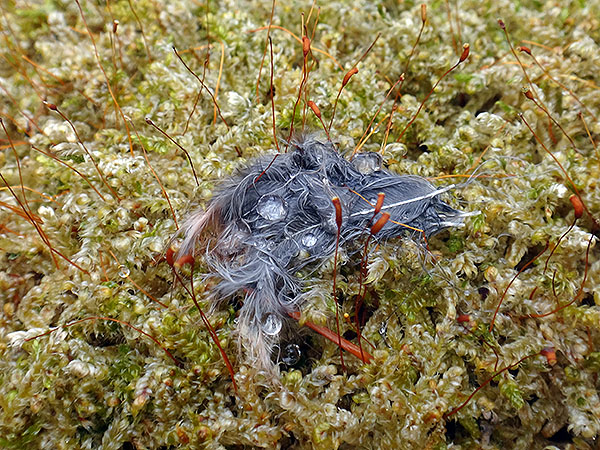
*********************
bearbeitet: 10.04.2022


*********************
bearbeitet: 10.04.2022
Casuariidae
Casuarius lydekkeri Rothschild [1]
Dromaius arleyekweke Yates & Worthy [3]
Dromaius ocypus (Miller) [3]
Emuarius gidju (Patterson & Rich) [2]
Emuarius guljaruba (Boles) [2]
*********************
Quellen:
[1] P. V. Rich; M. Plane; N. Schroeder: A pygmy cassowary (Casuarius lydekkeri) from late Pleistocene bog deposits at Pureni, Papua New Guinea. BMR Journal of Australian Geology and Geophysics 10(4): 377-389. 1988
[2] Walter E. Boles: A new emu (Dromaiinae) from the Late Oligocene Etadunna Formation. Emu 101(4): 317-321. 2001
[3] A. M. Yates; T. E. Worthy: A diminutive species of emu (Casuariidae: Dromaiinae) from the late Miocene of the Northern Territory, Australia. Journal of Vertebrate Paleontology 39(4): 1-15. 2019
*********************
bearbeitet: 10.04.2022
Dieser Vogel lebte in Neuseeland vor 19 bis 16 Millionen Jahren, ist bisher aber nur anhand eines Knochenbruchstücks bekannt.
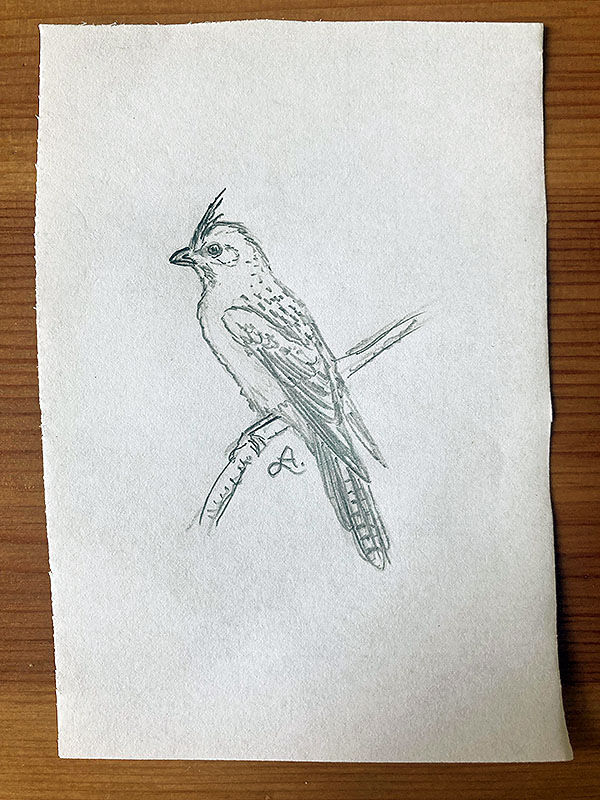
*********************
Quelle:
[1] Trevor H. Worthy; R. Paul Scofield; Steven W. Salisbury; Suzanne J. Hard; Vanesa L. De Pietri; Michael Archer: Two new neoavian taxa with contrasting palaeobiogeographical implications from the early Miocene St Bathans Fauna, New Zealand. Journal of Ornithology http://dx.doi.org/10.1007/s10336-022-01981-6. 2022
*********************
bearbeitet: 08.03.2022
Es ist eine einigermaßen bekannte Tatsache, dass Neuseeland auch heute noch einige Reliktpopulationen ansonsten längst ausgestorbener Lebensformen beherbergt, dies war aber bereits in der Vergangenheit so.
Die fossile Fauna der St Bathans-Fundstelle hat nun eine weitere solche Reliktlinie hervorgebracht, die Familie der “Zealandia-Vögel”, benannt anhand eines distalen Endstücks eines Humerus eines Vogels, der sich keiner bekannten Familie zuordnen lässt (Zealandornis relictus Worthy et al.). [1]
Dieser Vogel dürfte in etwa die Größe eines durchschnittlichen Finken erreicht haben und könnte mit den Mausvögeln verwandt gewesen sein, ohne dabei zu den Mausvögeln selbst zu gehören. Es ist möglich, dass seine Familie gondwanischen Ursprungs ist und in Neuseeland ihr letztes Refugium gefunden hatte, oder, wie etliche andere neuseeländische Vogelformen auch, ursprünglich aus Australien zugewandert ist. Wie so oft gilt auch hier, es sind weitere Funde notwendig um genauere Angaben zum Aussehen und zu den Verwandtschaftsverhältnissen dieser Art/Familie zu machen. [1]
Eine Rekonstruktion ist derzeit nicht wirklich möglich, bzw. wäre rein spekulativ.
*********************
Quelle:
[1] Trevor H. Worthy; R. Paul Scofield; Steven W. Salisbury; Suzanne J. Hard; Vanesa L. De Pietri; Michael Archer: Two new neoavian taxa with contrasting palaeobiogeographical implications from the early Miocene St Bathans Fauna, New Zealand. Journal of Ornithology http://dx.doi.org/10.1007/s10336-022-01981-6. 2022
*********************
bearbeitet: 08.03.2022
Aegothelidae
Aegotheles zealandivetus Worthy et al. [2]
Quipollornis koniberi Rich & McEvey
*********************
Quellen:
[1] Albert Chen; Daniel J. Field: Phylogenetic definitions for Caprimulgimorphae (Aves) and major constituent clades under the International Code of Phylogenetic Nomenclature. Vertebrate Zoology 70(4): 571-585. 2020
[2] Trevor H. Worthy; R. Paul Scofield; Steven W. Salisbury; Suzanne J. Hard; Vanesa L. De Pietri; Michael Archer: Two new neoavian taxa with contrasting palaeobiogeographical implications from the early Miocene St Bathans Fauna, New Zealand. Journal of Ornithology http://dx.doi.org/10.1007/s10336-022-01981-6. 2022
*********************
bearbeitet: 08.03.2022
Douglas J. Futuyma: How Birds evolve: What Science reveals about their Origin, Lives & Diversity. Princeton University Press 2021
*********************
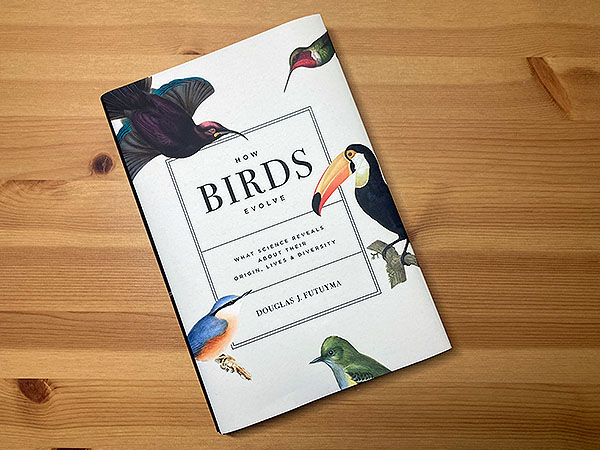
Auf dieses Buch wurde ich durch die Twitter-Beiträge eines Ornithologen aufmerksam, allerdings hätte ich mir den Kauf sparen können, denn es ist dermaßen wissenschaftlich trocken geschrieben, dass man beim Lesen immer wieder einzuschlafen droht.
Für Ornithologen, die sich für statistische Werte, DNA-Gedöhns und derlei Dinge interessieren mag das Buch das Richtige sein, ich selbst habe es (vermutlich, ich bin mir nicht sicher) komplett durchgelesen, und kann mich an nichts davon mehr erinnern.
Besser beraten ist man als normalsterblicher Hobby-Ornithologe, meiner Meinung nach, tatsächlich mit John Reillys “The Ascent of Birds: How modern Science is revealing their Story” aus dem Jahr 2018, welches sich mit derselben Thematik beschäftigt und hierzu tatsächlich oft auch dieselben Beispiele heranzieht, dabei aber durchweg wirklich spannend und interessant geschrieben ist.
Ein kleiner Vermerk noch: digitale Fotos, auf denen durch die Kamera automatisch ein Aufnahmedatum vermerkt ist, sollte man für ein Buch nicht verwenden, so etwas wirkt einfach, nun ja, hässlich.
*********************
bearbeitet: 29.03.2022
Family incertae sedis
Piciformes gen. & sp. ‘Herrlingen, Deutschland’
Pristineanis kistneri (Feduccia) [1]
Pristineanis major Mayr & Kitchener
Pristineanis minor Mayr & Kitchener
Capitonidae
Capitonides europaeus Ballmann
Capitonides protractus Ballmann
Gracilitarsidae
Eutreptodactylus itaboraiensis Baird & Vickers-Rich (?)
Gracilitarsus mirabilis Mayr
Lybiidae
Pogoniolus (?) sp. ‘Kohfidisch, Österreich’
Miopiconidae
Miopico benimellalensis Mayr
Picavidae
Picavus litencicensis Mayr & Gregorova
Picidae
Australopicus nelsonmandelai Manegold & Louchart
Bitumenpicus minimus Campbell & Bochenski [2]
Breacopus garretti Campbell & Bochenski [2]
Dendrocopos major ssp. submajor Jánossy
Leiopicus praemedius (Jánossy)
Melanerpes shawi Campbell & Bochenski [2]
Palaeonerpes shorti Cracraft & Morony
Picus peregrinabundus Umanska
Picus pliocaenicus Kessler
Pliopicus brodkorbi Feduccia & Wilson
Ramphastidae (?)
Rupelramphastoides kopfi Mayr
Sylphornithidae
Jacamatia luberonensis Duhamel, Balme, Legal, Riamon & Louchart [1]
Oligosylphe mourerchauvireae Mayr & Smith
Palaegithalus cuvieri (Gervais)
Sylphornis bretouensis Mourer-Chauviré
*********************
Quellen:
[1] Anaïs Duhamel, Christine Balme, Stéphane Legal, Ségolène Riamon, Antoine Louchart: An early Oligocene stem Galbulae (jacamars and puffbirds) from southern France, and the position of the Paleogene family Sylphornithidae. The Auk 137: 1-11. 2020
[2] Kenneth E. Campbell; Zbigniew M. Bochenski: A review of the woodpeckers (Aves: Piciformes) from the asphalt deposits of Rancho La Brea, California, with the description of three new species. Palaeobiodiversity and Palaeoenvironments 101: 1013-1026. 2021
*********************
bearbeitet: 14.04.2024
Dieses Geschöpf lebte vor etwa 125 Millionen Jahren im heutigen Japan und war noch kein richtiger Vogel im eigentlichen Sinne.
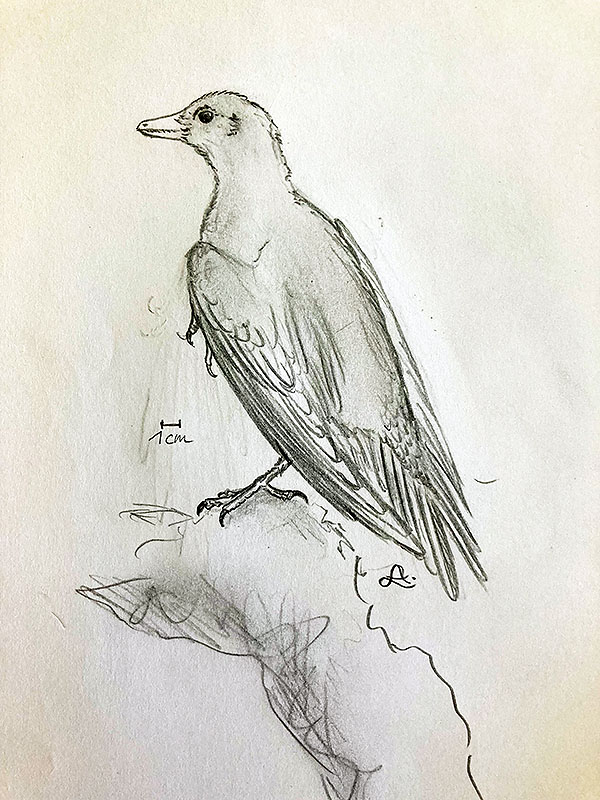
*********************
bearbeitet: 23.03.2022
Aus frühmiozänen (ca. 20 Millionen v.u.Z.) Ablagerungen in Europa, vor allem in Süddeutschland und Österreich sind zahlreiche passerine Vogelformen nachgewiesen, von denen nur wenig Material erhalten geblieben ist.
Leider sind die meisten davon wohl bis jetzt nicht weiter untersucht worden und demnach ist auch nicht näher bekannt, welchen Unterordnungen sie womöglich zuzuordnen sind (aus dem Oligozän, das dem Miozän vorangeht, sind aus Europa nur suboscine Sperlingsvögel (Tyranni) bekannt, die es hier heute überhaupt nicht mehr gibt), deswegen wäre es sehr interessant mehr über all diese fossilen Formen zu erfahren.
Der hier abgebildete Vogel ist nur als “Passerum gen. species A” benannt.
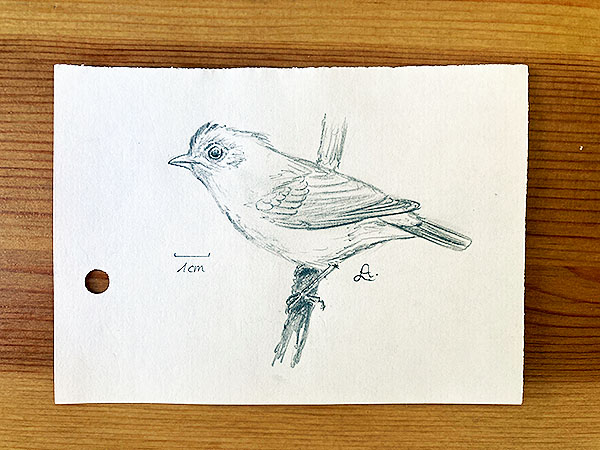
*********************
Quelle:
[1] Peter Ballmann: Die Vögel aus der altburdigalen Spaltenfüllung von Wintershof (West) bei Eichstätt in Bayern. Zitteliana 1: 5-60. 1969
*********************
bearbeitet: 23.03.2022
Family incertae sedis
Cruralispennia multidonta Wang, O’Connor, Pan & Zhou
Eocathyornis walkeri Zhou
Eoenantiornis buhleri Hou, Zhou & Feduccia
Fortunguavis xiaotaizicus Wang, O’Connor & Zhou
Bohaiornithidae
Bohaiornis guoi Hu, Li, Hou & Xu
Parabohaiornis martini Wang, Zhou, O’Connor & Zelenkov
Longusunguis kurochkini Wang, Zhou, O’Connor & Zelenkov
Musivavis amabilis Wang et al. [1]
Shenqiornis mengi Wang, O’Connor, Zhao, Chiappe, Gao & Cheng
Sulcavis geeorum O’Connor, Zhang, Chiappe, Meng, Quanguo & Di
Zhouornis hani Zhang, Chiappe, Han & Chinsamy
Cathayornithidae
Cathayornis yandica Zhou, Jin & Zhang
Houornis caudatus (Hou)
Noguerornis gonzalezi Lasaca-Ruiz
Sinornis santensis Sereno & Rao (?)
Vascornis hebeiensis Zhang, Ericson & Zhou
Longipterygidae
Bolouchia zhengi Zhou
Longipteryx chaoyangensis Zhang, Zhou, Hou & Gu
Longirostravis hani Hou, Chiappe, Zhang, Chuong
Rapaxavis pani Morschhauser, Varricchio, Gao, Liu, Wang, Cheng & Meng
Shanweiniao cooperorum O’Connor, Gao & Chiappe
Shengjingornis yangi Li, Wang, Zhang & Hou
*********************
Quelle:
[1] Xuri Wang; Andrea Cau; Xiaoling Luo; Martin Kundrát; Wensheng Wu; Shubin Ju; Zhen Guo; Yichuan Liu; Qiang Ji: A new Bohaiornithidae-like bird from the Lower Cretaceous of China fills a gap in enanthironithine diversity. Journal of Paleontology 96(1): 1-16. 2022
*********************
bearbeitet: 12.03.2022
***
Hinweis: Diese Ordnung ist vermutlich nicht gültig.
Alexander F. Skutch: Antbirds & Ovenbirds: their lives and homes. University of Texas Press 1996
*********************

Der Autor beschreibt in seinem Buch seine eigenen Beobachtungen an den sogenannten Ameisen- und Töpfervögeln, die mit unzähligen Arten in Südamerika verbreitet sind. Diese Beobachtungen umfassen nahezu alles was man sich vorstellen kann und darüber hinaus vieles mehr.
Das Buch ist reichlich mit sehr schönen Schwarz-Weiß-Zeichnungen bebildert, die einige der zahlreichen Arten abbilden.
Das Ganze ist manchmal allerdings ein wenig langatmig, besonders wenn der Autor sich in allzu kleinlichen Details ergeht; und die Tatsache, dass er immer wieder nonchalant über seine Neststörungen schreibt (… Eier und Jungvögel aus dem Nest nehmen bzw. brütende Vögel vom Nest verscheuchen um hineinzuschauen …) ist für mich persönlich etwas befremdlich.
Davon abgesehen kann ich dieses Buch jedoch wärmstens empfehlen.
*********************
bearbeitet: 09.03.2022
ausnahmsweise mal kein Vogel …
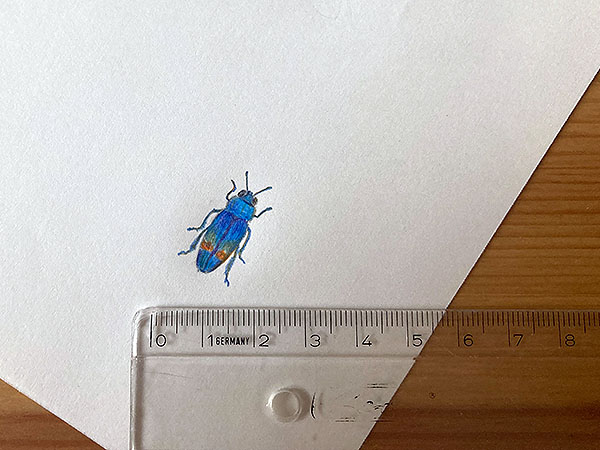
*********************
bearbeitet: 06.03.2022
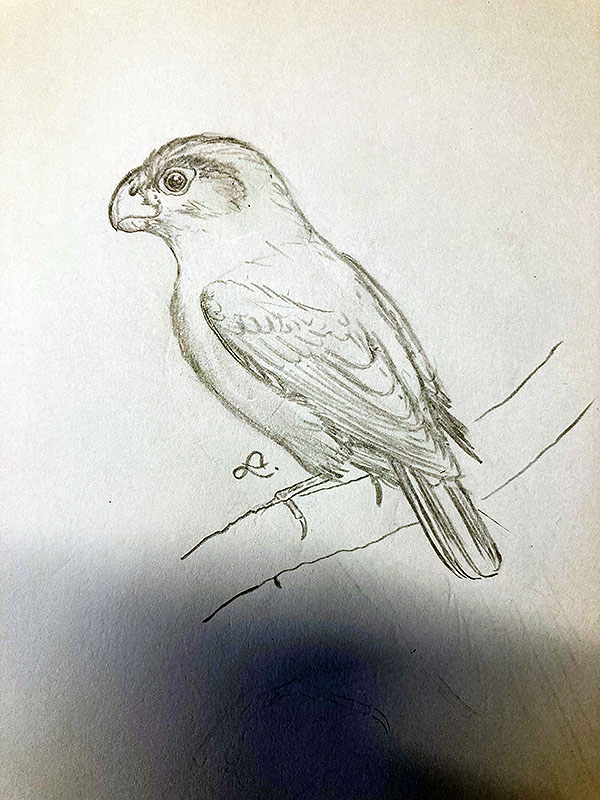
*********************
bearbeitet: 06.03.2022

*********************
bearbeitet: 06.03.2022
Diese Art stammt aus dem oberen Eozän Europas und ist der älteste bislang bekannte Vertreter seiner Familie, die heute nur noch mit fünf Arten in der Karibik verbreitet ist.
Die eozäne Form erreichte eine Größe von nur etwa 10 cm und ähnelte somit wohl sehr den rezenten Todi-Arten. [1]
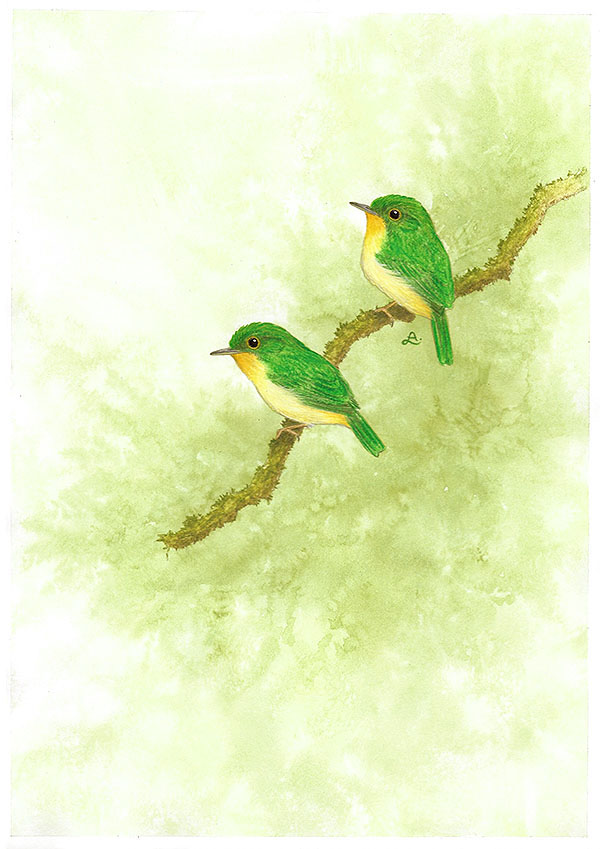
*********************
Quelle:
[1] Gerald Mayr; Norbert Micklich: New specimens of the avian taxa Eurotrochilus (Trochilidae) and Palaeotodus (Todidae) from the early Oligocene of Germany. Paläontologische Zeitschrift 84: 387-395. 2010
*********************
bearbeitet: 04.03.2022
*********************
bearbeitet: 25.02.2022
Schöner Todi (Todus pulcherrimus Sharpe)
Von dieser ‘Art’, beschrieben im Jahr 1874, habe ich gestern überhaupt zum allerersten Mal gehört, sie ist offenbar nur anhand eines einzigen Exemplars bekannt, dessen Herkunft nicht gesichert zu sein scheint.:
“Hab. Jamaica [?]” [1]
Dieses eine Exemplar befindet sich offenbar im British Museum in London, Großbritannien und unterscheidet sich von allen bekannten Todi-Arten durch die eher bläulich als grün gefärbten Oberseite sowie die kräftig gefärbte Unterseite (siehe Darstellung).
***
Bei diesem mysteriösen Vogel soll es sich aber um einen aberrant gefärbten Breitschnabeltodi (Todus subulatus Gray) handeln, einer Art, die von der Insel Hispaniola stammt.
*********************
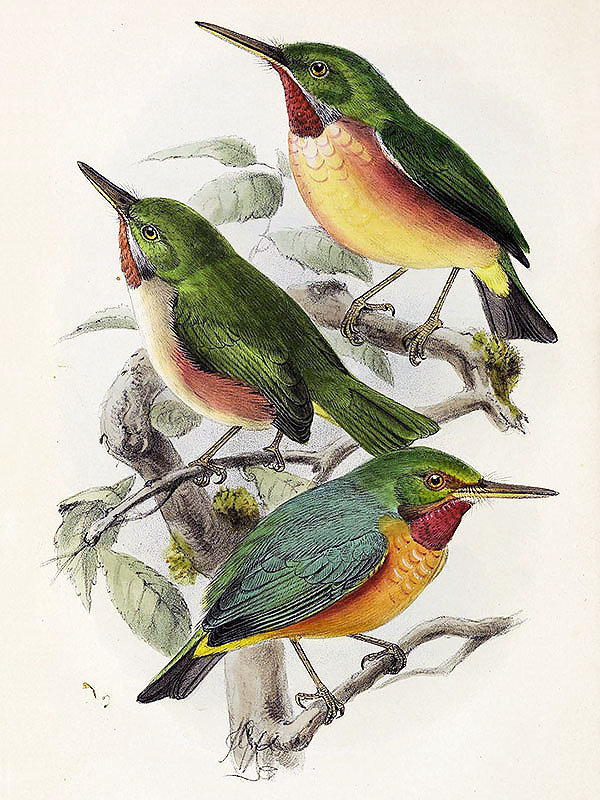
*********************
Quelle:
[1] R. Bowdler Sharpe: On the genus Todus. The Ibis 3(4): 344-355. 1874
*********************
bearbeitet: 18.02.2022
Das Paläozän, das ist die Zeitperiode die unmittelbar der Kreidezeit folgt, deren Ende durch das berühmteste Massenaussterben der Erdgeschichte gekennzeichnet ist, jenes Massenaussterben dem auch sämtliche non-avialen Dinosaurier zum Opfer fielen.
***
Nun, was wissen wir über die Vogelwelt dieser Zeitperiode? NICHTS! Nun ja, zumindest recht wenig.
Ich nenne das Paläozän ‚das verfluchte Zeitalter‘ da, wenngleich sehr wohl einige Überreste von Vögeln bekannt sind, so sind diese nahezu immer sehr fragmentarisch, sehr schlecht erhalten und oft genug nicht wirklich aussagekräftig … und, obendrein scheint es nahezu unmöglich zu sein irgendwelche Informationen über diese wenigen Reste zu finden.
Die meisten Vögel, die wir aus dieser Zeitperiode kennen waren wasserbewohnende Arten, das liegt vor allem daran, dass Überreste von Wasservögeln bessere Voraussetzungen zur Fossilisierung haben als Landvögel.
***
So, welche Arten kennen wir denn nun überhaupt?
Hier eine kleine Aufzählung aller mir bekannten Formen, der Einfachheit halber habe ich sie in alphabetischer Reihenfolge angeordnet.:
Anseriformes (Gänsevögel)
Conflicto antarcticus Tambussi et al.
Naranbulagornis khun Zelenkov
Presbyornis isoni Olson
Cariamaformes (Seriemaartige)
Gradiornis walbeckensis Mayr
Itaboravis elaphrocnemoides Mayr et al.
Paleopsilopterus itaboraiensis Alvarenga
cf. Cariamaformes gen. & sp. ‚Templeuve, Frankreich‘
eine rätselhafte Form aus China, Qianshanornis rapax Mayr et al., gehört wohl auch hier her
cf. Charadriformes (Regenpfeiferartige)
drei sehr rätselhafte Formen, die entlang der K/T-Grenze gelebt haben:
Graculavus augustus Hope
Palaeotringa littoralis Marsh
Palaeotringa vagans Marsh
Coliiformes (Mausvögel)
Tsidiiyazhi abini Ksepka et al.
eine bislang nicht beschriebene Form, MNT-11-7952 ‚Menat, Frankreich‘, erscheint mir persönlich ebenfalls sehr mausvogelartig
Gaviiformes (Seetaucher)
cf. Colymbiculus sp. ‚Templeuve, Frankreich‘
Gastornithiformes (ausgestorbene Familie)
Gastornis russelli Martin
Gastornis sp. ‚Louvois, Frankreich‘, [2016]
Gastornis sp. ‚Maret, Belgien‘
Gruiformes (Kranichvögel)
Walbeckornis creber Mayr
Wanshuina lii Hou
cf. Ralloidea gen. & sp. ‚Maret, Belgien‘
cf. Songziidae gen. & sp. ‚Menat, Frankreich‘
Leptosomatiformes (Kurole)
cf. Leptosomatiformes gen. & sp. ‚Templeuve, Frankreich‘
Lithornithiformes (ausgestorbene Familie):
Fissuravis weigelti Mayr
Lithornis celetius Houde
Lithornithidae gen. & sp. ‚Maret, Belgien‘
Lithornithidae gen. & sp. ‚Templeuve, Frankreich‘
Odontopterygiformes (ausgestorbene Familie)
Pelagornithidae gen. & sp. ‚Templeuve, Frankreich‘
Phaethornithiformes (Tropikvögel)
Lithoptila abdounensis Bourdon, E. et al.
Novacaesareala hungerfordi Parris & Hope
sowie mindestens eine bislang noch unbeschriebe Form aus Neuseeland
Procellariiformes (Röhrennasen)
Tytthostonyx glauconiticus Olson & Parris (?)
Psittaciformes (Papageienvögel)
Calcardea junnei Gingerich
Halcyornithidae/Messelasturidae gen. & sp. ‚Menat, Frankreich‘
Sphenisciformes (Pinguine)
Crossvallia unienwillia Tambussi et al.
Kumimanu biceae Mayr
Kupoupou stilwelli Blokland, Reid, Worthy, Tennyson, Clarke & Scofield
Muriwaimanu tuatahi Ando, Jones & Fordyce
Sequiwaimanu rosieae Mayr et al.
Waimanu manneringi Slack, Jones, Ando, Harrison, Fordyce, Arnason & Penny
Strigiformes (Eulenvögel)
Berruornis orbisantiqui Mourer-Chauviré
Ogygoptynx wetmorei Rich & Bohaska
cf. Struthioniformes (Strauße)
Remiornis heberti Lemoine
Vegaviiformes (ausgestorbene Familie)
Australornis lovei Mayr & Scofield
***
Zum Schluß folgt noch der seltsamste Vogel in dieser Liste, und einer der am wenigsten bekannten.:
Qinornis paleocenica Xue aus China scheint ein Überbleibsel der kreidezeitlichen non-Neornithes zu sein und würde damit außerhalb aller noch existierenden Vogelarten stehen, da diese durchweg zu den Neornithes gehören.
***
Nach einigen Recherchen habe ich herausgefunden das der angebliche Flamingoverwandte Scaniornis lundgreni Dames nur anhand von drei Knochenteilen bekannt ist, die nicht wirklich irgendeiner Vogelgruppe zugeordnet werden können und daher mittlerweile als nomen dubium gelten. Der fossile Nandu Diogenornis fragilis Alvarenga sowie der spechtartige Eutreptodactylus itaboraiensis Baird & Vickers-Rich stammen nicht aus dem Paläozän sondern aus dem Untereozän, ich habe die Arten daher aus der Auflistung entfernt. [5]
*********************
Quellen:
[1] Cécile Mourer-Chauviré; Estelle Bourdon: The Gastornis (Aves, Gastornithidae) from the Late Paleocene of Louvois (Marne, France). Swiss Journal of Palaeontology 135(2): 327-341. 2016
[2] Jacob C. Blokland; Catherine M. Reid; Trevor H. Worthy; Alan J. D. Tennyson; Julia A. Clarke & R. Paul Scofield: Chatham Island Paleocene fossils provide insight into the palaeobiology, evolution, and diversity of early penguins (Aves, Sphenisciformes). Palaeontologia Electronica 22.3.78: 1-92. 2019
[3] Gerald Mayr; Thierry Smith: New Paleocene bird from the North Sea Basin in Belgium and france. Geologica Belgica 22(1-2): 35-46. 2019
[4] Gerald Mayr; Sophie Hervet; Eric Buffetaut: On the diverse and widely ignored Paleocene avifauna of Menat (Puy-de-Dôme, France): new taxonomic records and unusual soft tissue preservation. Geological Magazine 156(03): 1-13. 2019
[5] Mariana B. J. Picasso; Carolina Acosta Hospitaleche; María C. Mosto: An overview and update of South American and Antarctic fossil Rheidae and putative Ratitae (Aves, Palaeognathae). Journal of South American Earth Sciences. https://doi.org/10.1016/j.jsames.2022.103731. 2022
*********************
bearbeitet: 11.02.2022
Nach dem letzten, neuesten und BESTESTESTEN update EVER!!! kann ich nun offenbar die Textfarben nicht mehr ohne weiteres ändern … ich hasse WordPress!!! Mit jedem dieser Kack-Updates wird irgendein Mist verschlimmbessert, ich hab’s so satt!
Ich habe nur leider immer noch keine verschissene Alternative gefunden, Dreck verdammter!
Momentan ist dies nur eine Skizze, ich denke ich werde noch etwas am Hintergrund arbeiten und eventuell die Haltung des Vogels noch etwas ändern.
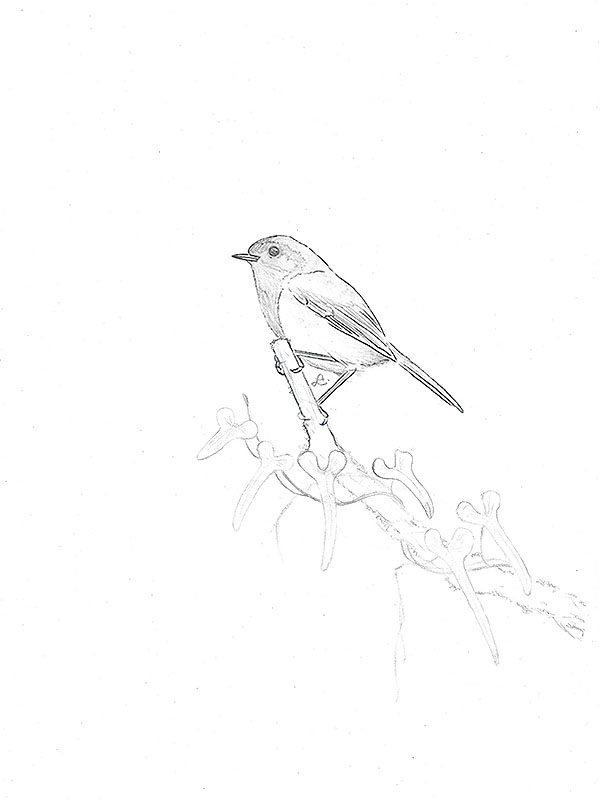
*********************
bearbeitet: 01.02.2022
Rapa-Ralle (Gallirallus astolfoi Salvador, Anderson & Tennyson)
Rapa, nicht etwa Rapa Nui, die Osterinsel, sondern nur Rapa, manchmal auch Rapa Iti genannt, ist für mich persönlich einer jener Orte, mit dem ich Begriffe wie geheimnisvoll oder rätselhaft verbinde.
Von dieser Insel stammen einige subfossile Knochen, die in antiken ‘Küchen’abfällen gefunden wurden, darunter waren die Knochen dieser Ralle, aber auch einige andere, die zu einem Sittich (Cyanoramphus sp.) und zu einer Taube (Ducula sp.) gehören.
Zumindest die Ralle wurde nun beschrieben, sie gehört zu einer gigantischen Radiation einer einzigen Gattung, die allein im polynesischen Dreieck vermutlich mehrere hundert Arten umfasst hat, die alle bis auf eine einzige, die neuseeländische Weka (Gallirallus australis (Sparrman)), ausgerottet wurden! [1][2][3]
*********************
Quellen:
[1] David W. Steadman: Extinction and Biogeography of Tropical Pacific Birds. University of Chicago Press 2006
[2] J. D. Tennyson; Atholl Anderson: Bird, reptile and mammal remains from archaeological sites on Rapa Island. In: Atholl Anderson; Douglas J. Kennett: Taking the High Ground; The archaeology of Rapa, a fortified island in remote East Polynesia. In: Terra Australis 37. 105-114. Canberra, ANU E Press 2012
[3] Rodrigo B. Salvador; Atholl Anderson; Alan J. D. Tennyson: An extinct new rail (Gallirallus, Aves: Rallidae) species from Rapa Island, French Polynesia. Taxonomy 1: 448-457. 2021
*********************
bearbeitet: 09.01.2022
… eine Liste (in alphabetischer Reihenfolge) der 902 Arten und Unterarten von Brutvögeln innerhalb des polynesischen Dreiecks, einschließlich Fidschi, Macquarie Island, den Norfolk-Inseln sowie Motu Motiro Hiva (Sala y Gómez).
Ausgestorbene Formen sind fett geschrieben.
***
Acanthisittidae (endemische Familie)
Acanthisitta chloris ssp. chloris
Acanthisitta chloris ssp. granti
Dendroscansor decurvirostris
Xenicus gilviventris
Xenicus longipes ssp. longipes
Xenicus longipes ssp. stokesii
Xenicus longipes ssp. variabilis
Xenicus lyalli
Xenicus yaldwyni ssp. jagmi
Xenicus yaldwyni ssp. yaldwyni
Acanthizidae
Gerygone albofrontata
Gerygone igata
Gerygone modesta
Accipitridae
Accipiter fasciatus ssp. ?
Accipiter rufitorques
Aquila moorei
Buteo solitarius
Circus approximans
Circus dossenus
Circus teauteensis
Haliaeetus sp. ‘Hawaiian Islands’
Acrocephalidae
Acrocephalus aequinoctialis ssp. aequinoctialis
Acrocephalus aequinoctialis ssp. ‘pistor’
Acrocephalus aequinoctialis ssp. pistor ‘Tabuaeran’
Acrocephalus astrolabii
Acrocephalus atyphus ssp. atyphus
Acrocephalus atyphus ssp. niauensis
Acrocephalus atyphus ssp. palmarum
Acrocephalus caffer
Acrocephalus eremus
Acrocephalus familiaris ssp. familiaris
Acrocephalus familiaris ssp. kingi
Acrocephalus kerearako ssp. kaoko
Acrocephalus kerearako ssp. kerearako
Acrocephalus longirostris
Acrocephalus mendanae ssp. consobrinus
Acrocephalus mendanae ssp. dido
Acrocephalus mendanae ssp. fatuhivae
Acrocephalus mendanae ssp. mendanae
Acrocephalus musae ssp. garetti
Acrocephalus musae ssp. musae
Acrocephalus percernis ssp. aquilonis
Acrocephalus percernis ssp. idae
Acrocephalus percernis ssp. percenis
Acrocephalus percernis ssp. prostremus
Acrocephalus rimatarae
Acrocephalus sp. ‘Raivavae’
Acrocephalus taiti
Acrocephalus vaughani
Aegothelidae
Aegotheles novaezealandiae
Alcedinidae
Todiramphus chloris ssp. eximia
Todiramphus chloris ssp. marina
Todiramphus chloris ssp. regina
Todiramphus chloris ssp. sacra
Todiramphus chloris ssp. vitiensis
Todiramphus gambieri
Todiramphus gertrudae
Todiramphus godeffroyi
Todiramphus pealei ssp. manuae
Todiramphus pealei ssp. pealei
Todiramphus recurvirostris
Todiramphus ruficollaris
Todiramphus sanctus ssp. norfolkiensis
Todiramphus sanctus ssp. vagans
Todiramphus sp. ‘Rapa’
Todiramphus sp. ‘Rarotonga’
Todiramphus tutus ssp. atiu
Todiramphus tutus ssp. mauke
Todiramphus tutus ssp. tutus
Todiramphus venerates
Todiramphus youngi
Anatidae
Anas acuta (ssp. modesta) [C.N.1943]
Anas aucklandica
Anas chathamica
Anas chlorotis ssp.’Chatham Islands’
Anas chlorotis ssp. chlorotis
Anas gracilis
Anas laysanensis
Anas nesiotis
Anas rhynchotis ssp. variegata
Anas sp. ‘Macquarie’
Anas sp. ‘Viti Levu’
Anas superciliosa
Anas wyvilliana
Anatidae gen. & sp. ‘Large Hawai’i Goose’
Anatidae gen. & sp. ‘Supernumerary O’ahu Goose’
Aythya australis
Aythya novaeseelandiae
Biziura delautouri
Branta aff. hylobadistes ‘Kaua’i’
Branta aff. hylobadistes ‘O’ahu’
Branta hylobadistes
Branta rhuax
Branta sandvicensis
Chelychelynechen quassus
Chenonetta finschi
Chenonetta jubata [W.A.C.2016]
Cnemiornis calcitrans
Cnemiornis gracilis
Cygnus atratus ssp. atratus (?)
Cygnus sumnerensis ssp. chathamensis
Cygnus sumnerensis ssp. sumnerensis
Dendrocygna arcuata ssp. pygmaea
Dendrocygna sp. ‘Aitutaki’
Hymenolaimus malacorhynchus
Malacorhynchus scarletti
Mareca strepera ssp. couesi
Mergus australis
Mergus milleneri
Mergus sp. ‘New Zealand’
Oxyura vantetsi
Ptaiochen pau
Tadorna sp. ‘Chatham Islands’
Tadorna sp. ‘Kaua’i’
Tadorna tadornoides
Tadorna variegata
Talpanas lippa
Thambetochen chaulidous
Thambetochen xanion
Apodidae
Aerodramus leucophaeus
Aerodramus manuoi
Aerodramus ocistus ssp. gilliardi
Aerodramus ocistus ssp. ocistus
Aerodramus sawtelli
Aerodramus spodiopygius ssp. assimilis
Aerodramus spodiopygius ssp. spodiopygius
Aerodramus spodiopygius ssp. townsendi
Apterygidae (endemische Familie)
Apteryx australis ssp. ‘Haast’
Apteryx australis ssp. ‘Mt. Cookson’
Apteryx australis ssp. ‘Mt. Somers’
Apteryx australis ssp. ‘North Fiordland’
Apteryx australis ssp. ‘South Fiordland’
Apteryx australis ssp. ‘Stewart Island’
Apteryx maxima [L.D.S.2021]
Apteryx mantelli ssp. ‘Coromandel’
Apteryx mantelli ssp. ‘Eastern’
Apteryx mantelli ssp. ‘North Island’
Apteryx mantelli ssp. ‘Taranaki’
Apteryx owenii ssp. ‘North Island 1’
Apteryx owenii ssp. ‘North Island 2’
Apteryx owenii ssp. ‘South Island’
Apteryx rowi ssp. ‘North Island’
Apteryx rowi ssp. ‘Okarito’
Apteryx rowi ssp. ‘Tasman’
Apteryx sp. ‘South Island’
Aptornithidae (endemische Familie)
Aptornis defossor
Aptornis otodiformis
Ardeidae
Ardea modesta
Ardea novaehollandiae
Ardeidae gen. & sp. ‘Rapa Nui’
Botaurus poiciloptilus
Butorides striata ssp. diminuta
Butorides striata ssp. patruelis
Egretta sacra
Ixobrychus novaezelandiae
Nycticorax caledonicus ssp. australasiae
Nycticorax caledonicus ssp. ‘Fiji’
Nycticorax kalavikai
Nycticorax nycticorax ssp. hoactli
Nycticorax sp. ”Eua’
Nycticorax sp. ‘Lifuka’
Nycticorax sp. ‘Mangaia’
Artamidae
Artamus mentalis
Artamus personatus
Callaeidae (endemische Familie)
Callaeas cinereus
Callaeas wilsoni
Heteralocha acutirostris
Philesturnus carunculatus
Philesturnus rufusater
Campephagidae
Lalage leucopyga ssp. leucopyga
Lalage maculosa ssp. futunae
Lalage maculosa ssp. keppeli
Lalage maculosa ssp. maculosa
Lalage maculosa ssp. mixta
Lalage maculosa ssp. nesophila
Lalage maculosa ssp. pumila
Lalage maculosa ssp. rotumae
Lalage maculosa ssp. tabuensis
Lalage maculosa ssp. vauana
Lalage maculosa ssp. whitmeei
Lalage maculosa ssp. woodi
Lalage sharpei ssp. sharpei
Lalage sharpei ssp. tenebrosa
Lalage sp. ‘Tonga’
Cettiidae
Horornis ruficapilla ssp. badiceps
Horornis ruficapilla ssp. castaneoptera
Horornis ruficapilla ssp. funebris
Horornis ruficapilla ssp. ruficapilla
Horornis sp.”Eua’
Charadriidae
Anarhynchus frontalis
Charadrius aquilonius
Charadrius bicinctus ssp. bicinctus
Charadrius bicinctus ssp. exilis
Charadrius melanops
Charadrius obscurus
Charadrius ruficapillus
Haematopus chathamensis
Haematopus finschi
Haematopus unicolor
Himatopus himatopus ssp. leucocephalus
Himatopus knudseni
Himatopus novaezelandiae
Thinornis novaeseelandiae
Vanellus novaehollandiae
Columbidae
Bountyphaps obsoleta
Caloenas canacorum
Caloenas maculata (?) [P.R.2020]
Caloenas sp. ‘Tonga’ [S.H.2019]
Chalcophaps indica ssp. rogersi
Columba vitiensis ssp. castaneiceps
Columba vitiensis ssp. ‘Tonga’
Columba vitiensis ssp. vitiensis
Columbidae gen. & sp. ‘Kamaka’
Didunculus placopedetes
Didunculus strigirostris
Ducula aurorae
Ducula david
Ducula galeata
Ducula harrisoni
Ducula lakeba
Ducula latrans
Ducula pacifica
Ducula shutleri [S.H.2019]
Ducula sp. ‘Rapa’
Ducula sp. ‘Viti Levu’
Ducula tihonireasini
Hemiphaga chathamensis
Hemiphaga novaeseelandiae
Hemiphaga spadicea
Macropygia arevarevauupa
Macropygia heana
Natunaornis gigoura
Pampusana erythropterus [M.B.2016]
Pampusana leonpascoi [M.B.2016]
Pampusana norfolciensis [M.B.2016]
Pampusana nui [M.B.2016]
Pampusana rubescens [M.B.2016]
Pampusana sp. ‘Karoraina’ [F.D.B.1840]
Pampusana sp. 1 ‘Rurutu’ [M.B.2016]
Pampusana sp. 2 ‘Rurutu’ [M.B.2016]
Pampusana sp. ‘Tubuai’ [M.B.20165]
Pampusana stairi ssp. stairi [M.B.2016]
Pampusana stairi ssp. vitiensis [M.B.2016]
Ptilinopus chalcurus
Ptilinopus chrysogaster
Ptilinopus coralensis
Ptilinopus dupetithouarsii ssp. dupetithouarsii
Ptilinopus dupetithouarsii ssp. viridior
Ptilinopus goodwinii ssp. ‘Aitutaki’
Ptilinopus goodwinii ssp. byronensis
Ptilinopus goodwinii ssp. goodwinii
Ptilinopus huttoni
Ptilinopus insularis
Ptilinopus layardi
Ptilinopus luteovirens
Ptilinopus mercierii ssp. mercierii
Ptilinopus mercierii ssp. tristramii
Ptilinopus perousii ssp. mariae
Ptilinopus perousii ssp. perousii
Ptilinopus porphyraceus ssp. fasciatus
Ptilinopus porphyraceus ssp. graeffei
Ptilinopus porphyraceus ssp. porphyraceus
Ptilinopus purpuratus ssp. frater
Ptilinopus purpuratus ssp. purpuratus
Ptilinopus rarotongensis
Ptilinopus sp. ‘Lakeba’
Ptilinopus sp. ‘Mangaia’
Ptilinopus sp. ‘Tubuai’
Ptilinopus victor ssp. aureus
Ptilinopus victor ssp. victor
Tongoenas burleyi [D.W.S.2020]
Corvidae
Corvus antipodum ssp. antipodum
Corvus antipodum ssp. pycrofti
Corvus hawaiiensis
Corvus impluviatus
Corvus moriorum
Corvus sp. ‘Hawai’i 1’
Corvus sp. ‘Hawai’i 2’
Corvus sp. ‘Maui’
Corvus viriosus
Cuculidae
Cacomantis flabelliformis ssp. ‘Tonga’
Cacomantis flabelliformis ssp. simus
Chrysococcyx lucidus
Urodynamis taitensis
Dinornithidae (endemische Familie)
Dinornis novaezealandiae
Dinornis robustus
Diomedeidae
Diomedea antipodensis ssp. antipodensis
Diomedea antipodensis ssp. gibsoni
Diomedea epomophora
Diomedea exulans
Diomedea sanfordi
Diomedea sp. ‘Rapa Nui’
Phoebastria albatrus
Phoebastria immutabilis
Phoebastria nigripes
Phoebetria palpebrata
Thalassarche bulleri ssp. bulleri
Thalassarche bulleri ssp. platei
Thalassarche chrysostoma
Thalassarche eremita
Thalassarche impavida
Thalassarche melanophris
Thalassarche salvini
Thalassarche steadi
Emeidae (endemische Familie)
Anomalapteryx didiformis
Emeus crassus
Euryapteryx curtus
Euryapteryx geranoides
Pachyornis australis
Pachyornis elephantopus
Pachyornis mappini
Estrildidae
Erythrura cyaneovirens
Erythrura kleinschmidti
Erythrura pealii
Falconidae
Falco cenchroides
Falco novaeseelandiae
Falco peregrinus ssp. nesiotes
Fregatidae
Fregata ariel
Fregata minor ssp. palmerstoni
Fringillidae
Aidemedia chascax
Aidemedia lutetiae
Aidemedia zanclops
Chloridops kona
Chloridops regiskongi
Chloridops sp. ‘Kaua’i’
Chloridops sp. ‘Maui’
Chloridops wahi
Ciridops anna
Ciridops sp. ‘O’ahu’
Ciridops tenax
Drepanidinae gen. & sp. ‘Unassigned Maui Finch’
Drepanis coccinea
Drepanis funerea
Drepanis pacifica
Dysmorodrepanis munroi
Hemignathus affinis
Hemignathus ellisianus
Hemignathus flavus
Hemignathus hanapepe
Hemignathus kauaiensis
Hemignathus lanaiensis
Hemignathus lucidus
Hemignathus munroi
Hemignathus obscurus
Hemignathus sagittirostris
Hemignathus sp. ‘Hawai’i’
Hemignathus sp. ‘Hawai’i Nukupu’u’
Hemignathus sp. ‘Maui’
Hemignathus stejnegeri
Hemignathus upupirostris
Hemignathus virens ssp. virens
Hemignathus virens ssp. wilsoni
Hemignathus vorpalis
Himatione freethi
Himatione sanguinea
Himatione sp. cf. sanguinea
Loxioides bailleui
Loxioides kikuchi
Loxioides sp. ‘Hawai’i’
Loxops caeruleirostris
Loxops coccineus
Loxops ochraceus
Loxops wolstenholmei
Magumma parva
Manucerthia mana
Melamprosops phaeosoma
Oreomystis bairdi
Orthiospiza howarthi
Palmeria dolei
Paroreomyza flammea
Paroreomyza maculata
Paroreomyza montana ssp. montana
Paroreomyza montana ssp. newtoni
Pseudonestor xanthophrys
Psittirostra psittacea
Psittirostra sp. ‘O’ahu’
aff. Psittirostra sp. ‘Additional Kauai Finch’ [S.L.O. 1991]
Rhodacanthis flaviceps
Rhodacanthis forfex
Rhodacanthis litotes
Rhodacanthis palmeri
Rhodacanthis sp. ‘O’ahu’ [H.F.J. 2005]
Telespiza aff. ypsilon ‘Maui’
Telespiza cantans
Telespiza persecutrix
Telespiza sp. ‘Hawai’i’
Telespiza ultima
Telespiza ypsilon
Vangulifer mirandus
Vangulifer neophasis
Xestospiza conica
Xestospiza fastigialis
Hirundinidae
Hirundo javanica ssp. subfusca
Hirundo neoxena
Hirundo sp. ‘Henderson Island’
Hirundo tahitica
Petrochelidon ariel
Hydrobatidae
Oceanodroma castro ssp. cryptoleucura
Oceanodroma tristrami
Lamproliidae
Lamprolia klinesmithi
Lamprolia victoriae
Laridae
Catharacta lonnbergii
Larus bulleri
Larus dominicanus
Larus scopulinus
Larus sp. ‘Kaua’i’
Larus utunui
Locustellidae
Megalurulus rufa ssp. cluniei
Megalurulus rufa ssp. rufa
Poodytes caudatus
Poodytes punctatus ssp. punctatus
Poodytes punctatus ssp. stewartiana
Poodytes punctatus ssp. vealeae
Poodytes punctatus ssp. wilsoni
Poodytes rufescens
Megalapterygidae (endemische Familie)
Megalapteryx didinus
Megapodiidae
Megapodiidae gen. & sp. ‘Tongatapu’
Megapodius alimentum
Megapodius amissus
Megapodius molistructor
Megapodius pritchardii ssp. ‘Niue’
Megapodius pritchardii ssp. pritchardii
Megapodius sp. ‘Lau Islands’
Megapodius sp. ‘Ofu’
Megapodius sp. ‘Raoul Island’
Megapodius sp. ‘small’
Meliphagidae
Anthornis melanocephala
Anthornis melanura ssp. melanura
Anthornis melanura ssp. obscura
Anthornis melanura ssp. oneho
Foulehaio carunculatus
Foulehaio procerior
Foulehaio taviunensis
Gymnomyza brunneirostris
Gymnomyza samoensis
Gymnomyza viridis
Myzomela chermesina
Myzomela jugularis
Myzomela nigriventris
Myzomela sp. ‘Tonga’
Prosthemadera novaeseelandiae ssp. chathamensis
Prosthemadera novaeseelandiae ssp. novaeseelandiae
Xanthotis provocator
Mohoidae (endemische Familie)
Chaetoptila angustipluma
Chaetoptila sp. ‘Maui Nui’
Chaetoptila sp. ‘narrow-billed’
Chaetoptila sp. ‘O’ahu’
Moho apicalis
Moho bishop
Moho braccatus
Moho nobilis
Moho sp. ‘Maui’
Mohouidae (endemische Familie)
Mohoua albicilla
Mohoua novaeseelandiae
Mohoua ochrocephala
Monarchidae
Monarcha dimidiata
Monarcha fluxus
Monarcha fortunae
Monarcha gambieranus
Monarcha heinei
Monarcha ibidis
Monarcha iphis
Monarcha keppeli
Monarcha lessoni ssp. lessoni
Monarcha lessoni ssp. orientalis
Monarcha mendozae ssp. mendozae
Monarcha mendozae ssp. motanensis
Monarcha mirus
Monarcha niger
Monarcha nigrogularis
Monarcha nukuhivae
Monarcha pomareus
Monarcha powelli
Monarcha sandwichensis (incl. ssp. bryani and ssp. ridgwayi)
Monarcha sclateri
Monarcha versicolor
Monarcha vitiensis ssp. buensis
Monarcha vitiensis ssp. compressirostris
Monarcha vitiensis ssp. layardi
Monarcha vitiensis ssp. nesiotes
Monarcha vitiensis ssp. pontifex
Monarcha vitiensis ssp. vatuanus
Monarcha vitiensis ssp. vitiensis
Monarcha vitiensis ssp. wiglesworthi
Monarcha whitneyi
Myiagra albiventris
Myiagra azureocapilla
Myiagra castaneigularis ssp. castaneigularis
Myiagra castaneigularis ssp. whitney
Myiagra sp. ”Eua’
Myiagra vanikorensis ssp. dorsalis
Myiagra vanikorensis ssp. kandavensis
Myiagra vanikorensis ssp. rufiventris
Myiagra vanikorensis ssp. townsendi
Motacillidae
Anthus novaeseelandiae ssp. aucklandicus
Anthus novaeseelandiae ssp. chathamensis
Anthus novaeseelandiae ssp. novaeseelandia
Anthus novaeseelandiae ssp. steindachneri
Nestoridae (endemische Familie)
Nestor chathamensis
Nestor meridionalis ssp. meridionalis
Nestor meridionalis ssp. septentrionalis
Nestor notabilis
Nestor productus
Strigops habroptila
Notiomystidae (endemische Familie)
Notiomystis cincta
Oceanitidae
Fregetta grallaria ssp. ?
Fregetta grallaria ssp. grallaria
Fregetta maoriana
Fregetta sp. ‘Marquesas’ ? [A.C.2015]
Fregetta titan
Fregetta tropica
Garrodia nereis
Nesofregetta fuliginosa
Pelagodroma marina ssp. albiclunis
Pelagodroma marina ssp. maoriana
Oriolidae
Turnagra capensis ssp. capensis
Turnagra capensis ssp. minor
Turnagra tanagra
Pachycephalidae
Pachycephala flavifrons
Pachycephala graeffei ssp. ambigua
Pachycephala graeffei ssp. aurantiiventris
Pachycephala graeffei ssp. bella
Pachycephala graeffei ssp. graeffei
Pachycephala graeffei ssp. koroana
Pachycephala graeffei ssp. optata
Pachycephala graeffei ssp. torquata
Pachycephala jacquinoti
Pachycephala pectoralis ssp. xanthoprocta
Pachycephala vitiensis ssp. kandavensis
Pachycephala vitiensis ssp. lauana
Pachycephala vitiensis ssp. vitiensis
Pandionidae
Pandion cristatus (ssp. ?)
Pelecanoididae
Pelecanoides urinatrix ssp. chathamensis
Pelecanoides urinatrix ssp. exsul
Pelecanoides urinatrix ssp. urinatrix
Pelecanoides whenuahouensis
Petroicidae
Petroica australis ssp. australis
Petroica australis ssp. rakiura
Petroica chathamensis
Petroica dannefaerdi
Petroica longipes
Petroica macrocephala
Petroica marrineri
Petroica multicolor ssp. multicolor
Petroica pusilla ssp. ‘Ha’apai Islands’
Petroica pusilla ssp. becki
Petroica pusilla ssp. kleinschmidti
Petroica pusilla ssp. pusilla
Petroica pusilla ssp. taveunensis
Petroica toitoi
Petroica traversi
Phaethontidae
Phaethon lepturus ssp. dorotheae
Phaethon rubricauda ssp. roseotinctus
Phaethon rubricauda ssp. rothschildi
Phaethon rubricauda ssp. rubricauda
Phalacrocoracidae
Leucocarbo campbelli
Leucocarbo carunculata
Leucocarbo chalconotus
Leucocarbo colensoi
Leucocarbo featherstoni
Leucocarbo onslowi
Leucocarbo punctata ssp. punctata
Leucocarbo punctata ssp. steadi
Leucocarbo purpurascens
Leucocarbo ranfurlyi
Leucocarbo septentrionalis
Leucocarbo stewarti
Leucocarbo sulcirostris
Leucocarbo varius
Microcarbo melanoleucos ssp. brevirostris
Microcarbo melanoleucos ssp. melanoleucos
Phalacrocorax carbo ssp. novaehollandiae
Phasianidae
Coturnix novaezelandiae
Podicipedidae
Podiceps cristatus ssp. australis
Podilymbus podiceps
Poliocephalus rufopectus
Tachybaptus novaehollandiae ssp. ‘Fiji’
Tachybaptus novaehollandiae ssp. novaehollandiae
Procellariidae
Bulweria bulwerii
Daption capense ssp. australe
Fulmarus glacialoides
Halobaena caerulea
Macronectes giganteus
Macronectes halli
Pachyptila crassirostris ssp. crassirostris
Pachyptila crassirostris ssp. pyramidalis
Pachyptila desolata ssp. banksia
Pachyptila sp. ‘Rapa Nui’
Pachyptila turtur
Pachyptila vittata
Procellaria aequinoctialis
Procellaria cinerea
Procellaria parkinsoni
Procellaria sp. ‘Rapa Nui’
Procellaria westlandica
Procellariidae gen. & sp. ‘Rapa Nui’
Pseudobulweria macgillivrayi
Pseudobulweria rostrata
Pseudobulweria sp. ‘Mangareva’
Pterodroma alba
Pterodroma atrata
Pterodroma axillaris
Pterodroma brevipes
Pterodroma caledonica
Pterodroma cervicalis
Pterodroma cookii
Pterodroma externa
Pterodroma gouldi
Pterodroma heraldica
Pterodroma hypoleuca
Pterodroma imberis
Pterodroma inexpectata
Pterodroma jugabilis
Pterodroma lessonii
Pterodroma magentae
Pterodroma mollis
Pterodroma neglecta
Pterodroma nigripennis
Pterodroma pycrofti
Pterodroma sandwichensis
Pterodroma solandri
Pterodroma sp. (aff. lessoni/macroptera) ‘Rapa Nui’
Pterodroma sp. ‘Henderson Island’
Pterodroma sp. ‘Mangareva’
Pterodroma sp. ‘Raivavae’
Pterodroma sp. (small) ‘Ua Huka’
Pterodroma ultima
Puffinus assimilis ssp. assimilis
Puffinus assimilis ssp. elegans
Puffinus assimilis ssp. haurakiensis
Puffinus assimilis ssp. kermadecensis
Puffinus bailloni ssp. dichrous
Puffinus bulleri
Puffinus carneipes
Puffinus cf. gavia ‘Mangaia’
Puffinus gavia
Puffinus griseus
Puffinus huttoni
Puffinus myrtae
Puffinus nativitatus
Puffinus newelli
Puffinus pacificus ssp. chlororhynchus
Puffinus pacificus ssp. pacificus
Puffinus sp. ”Eua’
Puffinus spelaeus
Puffinus tenuirostris
Psittacidae
Cyanoramphus auriceps
Cyanoramphus cooki
Cyanoramphus erythrotis
Cyanoramphus forbesi
Cyanoramphus hochstetteri
Cyanoramphus malherbi
Cyanoramphus novaezelandiae ssp. chathamensis
Cyanoramphus novaezelandiae ssp. cyanurus
Cyanoramphus novaezelandiae ssp. novaezelandiae
Cyanoramphus sp. ‘Campbell Islands’
Cyanoramphus sp. ‘Rapa’
Cyanoramphus ulietanus
Cyanoramphus unicolor
Cyanoramphus zealandicus
Eclectus infectus
Prosopeia personata
Prosopeia splendens
Prosopeia tabuensis ssp. atrogularis
Prosopeia tabuensis ssp. koroensis
Prosopeia tabuensis ssp. tabuensis
Prosopeia tabuensis ssp. taviunensis
Psittacidae gen. & sp. ‘Rapa Nui’
Vini amabilis [B.T.S.2020]
Vini australis
Vini kuhlii
Vini peruviana
Vini sinotoi
Vini solitaria [B.T.S.2020]
Vini sp. ‘Samoa’ [O.K.1830][B.T.S.2020]
Vini sp. ”Uta Vava’u’ [B.T.S.2020]
Vini stepheni
Vini ultramarina
Vini vidivici
Rallidae
Amaurornis cinerea
Capellirallus karamu
Fulica alai
Fulica atra ssp. australis
Fulica chathamensis
Fulica prisca
Gallinula chloropus ssp. sandvicensis
Gallinula hodgenorum
Gallinula pacifica
Gallinula sp. ‘Viti Levu’
Gallirallus astolfoi [R.B.S.2021]
Gallirallus australis ssp. australis
Gallirallus australis ssp. greyi
Gallirallus dieffenbachii
Gallirallus epulare
Gallirallus gracilitibia
Gallirallus hawkinsi
Gallirallus huiatua
Gallirallus hypoleucus
Gallirallus macquariensis
Gallirallus modestus
Gallirallus pacificus
Gallirallus philippensis ssp. assimilis
Gallirallus philippensis ssp. ecaudatus
Gallirallus philippensis ssp. goodsoni
Gallirallus philippensis ssp. mellori
Gallirallus philippensis ssp. sethsmithi
Gallirallus poecilopterus
Gallirallus ripleyi
Gallirallus roletti
Gallirallus sp. ‘Aiwa Levu’
Gallirallus sp. ‘Ha’afeva’
Gallirallus sp. ‘Hiva Oa’
Gallirallus sp. ‘Lifuka’
Gallirallus sp. ‘Me’eti’a’
Gallirallus sp. ‘Norfolk Island’
Gallirallus sp. ‘Rurutu’
Gallirallus sp. ‘Tongatapu’
Gallirallus steadmani
Gallirallus storrsolsoni
Gallirallus vavauensis
Gallirallus vekamatolu
Lewinia muelleri
Porphyrio hochstetteri
Porphyrio mantelli
Porphyrio mcnabei
Porphyrio melanotus ssp. melanotus
Porphyrio melanotus ssp. samoensis
Porphyrio paepae
Porphyrio sp. ‘Mangaia’
Porphyrio sp. ‘Norfolk Island’
Porphyrio sp. ‘Ra’iatea’
Rallidae gen. & sp. ‘Rapa Nui’
Vitirallus watlingi
Zapornia atra
Zapornia keplerorum
Zapornia menehune
Zapornia nigra
Zapornia palmeri
Zapornia pusilla ssp. affinis
Zapornia ralphorum
Zapornia rua
Zapornia sandwichensis ssp. millsi
Zapornia sandwichensis ssp. sandichensis
Zapornia severnsi
Zapornia sp. ‘Aiwa Levu’
Zapornia sp. ‘Hawai’i 1’
Zapornia sp. ‘Hawai’i 2’
Zapornia sp. ‘Kaua’i 1’
Zapornia sp. ‘Kaua’i 2’
Zapornia sp. ‘Mangaia’
Zapornia sp. ‘Maui’
Zapornia sp. ‘Nuku Hiva’
Zapornia sp. ‘Rapa Nui’
Zapornia sp. ‘Ua Huka 1’
Zapornia sp. ‘Ua Huka 2’
Zapornia tabuensis
Zapornia ziegleri
Rhipiduridae
Rhipidura fuliginosa ssp. fuliginosa
Rhipidura fuliginosa ssp. penita
Rhipidura fuliginosa ssp. placabilis
Rhipidura layardi ssp. erythronota
Rhipidura layardi ssp. layardi
Rhipidura nebulosa ssp. altera
Rhipidura nebulosa ssp. nebulosi
Rhipidura personata
Rhipidura rufilateralis
Scolopacidae
Coenocorypha aucklandica ssp. aucklandica
Coenocorypha aucklandica ssp. meinertzhagenae
Coenocorypha aucklandica ssp. perseverance
Coenocorypha barrierensis
Coenocorypha chathamensis
Coenocorypha heugeli
Coenocorypha iredalei
Coenocorypha miratropica
Coenocorypha pusilla
Coenocorypha sp. ‘Norfolk Island’
Prosobonia cancellata [J.J.F.J.J. 2020]
Prosobonia leucoptera
Prosobonia parvirostris
Prosobonia sauli [V.L.D.P.2020]
Prosobonia sp. ‘Mangaia’
Prosobonia sp. ‘Ua Huka’
Spheniscidae
Aptenodytes patagonicus ssp. halli
Eudyptes chrysocome ssp. filholi
Eudyptes pachyrhynchus
Eudyptes robustus
Eudyptes schlegeli
Eudyptes sclateri
Eudyptes sp. ‘Cook Strait’
Eudyptes warhami
Eudyptula minor ssp. albosignata
Eudyptula minor ssp. chathamensis
Eudyptula minor ssp. iredalei
Eudyptula minor ssp. minor
Eudyptula minor ssp. variabilis
Eudyptula novaehollandiae
Megadyptes antipodes ssp. antipodes
Megadyptes antipodes ssp. richdalei
Megadyptes waitaha ssp. ‘North Island’
Megadyptes waitaha ssp. ‘South Island’
Pygoscelis taeniata [J.T.2020]
Sternidae
Anous albivitta ssp. albivitta
Anous albivitta ssp. skottsbergii
Anous cerulea ssp. ?
Anous cerulea ssp. cerulea
Anous cerulea ssp. murphyi
Anous cerulea ssp. nebouxi
Anous cerulea ssp. saxatilis
Anous cerulea ssp. teretirostris
Anous minutus ssp. marcusi
Anous minutus ssp. melanogenys
Anous minutus ssp. minutus
Anous stolidus ssp. pileatus
Anous stolidus ssp. ridgwayi
Chlidonias albostriatus
Chlidonias leucopterus
Gygis candida ssp. candida [H.D.P.2020]
Gygis candida ssp. leucopes [H.D.P.2020]
Gygis microrhyncha [H.D.P.2020]
Hydroprogne caspia
Sterna anaethetus
Sterna fuscata ssp. crissalis
Sterna fuscata ssp. kermadeci
Sterna fuscata ssp. oahuensis
Sterna fuscata ssp. serrata
Sterna lunata
Sterna paradisaea
Sterna striata
Sterna sumatrana
Sterna vittata ssp. bethunei
Sternula albifrons ssp. sinensis
Sternula nereis ssp. davisae
Thalasseus bergii ssp. cristata
Strigidae
Asio flammeus ssp. sandwichensis
Grallistrix auceps
Grallistrix erdmani
Grallistrix geleches
Grallistrix orion
Ninox albifacies ssp. albifacies
Ninox albifacies ssp. rufifacies
Ninox novaeseelandiae ssp. novaeseelandiae
Ninox novaeseelandiae ssp. undulata
Sturnidae
Aplonis atrifusca
Aplonis brevirostris
Aplonis brunnescens
Aplonis cinerascens
Aplonis diluvialis
Aplonis fortunae
Aplonis fusca
Aplonis manuae
Aplonis mavornata
Aplonis nesiotes
Aplonis rotumae
Aplonis tabuensis
Aplonis tenebrosa
Aplonis tutuilae
Aplonis ulietensis
Aplonis vitiensis
Sulidae
Morus capensis
Morus serrator
Papasula costelloi
Sula dactylatra ssp. personata
Sula dactylatra ssp. tasmani
Sula granti
Sula leucogaster ssp. brewsteri
Sula leucogaster ssp. plotus
Sula sula ssp. rubripes
Sylviornithidae
Megavitiornis altirostris
Thresciornithidae
Apteribis brevis
Apteribis glenos
Apteribis sp. ‘Lanai’
Apteribis sp. ‘Maui’
Platalea regia
Plegadis falcinellus [M.T.2015]
Turdidae
Myadestes lanaiensis ssp. lanaiensis
Myadestes lanaiensis ssp. ‘Maui’
Myadestes lanaiensis ssp. rutha
Myadestes myadestinus
Myadestes obscurus
Myadestes palmeri
Myadestes woahensis
Turdus hades
Turdus poliocephalus
Turdus ruficeps
Turdus samoensis
Turdus sp. ”Eua’
Turdus sp. ‘Lifuka’
Turdus sp. ‘Tongatapu’
Turdus tempesti
Turdus vitiensis ssp. layardi
Turdus vitiensis ssp. vitiensis
Tytonidae
Tyto delicatula
Tyto longimembris
Zosteropidae
Zosteropidae gen. & sp. ”Eua’
Zosteropidae gen. & sp. ‘Tongatapu’
Zosterops albogularis
Zosterops explorator
Zosterops lateralis ssp. flaviceps
Zosterops lateralis ssp. lateralis
Zosterops samoensis
Zosterops tenuirostris
***
11 der Familien sind endemisch für die Region.
*********************
Quellen:
[O.K.1830] Otto von Kotzebue: Reise um die Welt in den Jahren 1823, 24, 25 und 26. Weimar: W. Hoffman 1830
[F.D.B.1840] F. D. Bennett: Narrative of a Whaling Voyage round the Globe, from the year 1833 to 1836. London: Richard Bentley 1840
[C.N.1943] Charles Nordhoff: Notes on the birds of Tahiti. The Avicultural Magazine ser. 5. 8(5): 119-120. 1943
[S.L.O. 1991] S. L. Olson; H. F. James: Descriptions of thirty-two new species of birds from the Hawaiian Islands: Part II. Passeriformes. Ornithological Monographs 45: 1-91. 1991
[H.F.J. 2005] Helen F. James; Storrs L. Olson: The diversity and biogeography of koa-finches (Drepanidino: Rhodacanthis), with descriptions of two new species. Zoological Journal of the Linnean Society 144: 527-541. 2005
[M.T. 2015] M. Thompson: Discovery of first breeding attempt of glossy ibis in New Zealand. Birds New Zealand 5: 10-11. 2015
[A.C. 2015] Alice Cibois; Jean-Claude Thibault; Mary LeCroy; Vincent Bretagnolle: Molecular analysis of a storm petrel specimen from the Marquesas Islands, with comments on specimens of Fregetta lineata and F. guttata. Bulletin of the British Ornitologists’ Club 135(3):240-246. 2015
[W.A.C.2016] Willie A. Cook; Don Cooper; Philippa & John Foes-Lamb; Joan Gdanitz; Geoff Davis; Charmaine & Peter Field; David S. Melville: First and second breeding record of Australian wood duck (Chenonetta jubata) in New Zealand. Notornis 63: 105-108. 2016
[M.B.2016] M. Bruce; N. Bahr; N. David: Pampusanna vs. Pampusana: a nomenclatural conundrum resolved, along with associated errors and oversights. Bulletin of the British Ornithologists’ Club. 136: 86–100. 2016
[S.H.2019] Stuart Hawkins; Trevor H. Worthy: Lapita colonisation and avian extinctions in Oceania. In: Debating Lapita: Distribution, Chronology, Society and Subsistence, Publisher: ANU E-Press, pp. 439-467. 2019
[V.L.D.P.2020] Vanesa L. De Pietri; Trevor H. Worthy; R. Paul Scofield; Theresa L. Cole; Jamie R. Wood; Kieren J. Mitchell; Alice Cibois; Justin J. F. J. Jansen; Alan J. Cooper; Shaohong Feng; Wanjun Chen; Alan J. D. Tennyson; Graham M. Wragg: A new extinct species of Polynesian sandpiper (Charadriiformes: Scolopacidae: Prosobonia) from Henderson Island, Pitcairn Island Group, and the phylogenetic relationships of Prosobonia. Zoological Journal of the Linnean Society 20: 1-26. 2020
[D.W.S.2020] David W. Steadman; Oona M. Takano: A new genus and species of pigeon (Aves, Columbidae) from the Kingdom of Tonga, with an evaluation of hindlimb osteology of columbids from Oceania. Zootaxa 4810: 401-420. 2020
[J.J.F.J.J.2020] Justin J. F. J. Jansen; Alice Cibois: Clarifying the morphology of the enigmatic Kiritimati Sandpiper Prosobonia cancellata (J. F. Gmelin, 1785), based on a review of the contemporary data. Bulletin of the British Ornithologists’ Club 140(2): 142-146. 2020
[J.T.2020] Joshua Tyler; Matthew T. Bonfitto; Gemma V. Clucas; Sushma Reddy; Jane L. Younger: Morphometric and genetic evidence for four species of gentoo penguin. Ecology and Evolution 1-11. 2020
[P.R.2020] Philippe Raust: On the possible vernacular name and origin of the extinct Spotted Green Pigeon Caloenas maculata. Bulletin of the British Ornithologists’ Club 140(1): 3-6. 2020
[H.D.P.2020] H. Douglas Pratt: Species limits and English names in the genus Gygis (Laridae). Bulletin of the British Ornithologists’ Club 140(2): 195-208. 2020
[B.T.S.2020] B. T. Smith; W. M. I. Mauck; B. W. Benz; M. J. Andersen: Uneven missing data skew phylogenomic relationships within the lories and lorikeets. Genome Biology and Evolution 12(7): 1131–1147. 2020
[R.B.S.2021] Rodrigo B. Salvador; Atholl Anderson; Alan J. D. Tennyson: An extinct new rail (Gallirallus, Aves: Rallidae) species from Rapa Island, French Polynesia. Taxonomy 1: 448-457. 2021
[L.D.S.2021] Lara D. Shepherd; Alan J. D. Tennyson; Hugh A. Robertson; Rogan M. Colburne; Kristina M. Ramstad: Hybridisation in kiwi (Apteryx, Apterygidae) requires taxonomic revision for the Great Spotted Kiwi. Avian Research 12, 24. 2021
*********************
bearbeitet: 09.01.2022
Diese Art wurde im Jahr 2008 beschrieben; sie stammt aus Schichten, die sich auf ein Alter von 131 Millionen Jahren datieren lassen, d.h. aus der Unterkreide. [1]
Das Typusexemplar weist im Bereich des Unterleibs kleine, runde Gebilde auf, die ursprünglich für Eier gehalten wurden, die aber mittlerweile als Samen eines Steineibengewächses (Podocarpaceae) identifiziert wurden, die der fossilen Form Carpolithus multiseminalis Sun et Zheng bzw. Strobilites taxusoides Sun & Zheng (siehe Darstellung) aus derselben Fundschicht ähneln, jedoch größer waren. [4]
Des Weiteren sind bei dieser Art Farbzellen erhalten, die es möglich machen, die Farben des Vogels zu Lebzeiten zu rekonstruieren: das Gefieder war hauptsächlich dunkelgrau mit irisierenden Federn im Kopf-Nacken-Bereich, die Kehle war offenbar rotbraun gefärbt, die Armschwingen mögen bräunlich gewesen sein, die Handschwingen sicher dunkler, eher schwärzlich. [3][5]
***
Der Vogel gehört zur Ordnung der Confuciusornithiformes, einer Gruppe von avialen Dinosauriern, die sehr gute Flieger gewesen sein dürften und bereits einen keratinösen Schnabel besaßen, die aber nur äußerst entfernt mit den heutigen Vögeln verwandt sind und auch nicht deren Vorfahren darstellen.
Zu Lebzeiten muss diese Art eine Länge von über 30 cm erreicht haben (inclusive der beiden verlängerten Schwanzfedern). [2]
*********************
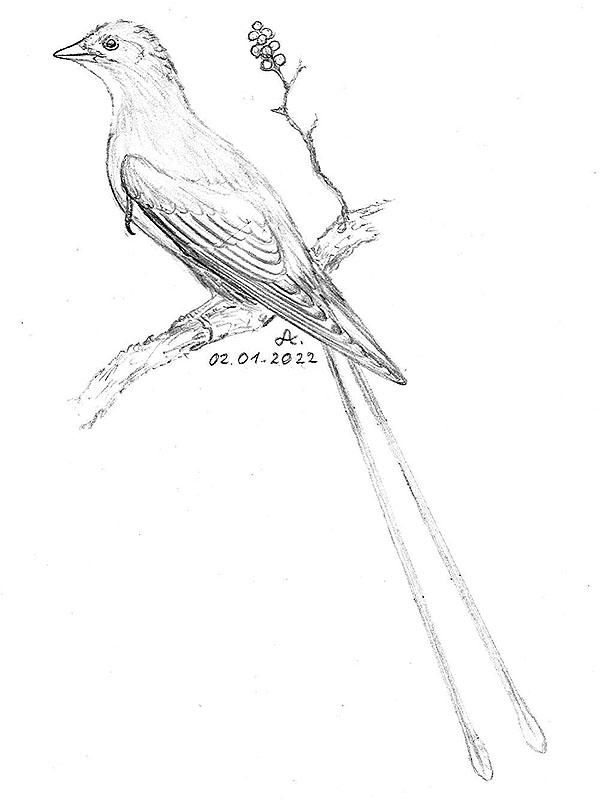
*********************
Quellen:
[1] FuCheng Zhang; ZhongHe Zhou; Michael J. Benton: A primitive confuciusornithid bird from China and its implications for early avian flight. Science in China Series D: Earth Sciences 51: 625–639. 2008
[2] Matthew P. Martyniuk: A Field Guide to Mesozoic Birds and Other Winged Dinosaurs. Pan Aves 2012
[3] Yanhong Pan; Wenxia Zheng; Alison E. Moyer; Jingmai K. O’Connor; Min Wang; Xiaoting Zheng; Xiaoli Wang; Elena R. Schroeter; Zhonghe Zhou; Mary H. Schweitzer: Molecular evidence of keratin and melanosomes in feathers of the Early Cretaceous bird Eoconfuciusornis. Proceedings of the national Academy of Sciences of the United States of America 113(49) 900-907. 2016
[4] Gerald Mayr; Thomas G. Kaye; Michael Pittman; Evan T. Saitta; Christian Pott: Reanalysis of putative ovarian follicles suggests that Early Cretaceous birds were feeding not breeding. Scientific Reports 10(19035): 1-10. 2020
[5] Pan Yanhong; Li Zhiheng; Wang Min; Zhao Tao; Xiaoli Wang; Xiaoting Zheng: Unambiguous evidence of brilliant iridescent feather color from hollow melanosomes in an Early Cretaceous bird. National Science Review. in press: nwab227. doi:10.1093/nsr/nwab227. 2021
*********************
bearbeitet: 02.01.2022
Inti-Tangare (Heliothraupis oneilli Lane et al.)
Dieser Vogel wurde erstmals 1993 entdeckt, wurde aber erst in den 2000er Jahren als etwas Neues erkannt und mit dem Spitznamen “Kill Bill-Tangare” bedacht; aufgrund ihrer Färbung, die an den, unter Filmfans berühmten, Anzug der Hauptdarstellerin im gleichnamigen Film erinnert.
Die Art wurde nun endlich offiziell als neue Gattung und Art beschrieben und wird wegen ihrer leuchtend gelben Färbung als Inti-Tangare bezeichnet, nach dem Quechua-Wort “Inti” für Sonne. [1]
*********************
Quelle:
[1] Daniel F. Lane; Miguel Angel Aponte Justiniano; Ryan S. Terrill; Frank E. Rheindt; Luke B. Klicka; Gary H. Rosenberg; Jonathan Schmitt; Kevin J. Burns: A new genus and species of tanager (Passeriformes, Thraupidae) from the lower Yungas of western Bolivia and southern Peru. Ornithology 138: 1-17. 2021
*********************
bearbeitet: 02.01.2022
… just having been described from the Early Cretaceous Crato Formation in Brazil.:
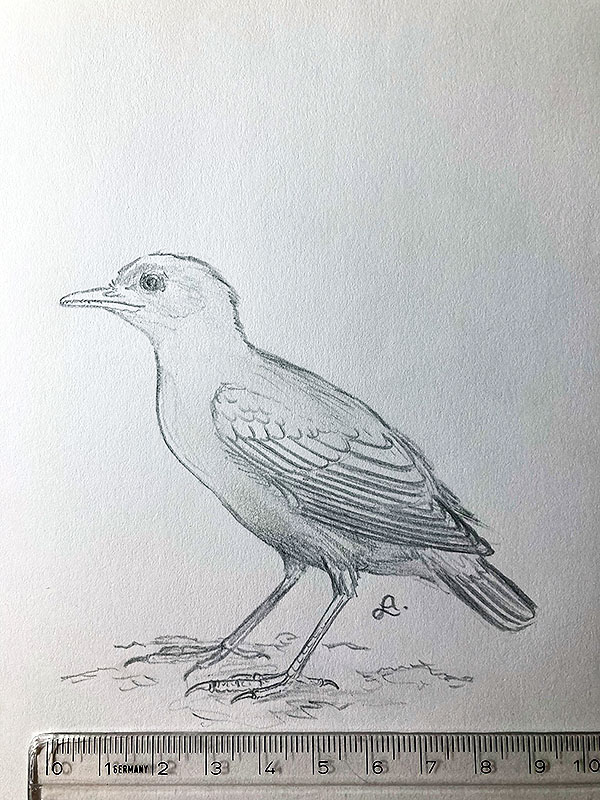
This was a member of the Euornithes, which include all living birds, yet it does not belong to any of the living bird groups of course; it is the oldest member of that group known from South America (older ones were found in China).
The bird is known only from a single right foot that lacks some of its bones; the fossil also contains some feathers which indeed may belong to the bird. [1]
*********************
References:
[1] Ismar de Souza Carvalho; Federico L. Agnolin; Sebastián Rozadilla; Fernando E. Novas; José A. Ferreira Gomes Andrade; José Xavier-Neto: A new ornithuromorph bird from the Lower Cretaceous of South America. Journal of Vertebrate Paleontology doi: 10.1080/02724634.2021.1988623. 2021
*********************
edited: 14.11.2021
“Little Owl (Ruruwekau), Strix parvissima. A very scarce bird, not larger than a starling. The head is very large. I have never obtained a specimen, but have seen it among the forests. It is an exceedingly shy bird.” [1]
***
“In this division there is a most remarkable little owl, the smallest in the world. It is known to the natives as the ruru wekau; it has an unusually large head, flies by day, is exceedingly shy, and is about half the size of the common ruru. It inhabits dense forests.” [2]
***
“No. 6. – Strix parvissima, Ellman. (Zool., 1861)
Little Owl
Amongst the desiderata of our collections the Little Owl has for some time held a place; many doubt its existence, few have seen it, still fewer have preserved any note or observation concerning it. From the information that has been gleaned about this rare bird, it would appear that its habitat must be the bushes about the Rangitata River [Canterbury Region, South Island].
One correspondent saw it on the bank of a creek at no great distance from Mount Peel Forest, it was between the roots of a large tree; observation was drawn to it by the proceedings of several tuis, who were persecuting it to the best of their ability; it was whilst its attention was engaged by these noisy assailants that the bird was secured. It was about the size of a kingfisher, and its captor felt quite certain of its being an adult specimen; it was carried home to be shown as a curiosity, and was afterwards liberated. Unlike the more-pork, when captured it was exceedingly gentle.
Another specimen was procured by a gentleman in one of the bushes far above the Rangitata Gorge; on being observed on a branch of a tree, it was knocked down and caught during its fall; there was fur on its beak, as though it had not long before devoured a mouse; this bird was also set at liberty.
Two other instances of its occurrence have been communicated, but without further information. It may be mentioned that one of these was again on the Rangitata.
At Shepherd Bush Station, on the Rangitata, opposite Peel Forest, a specimen was observed in the house, greatly resembling A. Novae Zelandiae [ruru (Ninox novaeseelandiae)], except in size, which was about that of a kingfisher; it was most gentle in its habits, remaining quiet during the daytime and sallied forth in the evening, regaining its perch by entering through a broken window. This pretty little visitor thus frequented the house for about a fortnight; it should be added that the house stands close to a small bush composed chiefly of Leptospermum, Griselinia, etc., of which there are many aged specimens.
From these notices it may be safely inferred that the Little Owl is arboreal in its habits, and possibly not so strictly nocturnal as its better known congeners; whether it is to be considered identical with either of the species referred to by Dr. Finsch is, of course, at present unknown; it is certain it is not a tufted species, or such a remarkable form would have been noticed.” [3]
***
What can we make of this little owl that apparently once existed in New Zealand?
Are these accounts referring to an actual owl or rather to some other bird, maybe even to a last surviving population of the New Zealand Owlet-Nightjar (Aegotheles novaezealandiae (Scarlett))?
This nightjar species is known only from subfossil remains that date to 1200 AD and which usually are not found in association with Maori middens, it was also not necessarily a small bird and may have been quite the same size as the ruru and only slightly smaller than the larger whēkau (Ninox albifacies); furthermore it is thought to have been flightless or at least nearly so.
There is, however, a slight chance that these eyewitness accounts indeed refer to a last surviving population of this now extinct creature, we will probably never know for sure.
*********************
References:
[1] J. B. Ellman: Brief Notes on the Birds of New Zealand. The Zoologist 19: 7464-7473. 1861
[2] J. B. Ellman: Correspondence. The Press 3(136): 2. 1863
[3] T. H. Potts: On the birds of New Zealand (Part II.) Transactions and Proceedings of the New Zealand Institute 3: 59-109. 1870
*********************

*********************
edited: 05.11.2021

*********************
edited: 03.11.2021
There is probably no other bird on this planet that comes more closely to what could be called a cryptid than the Manumea, the Tooth-billed Pigeon (Didunculus strigirostris (Jardine)) of Samoa.
The species is known to inhabit, or at least to have inhabited, the rainforests of the islands of Nu’ulua, Savai’i and ‘Upolu, Western Samoa; in prehistorical times it was even more widespread. Nearly nothing is known about this species: the breeding behavior is still unknown, the same more or less applies to basically all of the bird’s habits.
As far as I know there are only about five or so photos of living individuals of the species, most of them, if not all, show the same bird that was kept in captivity for some time.
The latest sightings were of a juvenile bird in 2013, which also was photographed; than a bird was seen and heard calling in 2020, however, no photo had been taken this time. [1]
***
The Manumea is currently not kept in captivity and the wild population is estimated to be less than 100 – to about 300 birds, that’s not much and the species is in immediate danger of extinction.
Wouldn’t it be phantastic if even only a fraction of the amounts of money that are spend to prove the existence of such phantasy creatures like Bigfoot, Chupacabra or Mokele Mbembe would be used for something useful, for the search for the Manumea, for the rescue of this enigmatic yet indeed existing bird?!
*********************
References:
[1] Sapeer Mayron: Near-extinct manumea spotted in Savai’i. Samoa Observer 25/08/2020
*********************

*********************
edited: 03.11.2021
The Maori, the indigenous people of Aotearoa (New Zealand), have a very rich oral tradition that actually dates back to the time when their ancestors first arrived at the shores of the islands!
These traditions, however, have greatly been influenced by Europeans settlers, especially by missionaries, who tried to destroy the Maori by banning everything Maori: traditional clothing, traditional musical instruments, songs, religious beliefs, even the Maori language itself, everything was banned and violations were punished severely.
No one can say how much knowledge was destroyed during these times.
“…
Kotahi tonue tama
Te tiaki whenua,
Ko te kuranui,
Te manu a Rua-kapanga,
Itahuna e to tupuna, e Tamatea
Ki te ahi tawhito,
Ki te ahi tupua,
Ki te ahi na Mahuika.
Na Maui i whakaputa ki te ao
Ka mate i whare huki o Repo-roa,
Ka rere te momo, e tama e!“
This is the end part of a large Maori poem that can be dated back to the 14th century, around the time when the first Maori settlers arrived at the shores of Aotearoa (New Zealand).
The poem mentions the kuranui, the bird of Rua-kapanga, which is said to have been the first person to have spotted the bird; te kuranui might be translated as ‘the large red one’, ‘the large precious one’ or maybe as ‘the most precious one’.
Furthermore it also informs us about the fate of these kuranui(s): “… destroyed by your ancestor, Tamatea, with underground and supernatural fire, the fire of Mahuika (a fire goddess), brought to this world by Maui; they were driven into the swamps and perished …” [1]
*********************
References:
[1] Otto Krösche: Die Moa-Strausse, Neuseelands ausgestorbene Riesenvögel: Die neue Brehm-Bücherei 322. A. Ziemsen Verlag 1963
*********************
edited: 02.11.2021
Nowadays there is only one single species of starling in central Polynesia, the Rarotonga starling (Aplonis cinereacsens Hartlaub & Finsch), which occurs exclusively on the island of Rarotonga, the largest of the Cook Islands; another form, the Plain Starling (Aplonis mavornata Buller), itself a mystery for over a century, came from another of the Cook Islands, namely Ma’uke.
So, it’s pretty certain that other forms were once found on other islands in this archipelago, right?
I just found a clue in this direction when I was writing down the names from a list of birds compiled in the early 20th century by someone named F. W. Christian; this list is part of a kind of dictionary of the Mangaian dialect, the dialect spoken on the island of Mangaia, the southernmost and second largest of the Cook Islands.
Here a list of the bird names.:
“Pā-Tangaroa. – A speckled bird; somewhat larger than the Kere-a-rako. Frequents coconut palm blossoms.
Tangaa-‘eo. – The native Wood-pecker; blue above, yellow and white below.
Kere-a-rako. – A small yellow and green song-bird much resembling a canary.
Titi. – A bird living in the rocks and crags. Much relished for food. Cf. Maori Titi, the Mutton-bird. Sanskrit and Hindustani, Titti: Tittiri, the Partridge.
Mokora’a. – The Wild Duck, or rather, a small species of teal, found in abundance round Lake Tiriara.
Kauā. – A sea-bird.
Rakoa. – A sea-bird.
Torea. – A sea-bird.
Kotuku. – The Blue Heron.
Kakaia. – A beautiful small white tern or sea-gull.
Kotaa. – The Frigate or Boatswain Bird. Cf. Samoa, A ta fu,; id. Fijian, Kandavu; id. Uleai (W. Carolines) Kataf; id. Sonserol (S. W. Caralises) Gatyava; id. Cf. Sanskrit Gandharva, a celestial messenger: angel.
Tavake. – The Tropic Bird (Phaethon). Called in the Marquesas Tavae-ma-te-ve’o, from its two long red tail-feathers. Used in Polynesian head-ornaments. Cf. Ponape Chaok: Chik; id. Cf. Sanskrit Stabaka, Stavaka a peacock’s feather: tuft: plume.
Kara’ura’u. – A sea-bird.
Kururi: Kuriri. – The Sand-Piper.
Karavi’a. – The Long-tailed Cuckoo.
Kura-mō. – A small Parrakeet (on Atiu).” [1]
The respective scientific names of the birds.:
Pā-Tangaroa. – ?
Tangaa-‘eo. – Todiramphus ruficollaris
Kere-a-rako. – Acrocephalus k. kerearako
Titi. – Pterodroma nigripennis
Mokora’a. – Anas superciliosa
Kauā. – Numenius tahitiensis
Rakoa. – Puffinus lherminieri
Torea. – Pluvialis fulva
Kotuku. – Egretta sacra
Kakaia. – Gygis alba
Kotaa. – Fregata spp.
Tavake. – Phaethon rubricauda
Kara’ura’u. – Procelsterna cerulea
Kururi: Kuriri. – Tringa incana
Karavi’a. – Eudynamis taitensis
Kura-mō. – Vini kuhlii
***
All of these names can be assigned to actually existing bird species, with one exception – the first name.
So which species is hiding behind the name Pā-Tangaroa?
This is actually a rather unusual name for a Polynesian bird, and the reference to Tangaroa, one of the most important Polynesian gods, is very interesting. Perhaps a bird with such a name was also considered God-like or sacred, or at least as being tapu.
The description of this bird: speckled and slightly larger than the Kerearako (i.e. larger than 16 cm), often found on coconut flowers, fits a star of the genus Aplonis quite well, in fact it suits this genus more than any other genus in question.
So there was almost certainly once a star of the genus Aplonis that lived on the island of Mangaia, and its subfossil bones may sooner or later be discovered; the question is, did the species survive long enough that locals could at least remember that it was called Pā-Tangaroa? Given that research into the fauna and flora of the Cook Islands didn’t begin until the early 20th century … it is entirely possible!
***
I should also mention that this listing, which dates back to 1920, already mentions the Cook Island reed warbler (Acrocephalus kerearako Holyoak), which was not officially discovered until 1973 (and described a year later). [2]
*********************
References:
[1] F. W. Christian: List of Mangaia birds. The Journal of the Polynesian Society 29(114): 87. 1920
[2] D. T. Holyoak: Undescribed land birds from the Cook Islands, Pacific Ocean. Bulletin of the British Ornithologists’ Club 94(4): 145-150. 1974
*********************
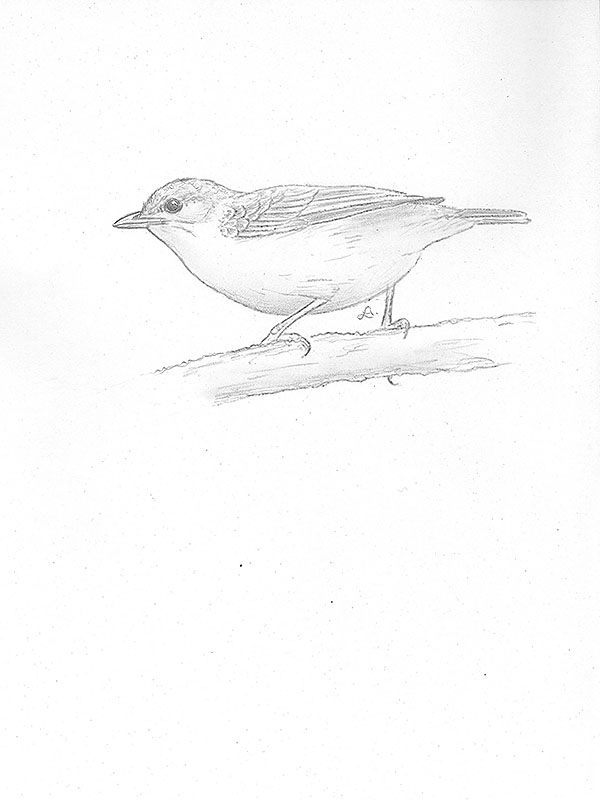
*********************
edited: 01.11.2021
This is a very interesting question that was asked by many scientists – what does Maori lore tell us about the now extinct megafauna of New Zealand? The results of all previous investigations are rather sobering, all so-called traditional accounts seem to date to the time following the arrival of the Europeans in New Zealand.
I want to mention only one of them here.
The first account dates from the middle of the 19th century.:
“The natives speak of another member of this family, which they name the kiwi papa whenua, a still larger species, which they describe as having been full seven feet high; it likewise had a very long bill, with which it made large holes in the ground, in search after worms. This bird is now extinct, but there are persons living who have seen it. Rauparaha told me he had eaten it in his youth, which might be about seventy years ago [ca. 1785], and when that Chief died, his corpse was said to have been ornamented with some of its feathers.” [1]
***
This second account refers to the first one and was made just ten years later.:
“Kiwi Papa Whenua. Seven feet [ca. 2 m] high. One of the last birds to disappear. There are still men who have hunted it.” [2]
***
The Kiwi papa whenua accounts may indeed refer to one of the smaller or middle-sized moa species, one that was about 2 m tall and that may have survived longer than most of the other moa species, but probably not into the early- or middle 18th century; it might thus be referring to the so-called Upland Moa (Megalapteryx didinus (Owen)), a species that officially died out around 1500 AD.. However, when reading the first account, it is very clear that this description has been mixed with that of a typical kiwi, thus it is quite clear that these accounts are no eyewitness reports.
The term Kiwi papa whenua might be translated as ‘Ground kiwi’ or maybe ‘Kiwi of the land’ which is not very meaningful. It is furthermore rather unlikely that the Maori would have connected the diurnal, rather large, long-necked moa species with the completely distinct kiwi(s), thus it is very unlikely that the term ‘kiwi’ would have been used for any of these species.
Nevertheless, such old accounts remain very interesting, and I will go on posting more of them in the future.
*********************
References:
[1] Richard Taylor: Te Ika a Maui: or, New Zealand and its inhabitants, illustrating the origin, manners, customs, mythology, religion, rites, songs, proverbs, fables, and language of the natives: together with the geology, natural history, productions, and climate of the country; its state as regards Christianity; sketches of the principal chiefs, and their present position; with a map and numerous illustrations. London: Wertheim and Macintosh, 24, Paternoster-Row. 1855
[2] J. B. Ellman: Brief Notes on the Birds of New Zealand. The Zoologist 19: 7464-7473. 1861
*********************
edited: 01.11.2021
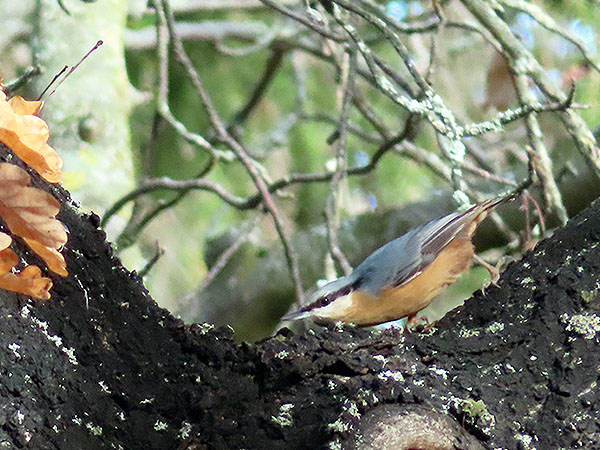
*********************
bearbeitet: 31.10.2021
… photographed in the city park of Gotha / Thuringia.
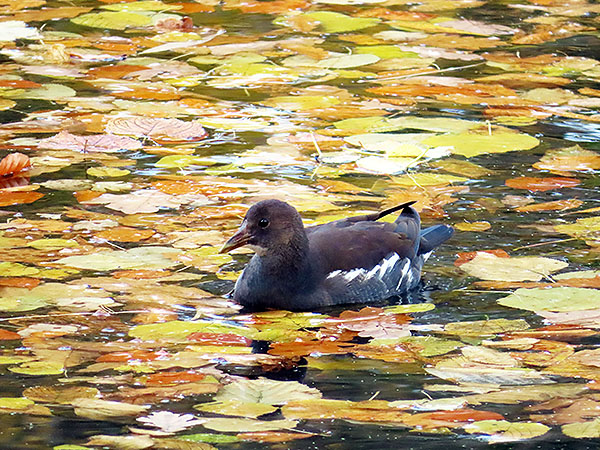
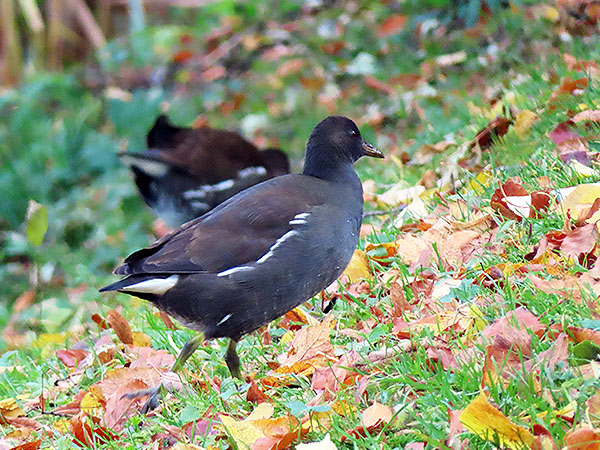
*********************
edited: 31.10.2021
This exhibition is a small part of what once was the ‘Naturkundemuseum Gotha’, it is now placed in a single floor of one tower the Friedenstein castle and consists of a hand full of stuffed animals including some birds.
One thing that is immediately noticeable is the darkness in all the rooms, almost as if this exhibition was planned by – or for vampires, that’s stupid!
In one of the first showcases are some animals that are alternately illuminated one after the other, among them is this plastic model of a Chinstrap Penguin that seems to drift around in the nothingness of space and time ….:
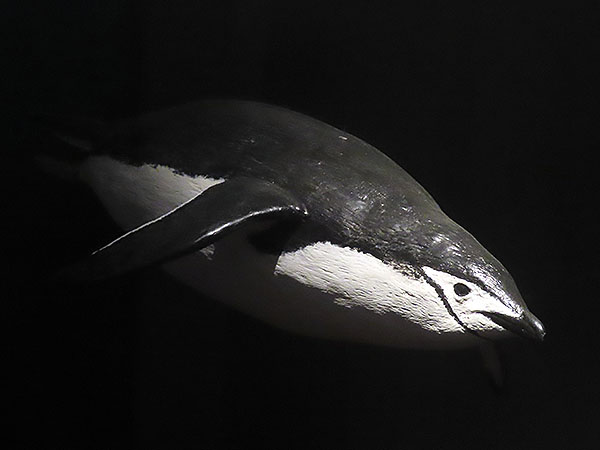
Another room shows some animals from Antarctica, all with the German names only, scientific names are not used, and the whole exhibition seems to be made especially for children, which is actually a thing that many museums think they need to do for what reasons ever ….
This is probably the only room that is not pitch black, by the way.:
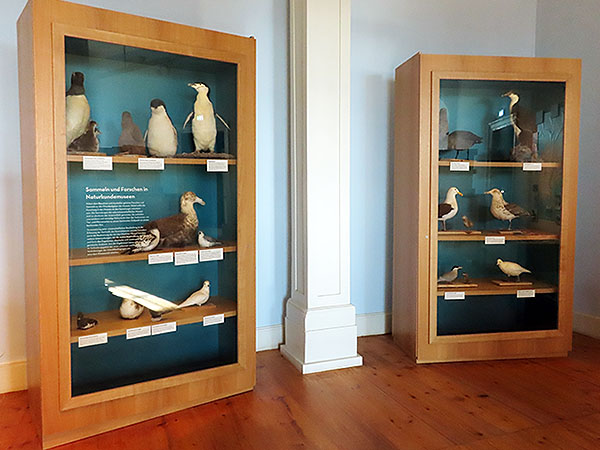
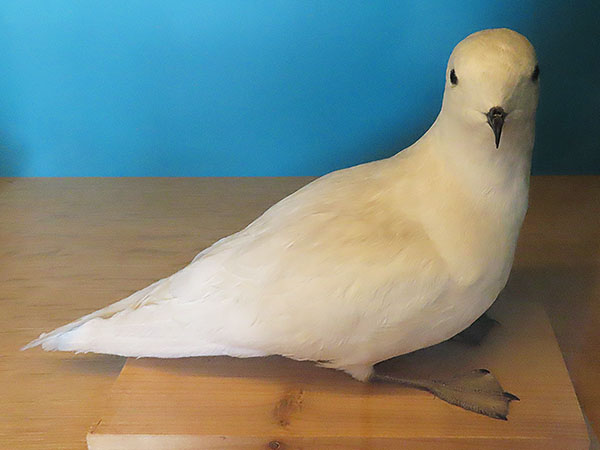
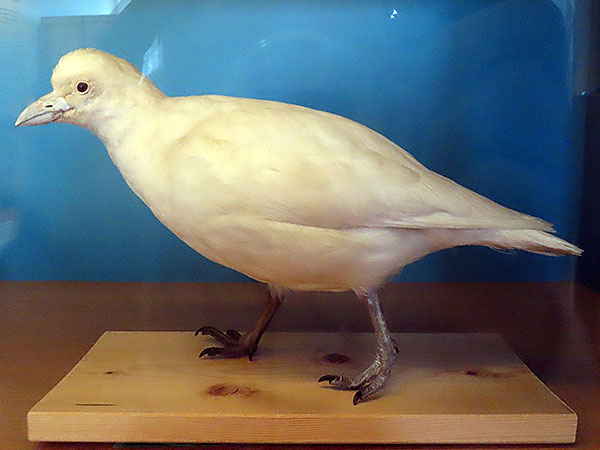
Another room is dedicated to the biodiversity of the tropics, and here we find, well, maybe about twenty birds (this time with their scientific names attached), some five mammals, a hand full of insects without any names and … animal sounds from speakers, that are extremely annoying because they are way too loud!
… and this room again is as dark as – I don’t know – a rainforest at night maybe.:


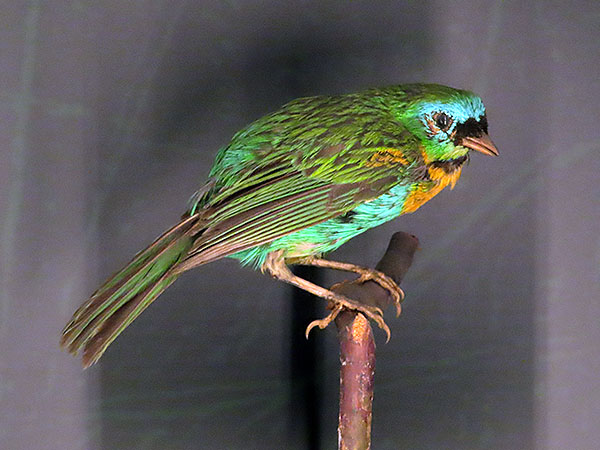
The last room of the exhibition is dedicated to European native nocturnal animals, so there’s basically no light at all … which is a lot of fun if you want to take some photographs of something ….:

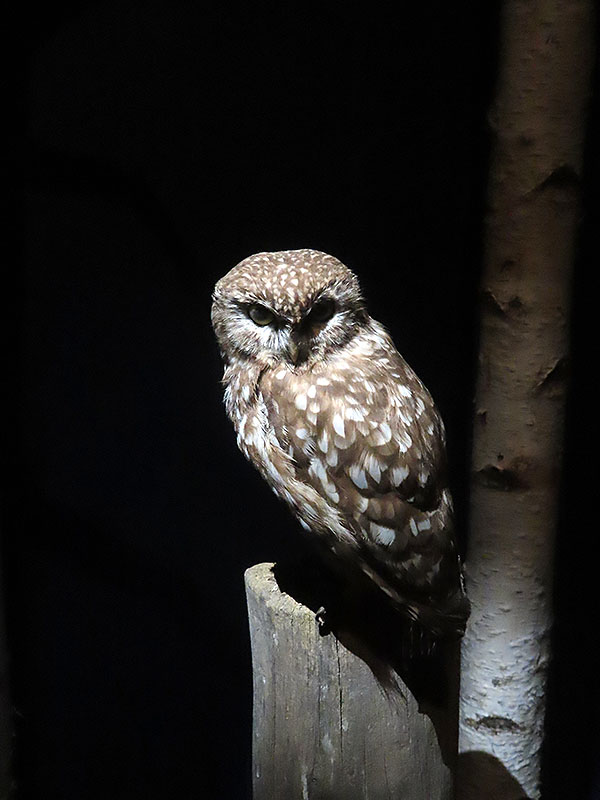
In the museum shop I found this cheap book about the bird specimens that still are hidden in the depots of the former ‘Naturkundemuseum’; it must be nearly a thousand specimens or more which once were all shown to the public, as I can well remember from my childhood days.:
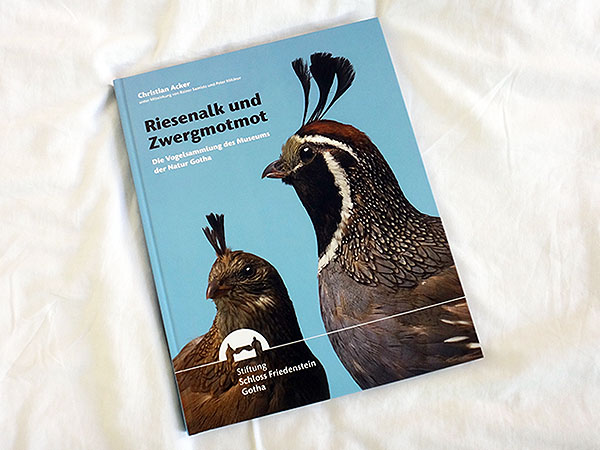
The current exhibition exists since 2010 and nothing was changed or added despite plans to relocate all of the specimens from the former museum into the castle where they are supposed to get more space, that’s a great shame because at least the bird collection is indeed one of the largest in Europe and contains some extremely valuable specimens!
**********************
edited: 31.10.2021

This is a ‘new’ species that was discovered on Mt. Mutis in western Timor, Indonesia; it has not yet been described.
*********************
edited: 20.10.2021
These four watercolor paintings date from 1792 and were made by the infamous Captain William Bligh himself, the captain of the HMS Providence, who had come to Tahiti on a mission to transport breadfruit trees and other botanical material from the Pacific to the West Indies.
These pictures were made on the island of Tahiti; three of the depicted species are now no longer found on that island and the Black-fronted Parakeet is even extinct completely.
*********************
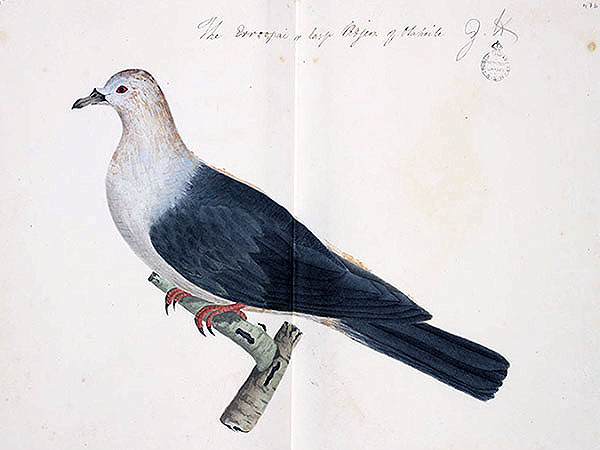

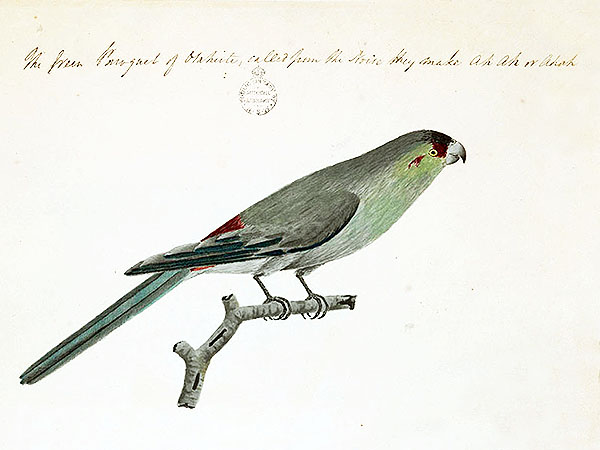
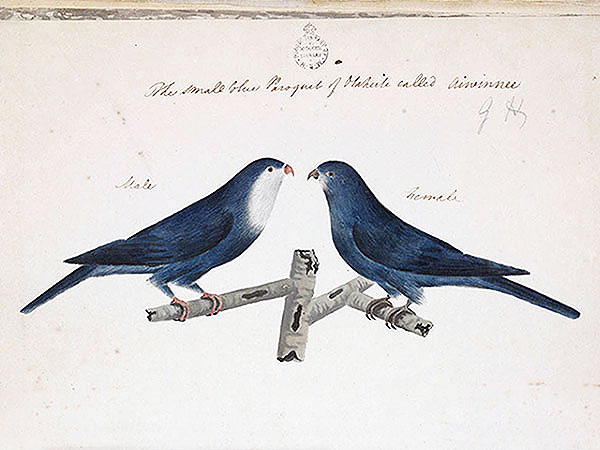
*********************
edited: 20.10.2021
This artwork was made by John Webber (1751 – 1793), an English artist of Swiss origin who accompanied Captain James Cook on his third voyage from 1776 to 1780; the painting was apparently made in Tahiti based on a living bird.
*********************
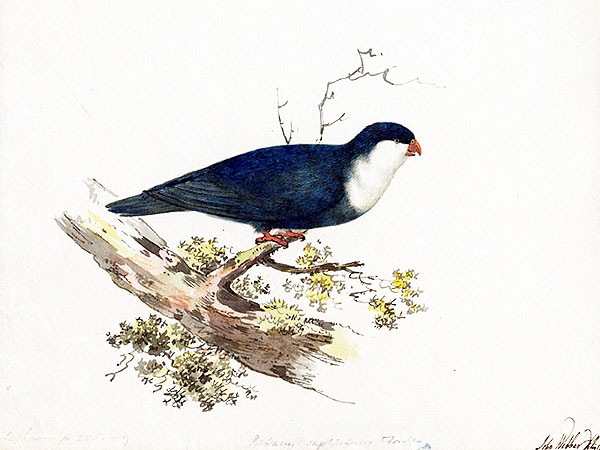
*********************
edited: 19.10.2021
This depiction with its vivid blue colors was made in about 1785 by Sarah Stone (ca. 1760 – 1844), an almost unknown artist who apparently lived in London and produced many watercolor depictions of birds using stuffed specimens.
*********************
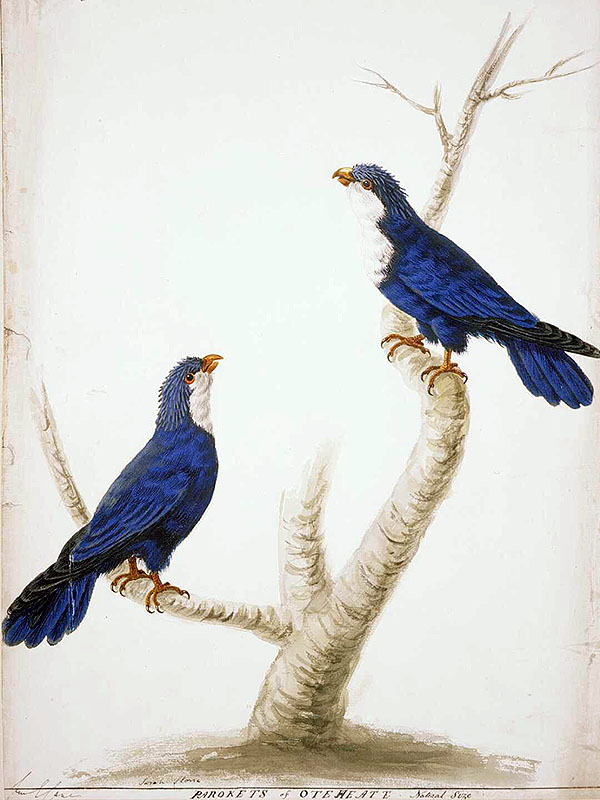
*********************
edited: 19.10.2021
Die beiden folgenden Darstellungen stammen von Roland Green (1890-1972), einem englischen Maler, der sich offenbar auf Säuger- und vor allem Vogelbilder spezialisiert hatte und dessen Abbildungen sehr lebensecht wirken.
Beide Bilder wurden wohl direkt für die dazugehörigen Artikel im ‘Avicultural Magazine’ angefertigt und stammen demzufolge aus den 1930ern.
*********************
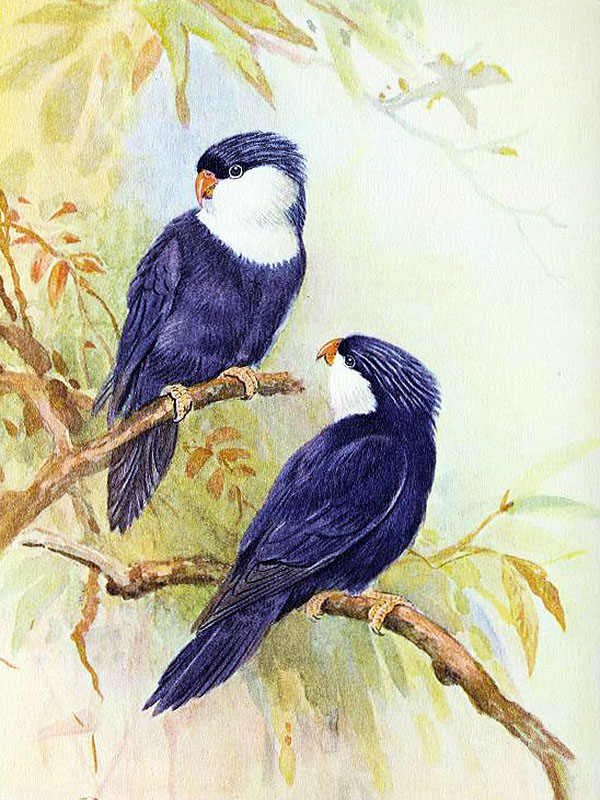

*********************
bearbeitet: 08.10.2021
James C. Greenway, Jr.: Extinct and Vanishing Birds of the World. Dover Publications, Inc., New York 1958
*********************
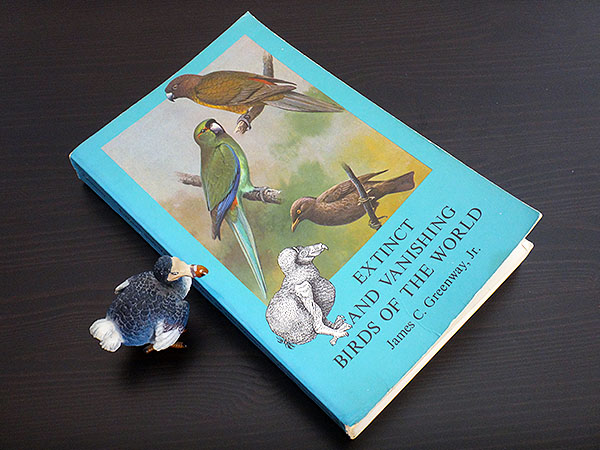
This is a highly (out)dated book, originally published in 1958; my copy, however, is a revised print from 1967.
The cover shows two of my absolute favorite bird species, the extinct Society Islands parakeets.
As the title implies, the book not only covers extinct birds (species and subspecies) but also those on the brink of extinction (at the time of the publishing), some of them with black-and-white drawings, it is also a very useful source for literature citations etc.. It is very intriguing to think about how much has changed since that time ….
If you are interested in that topic and are able get your fingers on this book – do it!
*********************
edited: 21.09.2021
Alan Woollett: Bird Art: Drawing Birds using Graphite & Coloured Pencils. Search Press Ltd. 2017
*********************

The author is an artist who works with colored pencils, but not with watercolor pencils unfortunately, but that’s not really a big problem here. I could still “learn” some things that I had already figured out myself … it is just quite nice to see how others work and that others come to the same conclusions when facing the same problems as oneself. 🙂
This book can be recommended.
*********************
edited: 21.09.2021
In his great blog (that I actually – and that’s no lie – look into at least once a week), Paul Cianfaglione writes about many bird-related things, including fine book reviews, very interesting insights into bird anatomy and everything else.
But his latest post is just unbeatable: he did make an extremely close inspection of a bird fossil from Messel that he owns.:
“Messel Bird Fossil offers unique feather preservation, and more” from January 23, 2019
***
I personally have never seen close-ups of a bird fossil that are so razor-sharp and detailed!
And his bird shows features not known in any living bird – at least not all of them together in one bird.:
The beak is very big and hooked like the beak of a bird of prey or a owl, and it appears to have had sensory pits, the body feathers appear somewhat hair-like, the wing coverts are fluffy, also probably somewhat like the feather edges of recent owls, and the primaries have extremely strange appendages not known in that way from any other bird, living or extinct, but somewhat reminding on the wings of a waxwing.
What kind of a bird was that?
Well, I could try to do a reconstruction, should I?



***
The Avian Musings blog does not longer exist, unfortunately.
*********************
edited: 03.09.2021
This is one of two passerine bird species recently found in middle Miocene deposits in Austria, this one is known from a partial skull and several other quite shredded bones while the second one is known only from a sternum.
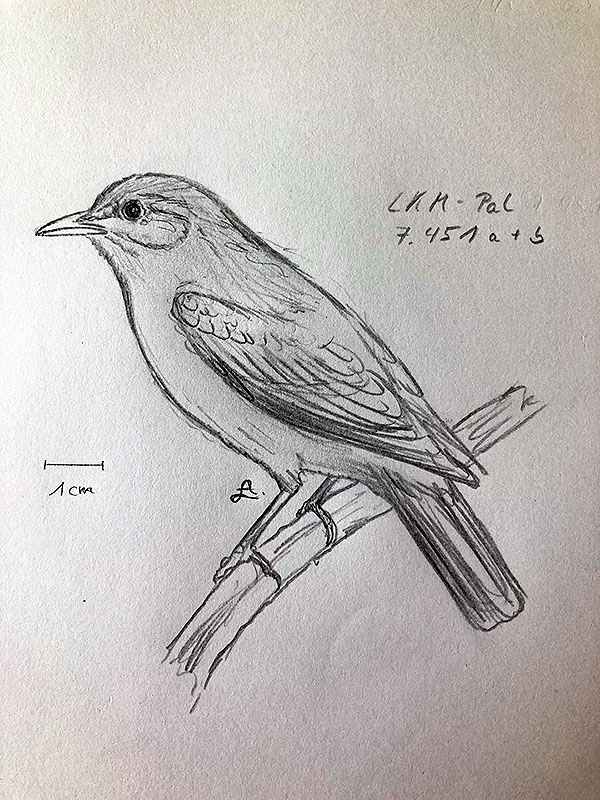
*********************
References:
[1] Johannes Happ; Armin Elsler; Jürgen Kriwet; Cathrin Pfaff; Zbigniew M. Bochenski: Two passeriform birds (Aves: Passeriformes) from the Middle Miocene of Austria. PalZ (2021). https://doi.org/10.1007/s12542-021-00579-2
During the latest digging campaign in the Messel shale, a new bird fossil was found that has unimaginably well-preserved feathers – even by Messel standards, while the bones themselves are rather crumbly.
***
This bird reaches the size of a recent Great Tit (Parus major L.), it apparently had a short and broad beak and anisodactyl feet.
The feathers are exceptionally well-preserved and distinctly colored: the feathers on the head and neck are greyish brown with reddish brown tips; the rump feathers are dark ashy brown; the primary coverts of the wing are straw yellow, the primaries are reddish brown with a purplish hue; the tail feathers (at least 10) are nearly as long as the primaries, they are straw yellow and have a distinct reddish brown and dark brown stripy pattern not unlike as in recent birds of prey.
These are of course not the original colors of that bird, yet the patterns are! [1]
***
The fossil has only just been found, it hasn’t yet been prepared and has not even a collection number, thus there is not much that can be said about it, however, all in all this form reminds me on Hassiavis laticauda Mayr, a member of the family Archaeotrogonidae from the same locality, but it is of course much smaller and has proportionally less stout arm- and leg bones.
*********************
References:
[1] Georgina Jadikovskaal: Fossil of unknown bird species resembling great tit found during dig at UNESCO site. Zenger News July 12, 2021
*********************

*********************
edited: 09.08.2021
… today was the last time I took a look on David Peters’ website bullshiteria!
The Mangareva Reed Warbler (Acrocephalus astrolabii Holyoak & Thibault), only described in 1978, is one of the many mysterious birds whose cases were solved only quite recently.
The species was restricted to the Gambier Islands, where it was at least found on the biggest of the islands, Mangareva.
The species disappeared sometimes during the early or middle 19th century, but the natives still recalled the former presence of it and were also still using its name.:
“She [the daughter of the Chief of the island of Taravai] has not seen the “Komaku” herself, but her father, the Chief, has. He gave us the name and says he saw them about thirty or forty years ago.” [1]
***
The species apparently died out sometimes around the middle 19th century; it is, however, possible that it survived into the middle of the 20th century …:
“Signalons aussi qu’une fauvette fut observée sur l’îlot Tepapuri en 1971 (Thibault, 1973b). Ce dernier oiseau, blanchâtre dessus et brun dessous, devait être un erratique de la forme habitant, les atolls au nord des Gambier, A. caffer ravus.“ [2]
translation:
“Note also that a warbler was observed on Tepapuri islet in 1971 (Thibault, 1973b). This last bird, whitish above and brown below [I’m quite sure that it should be exactly reversed], must have been an erratic of the form inhabiting the atolls north of the Gambier, A. caffer ravus.”
I somewhat doubt that assumption, and this account may indeed be the very last sighting of a Mangareva Reed Warbler that took place on one of the northernmost motu of the Gambier Island’s fringing reef.
*********************
References:
[1] Whitney South Sea Expedition of the American Museum of Natural History: Voyage of the ‘France’ from Timoe Atoll to the Mangareva Islands; Voyage to Marutea. April 25 – May 14, 1922. Extracts from the Journal of Ernest H. Quayle; Assistant Field Naturalist. Book XXV through Book XXVIII. April 1 – June 24, 1922
[2] D. T. Holyoak; J.-C. Thibault: Contribution à l’étude des oiseaux de Polynésie orientale. Mémoires du Muséum national d’histoire naturelle 127(1): 1-209. 1984
[3] Alice Cibois; Jean-Claude Thibault; Eric Pasquet: Molecular and morphological analysis of Pacific reed warbler specimens of dubious origin, including Acrocephalus luscinius astrolabii. Bulletin on the British Ornitologists’ Club 131(1): 32-40. 2011
*********************
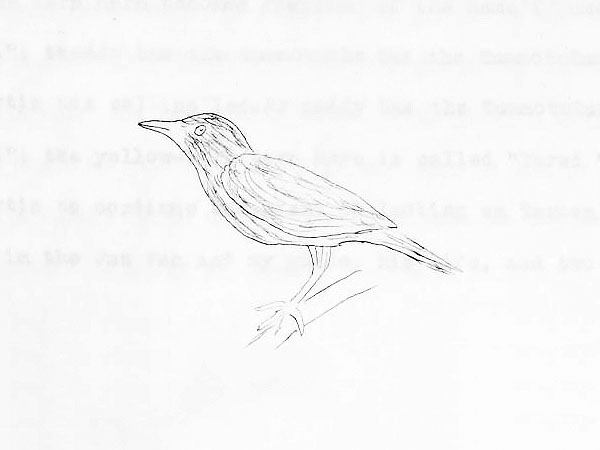
*********************
edited: 08.08.2021
The Mangareva Kingfisher still is one of the most enigmatic birds I am aware of so far.
The species inhabited the Gambier Islands, and another species occurring 1000s of km to the northwest of it, the Niau Kingfisher (Todiramphus gertrudae Murphy), is still officially assigned to this bird as a subspecies.
I have desperately tried to find the original description of this species, and here it is.:
“Il existe, en effet, depuis longtemps dans les galeries du Muséum un Martin- pêcheur qui a été rapporté en 1841 de Mangarewa (archipel Gambier) par l’Astrolabe (Voyage au Pôle Sud) et qui répond exactement à la description et à la figure de l’Halcyon Reichenbachi. Cet oiseau a le sommet de la tête d’un roux qui va en s’éclaircissant et tire au blanc jaunâtre du côté, du front, mais qui est assez intense sur le vertex où se détachent quelques plumes vertes. Sur les oreilles il existe aussi, de chaque côté une tache verte, passant au noirâtre en arrière et tendant à rejoindre une bande noire qui fait le tour de l’occiput. Cette bande foncée limite en dessus un large collier blanc, un peu sali par quelques taches noires, qui se fond sur les côtés dans la teinte blanche qui couvre toutes les parties inférieures du corps, les flancs seuls offrant un peu de roux et encore sur des points cachés entièrement par les ailes. Celles-ci sont d’un vert légèrement bleuâtre, avec des lisérés roux très fins au bord des couvertures alaires. La queue est également d’un vert bleuâtre au milieu, d’un vert mélangé de grisâtre sous lespennes externes, qui sont d’ailleurs incomplètes. Enfin le bec est noir et la mandibule, inférieure blanche ou plutôt jaunâtre dans toute sa portion basilaire. Les pattes sont d’un m brun foncé. La longueur totale de l’oiseau est de 0,170; l’aile mesure 0,090, la queue 0,880, le bec 0,018; le tarse 0,014. Dès 1889, en faisant une revision des Alcédinidés du Muséum en vue de leur instal- lation dans les nouvelles galeries, j’avais désigné ce Martin-pêcheur de Mangarewa sous le nom d” Halcyon Gambieri; mais je n’en avais pas publié la description jusqu’à ce jour.” [1]
translation:
“For a long time, there has been a kingfisher in the galleries of the Museum who was brought back in 1841 from Mangarewa (Gambier Archipelago) by the Astrolabe (Journey to the South Pole) and who exactly corresponds to the description and the figure of Halcyon Reichenbachi. This bird has the top of the head red that brightens to yellowish white on the side of the forehead but is quite intense on the vertex where some green feathers stand out. On the ears there is also, on each side a green patch, passing blackish back and tending to join a black band that goes around the occiput. This dark band has a large white necklace on top, a little dirty with a few black spots, which is melting on the sides into the white hue that covers all the lower parts of the body, only the flanks offering a little russet and are, on some points, hidden entirely by the wings. These are a slightly bluish green, with very fine red rims at the edge of the wing coverts. The tail is also bluish green in the middle, of a green mixed with greyish under the outer feathers, which are also incomplete. Lastly, the beak is black, and the mandible underneath is white or rather yellowish throughout its base portion. The legs are of a dark brown. The total length of the bird is 0,170; the wing measures 0,090, the tail 0,880, the beak 0,018; Tarsus 0,014. As early as 1889, by making a revision of the Alcedinidae of the Museum with a view to their installation in the new galleries, I had designated this kingfisher of Mangarewa under the name of Halcyon Gambieri; but I had not published the description so far.“
***
What I am wondering about most is the fact that the Mangareva – and the Niau Kingfishers still are regarded to as a single species; on the other hand, both forms are rather similar to each other.
Which of the many other Polynesian islands might once have harbored their own kingfisher forms not known to us today?
*********************
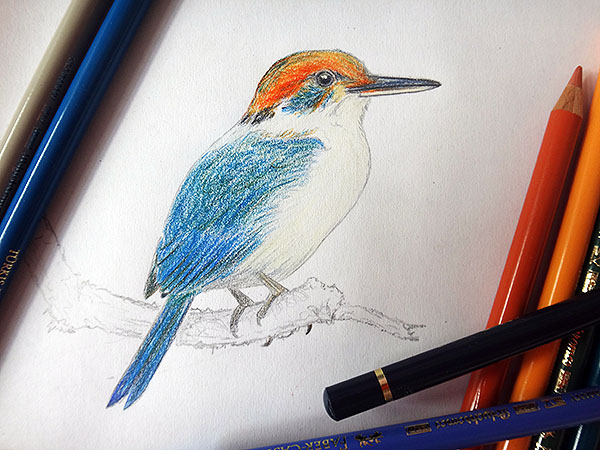
*********************
[1] M. E. Oustalet: Les Mammifères et les oiseaux des iles Mariannes. Nouvelles archives du Muséum d’histoire naturelle 3(7): 141-228. 1895
[2] D. T. Holyoak; J. C. Thibault: Halcyon gambieri gambieri Oustalet, an extinct Kingfisher from Mangareva, South Pacific Ocean. Bulletin of the British Ornithologists’ Club 97(1): 21-23. 1977
*********************
edited: 08.08.2021
posted on February 11, 2019
“Ksepka, Grande and Mayr 2019 describe two Early Eocene congeneric bird species. Eofringillirostrum parvulum (Fig. 1) is from Germany, 47mya. Eofringillirostrum boudreauxi from Wyoming, 52mya.”
“Eofringillirostrum boudreauxi, E. parvulum (Ksepka, Grande and Mayr 2019; IRSNB Av 128a+b; FMNH PA 793; early Eocene; < 10cm long with feathers) was originally considered a finch and a relative of Pumiliornis, a wren-sized Middle Eocene spoonbill. Here Eofringillirostrum nests as a phylogenetically miniaturized corn crake (below). The rail, Crex, is ancestral to chickens, sparrows, moas and parrots, so Eofringillirostrum probably had a Cretaceous origin. A distinctly long fourth toe was considered capable of being reversed, but no sister taxa with a similar long toe ever reverse it for perching until, many nodes later, parrots appear.“
No, if Mr. Peters would just once actually read the papers he is talking about he would have noticed that no one ever considered these two birds to be finches!
No, again, Pumiliornis is not a spoonbill, no matter how hard Mr. Peters wishes!
The genus Crex is not the ancestor of the abovementioned bird genera!
“Corn crake are not ‘perching birds’. As we learned earlier, taxa formerly considered members of Passeriformes are a much smaller list in the LRT. Birds capable of perching arise in several clades by convergence.
The corn crake is omnivorous but mainly feeds on invertebrates, the occasional small frog or mammal, and plant material including grass seed and cereal grain. It is not a perching bird, but prefers grasslands“
I don’t think that Mr. Peters understands the concept of convergence, however, here he is using it right (more or less), maybe by chance ….
“According to the LRT, Eofringillirostrum is not a finch, not a seed eater and not a ‘perching bird’ (in the classic sense, but likely evolved perching by convergence) according to phylogenetic analysis and phylogenetic bracketing.)“
Right, it is not a finch – but: no one ever said that except for Mr. Peters ….
It may very well have been a seed eater – just take a look at its beak, it’s a typical seed-eater beak ….
Why is it not a perching bird in the classic sense? The term >perching bird< is not a strictly scientific one, it just refers to birds that are able to sit on a twig by grabbing it with their toes, so …?
*********************
edited: 02.08.2021
This abomination was created by David Peters on October 24, 2017 and I have no words to describe how much it hurts reading that stuff!
“The jabiru: a long-legged kingfisher, not a stork”
“Or maybe kingfishers (genus: Megaceryle, Fig. 1) are just neotonous [sic] (juvenile-like) jabirus (genus: Jabiru, Figs. 2, 3). Certainly the jabiru, with its solid beak, ventrally convex jawline and high small naris, are not like other storks.”
Well, has he ever looked at other storks?
“Megaceryle alcyon (Linneaus [sic] 1758), the extant belted kingfisher, had an enlarged beak on an enlarged skull with a shorter neck. As in parrots, by convergence, the nares have migrated back to the orbit.”
Since this species is still extant it did not had, it has …, and all kingfishers have enlarged beaks on enlarged skulls and shorter necks ….
“Jabiru mycteria (Lichtenstein 1819) was a stork-like kingfisher nesting between the stilt/hummingbird clade and the murre/penguin clade (what variety!) Note the high small naris on the ventrally convex rostrum, as in the belted kingfisher.”
That is the part that really hurts, the Jabiru is a perfect stork, and the photo DP has chosen to show on his website shows one that has his legs covered in its own feces – something that all storks do to cool down their body temperature, kingfishers, however, don’t … and a stilt/hummingbird- or a murre/penguin clade does not exist ….
“If this turns out to be a case of convergence, and it might… that will come with the addition of more taxa. We’ll see…”
This is the only time DP mentions convergence, a concept that he usually doesn’t seem to understand … yep, if two species share a similar way of life they may have more or less identical adaptions to that lifestyle (for example: everything that’s living in the water has some fins or flukes of some kind …).
So, in fact, DP says that the Jabiru must be a kingfisher because – and only because – of its beak! He doesn’t think about the hundreds of other features that this species doesn’t have in common with kingfishers but firmly clings to this one – a beak adapted to catch wiggly prey. Wow!
Like already said before, having outlandish ideas is okay, promoting them as being the one and only truth is insane!
*********************
To show you what we talk about here, here are some photographs of the bird species mentioned in the post.:
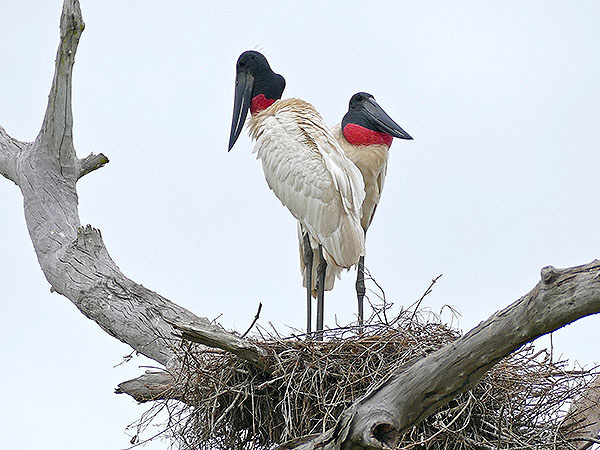
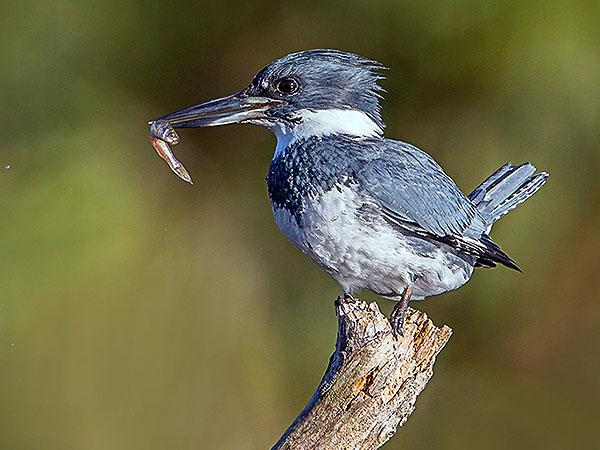
***
BTW: There is even a so-called Stork-billed Kingfisher (Pelargopsis capensis (L.)), a species that DP probably never has heard of, otherwise he probably would have chosen this one for his “strange suggestions”.
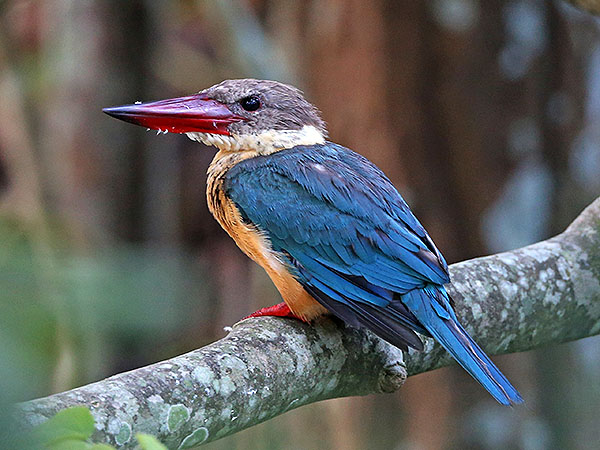
*********************
edited: 31.07.2021
This was posted on David Peters’ website on June 6, 2018.:
“Pumiliornis tesellatus [sic] is a wren-sized (shown larger than actual size) Messel pit bird that was originally (Mayr 1999) considered an enigma and later (Mayr 2008) allied with cuckoos. In the large reptile tree (LRT, 1225 taxa) tiny Pumiliornis nests with Platalea, the spoonbill (Fig. 2) as a phylogenetic miniature, close to, but not quite related to the parallel, short-legged genesis of ducks and geese.”
I’m not quite sure what this “short-legged genesis” is supposed to be, but the length of the legs does not indicate any relationships between birds but has much more to do with their way of life!
“Presbyornis, currently at the base of ducks, still has long legs and a long neck. More derived taxa in the duck branch lose their long legs, although some, like the swan and goose, retain a long neck.”
What does that have to do with the genus Pumiliornis or with spoonbills?
“Pumiliornis tessellatus (Mayr 1999, 2008; 6cm long; middle Eocene). This wren-sized relative to spoonbills and ancestor to ducks has a spatulate beak tip. This is a neotonous [sic] form of the long-legged spoonbill with juvenile size and proporitons [sic] representing the genesis of a new clade. This fossil contains fossil grains in the cloacal area (white box). Note that no webbing is preserved between the toes. Spoonbills also lack webbed toes.”
***
No, it is not a relative of the spoonbills, and it is not at all an ancestor to ducks, which by the way already existed anyway back then, which again would make it even harder to be their ancestor ….
No, its beak tip isn’t spathulate ….
Yep, Pumiliornis was a very small bird – that doesn’t make it neotenous, at least not more so than any other Passeriform bird, which are indeed thought of as being somewhat neotenous compared to non-passeriform birds.
No, its proportions are not those of a juvenile spoonbill ….
Yep, the fossil contains fossil grains – pollen grains, since it obviously was a nectar-feeding bird with an elongated beak as is typical for nectar-feeding birds ….
No, Spoonbills do not lack webbing on their toes, they actually have small webs along the bases of their toes ….
***
To think that a small nectar-feeding perching bird is the ancestor of ducks and a relative of spoonbills is, well, funny. To promote that bullshit as if it would be the absolute truth, however, is just insane!
***
I’ll probably take some of my precious time to try to debunk more of David Peter’s nonsense in the future, we’ll see.
***
Why the world really should ignore David Peters
*********************
edited: 30.07.2021
A very important article, worth reading, by the wonderful Dr. Darren Naish, I’ve just changed the heading a bit.:
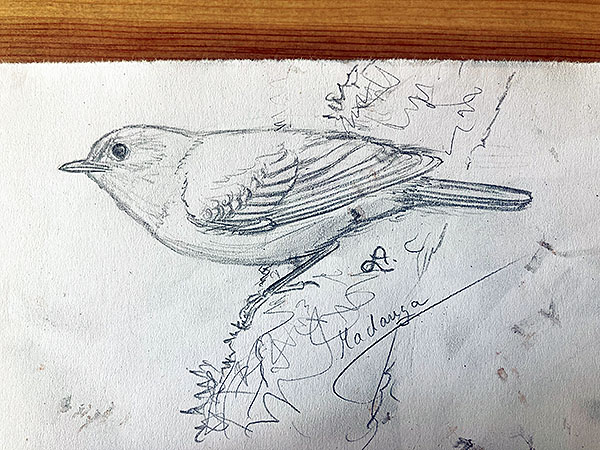
*********************
edited: 18.07.2021
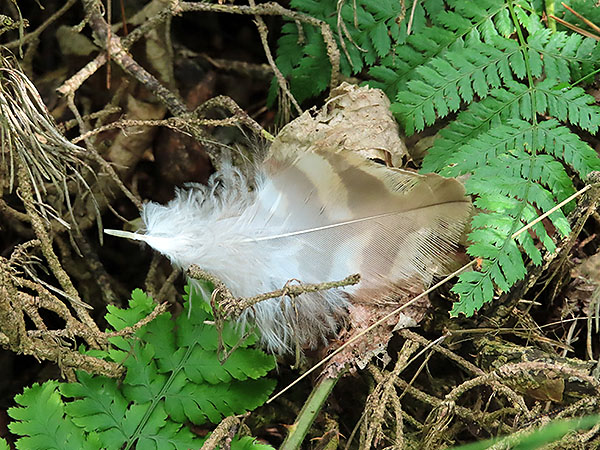
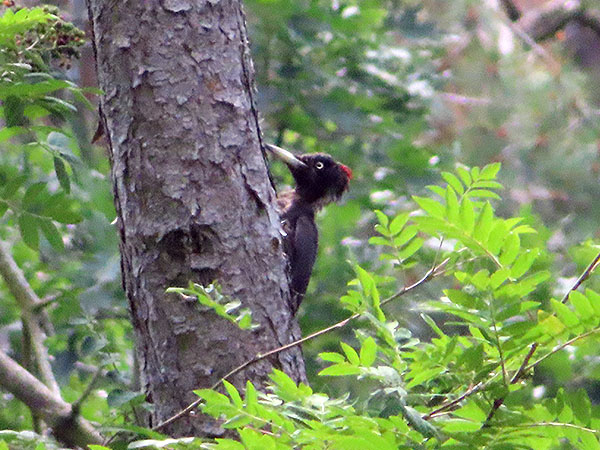
YLSNHM01001 ist ein winziges Bernsteinfossil (ca. 2,5 x 1,8 cm), das Teile eines Vogelfußes bzw. Reste der Haut die diesen Fuß einst umgab, inklusive einer der Fußkrallen sowie Teile der Schwanzfedern umfasst.
Trotz der schlechten Erhaltung steht fest, dass es sich hierbei um einen enantiornithiden Vogel handelt sowie ebenfalls um eine bislang unbekannte Art.
Der Fuß (inklusive der Krallen) hat eine Länge von ca. 1,5 cm. Der vierte Zeh des Fußes ist in seinem Umfang etwa doppelt so groß wie die übrigen Zehen, so weit diese zu erkennen sind. Er erscheint auffällig geschwollen, und eventuell litt dieser Vogel an einer Infektion dieses Zehs. Es ist aber auch möglich, dass es sich hierbei um Verwesungsspuren handelt, worauf auch zahlreiche warzenartig aussehende Blasen hindeuten, die sich entlang der erhaltenen Hautpartien erkennen lassen.
Der Gesamtbau des Fußes lässt darauf schließen, dass YLSNHM01001 ein kleiner insektenfangender Miniaturraubvogel gewesen sein dürfte. [1]
*********************
Referenzen:
[1] Lida Xing; Ryan C. McKellar; Jingmai K. O’Connor; Kecheng Niu: A mid-Cretaceous enantiornithine foot and tail feather preserved in amber. Scientific Reports 9 (1): 1–8. 2019
[2] A. D. Clark; J. K. O’Connor: Exploring the ecomorphology of two Cretaceous enantiornithines with unique pedal morphology. Frontiers in Ecology and Evolution 9: 654156. doi: 10.3389/fevo.2021.654156. 2021
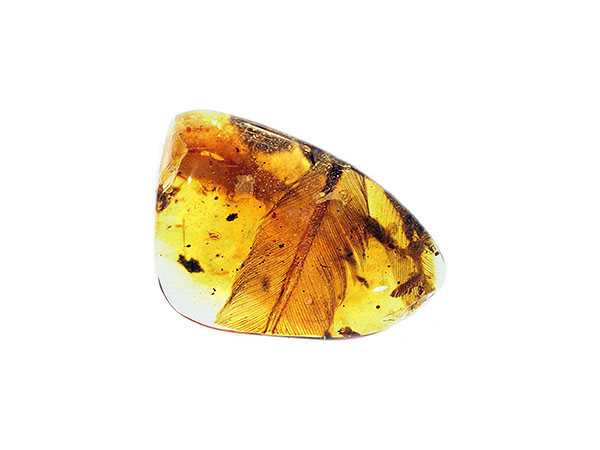
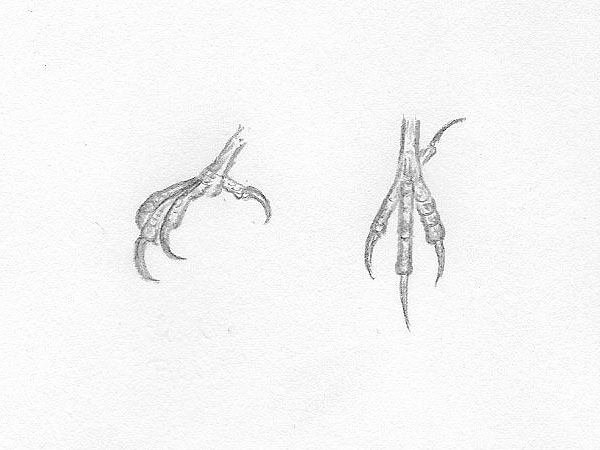
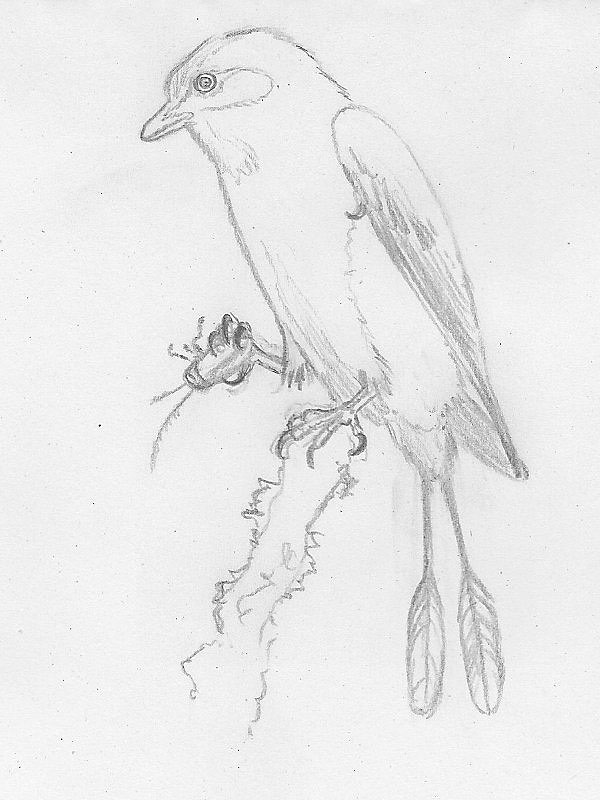
*********************
bearbeitet: 19.06.2021

*********************
bearbeitet: 02.05.2021
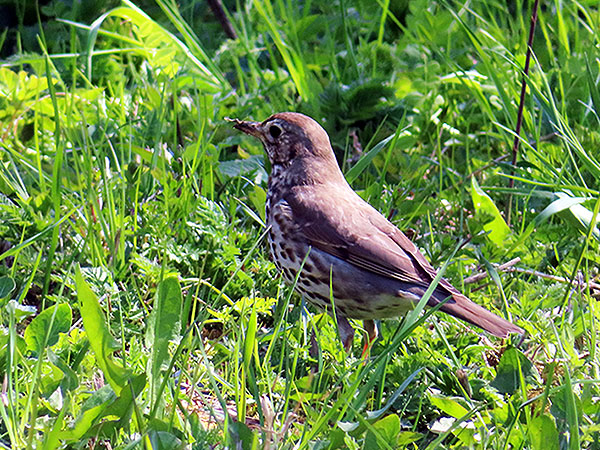
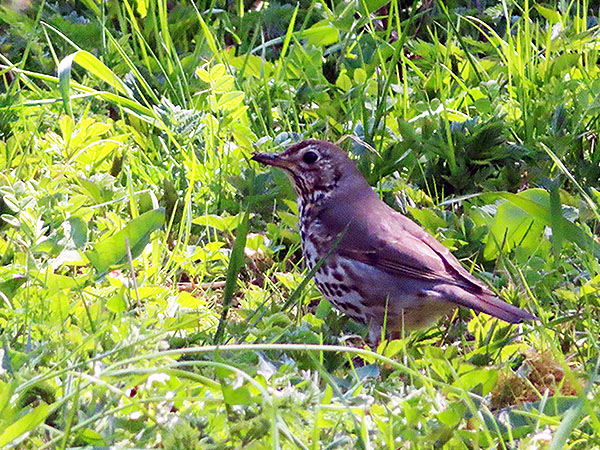
*********************
bearbeitet: 28.04.2021

*********************
bearbeitet: 28.04.2021
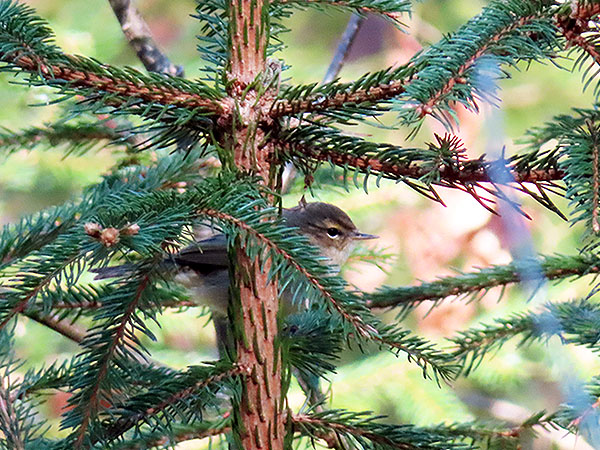
*********************
bearbeitet: 28.04.2021

*********************
bearbeitet: 28.04.2021
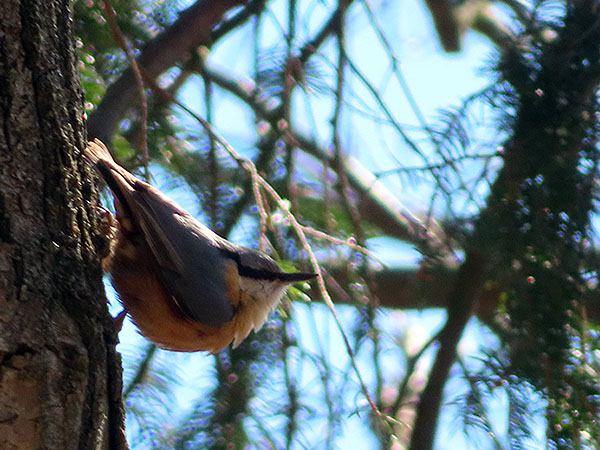
**********************
bearbeitet: 27.04.2021
Apterygidae
Apteryx littoralis Tennyson & Tomotani [1]
Proapteryx micromeros Worthy et al.
*********************
Quelle:
[1] Alan James Drummond Tennyson; Barbara Mizumo Tomotani: A new fossil species of Kiwi (Aves: Apterygidae) from the mid-Pleistocene of New Zealand. Historical Biology: An International Journal of Paleobiology 2021
*********************
bearbeitet: 24.04.2021
Feldsperlinge gehören zu meinen absoluten Lieblingsvögeln, wenn man genau hinschaut kann man in ihrem kastanienbraunen Käppchen einen ganz zarten Hauch von Violett erkennen.
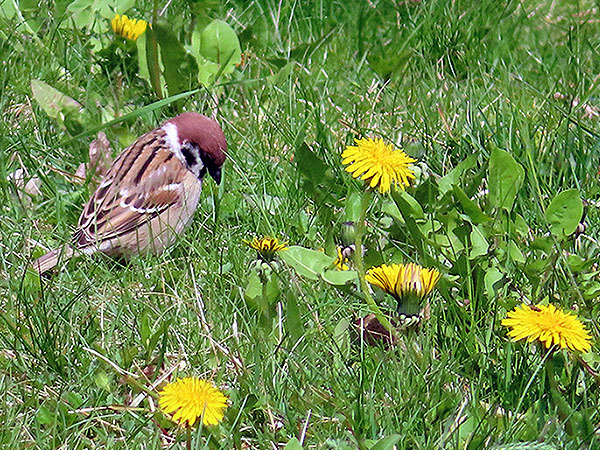
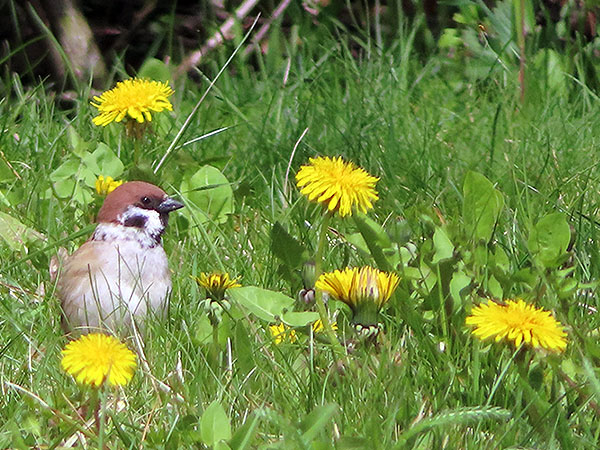
*********************
bearbeitet: 25.04.2021
Neben dem Mäusebussard sieht man hier oft Rotmilane (Milvus milvus) und immer häufiger Weihen, vermutlich Rohrweihen (Circus aeruginosus), die man an ihrem einzigartigen Flugstil erkennen kann (wenn man ihn einmal gesehen und sich eingeprägt hat). 🙂
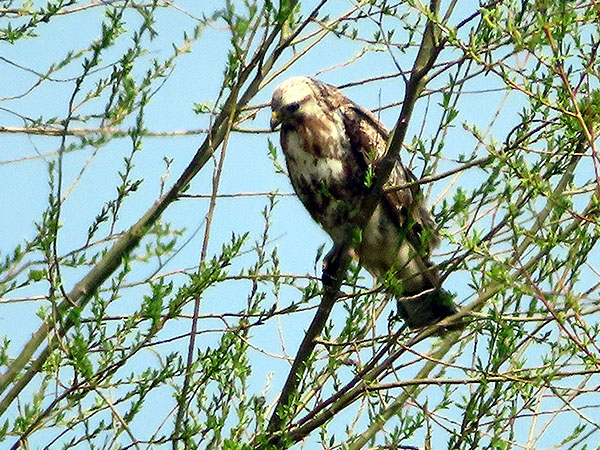
*********************
bearbeitet: 25.04.2021
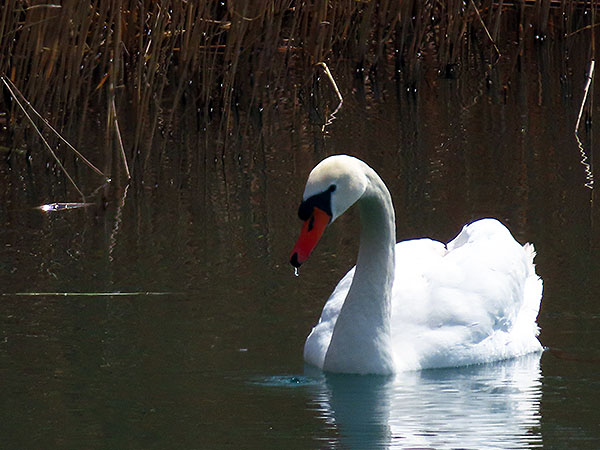
*********************
bearbeitet: 25.04.2021

*********************
bearbeitet: 25.04.2021
Der Schwarzkehltrogon (Trogon rufus Gmelin) wurde untersucht und dabei wurde festgestellt, dass drei seiner fünf anerkannten Unterarten Artstatus erhalten sollten, außerdem wurde noch eine neue Form beschrieben.:
Kerrs Schwarzkehltrogon (Trogon cupreicauda (Chapman))
Alagoas-Schwarzkehltrogon (Trogon muriciensis Dickens et al.)
Anmutiger Schwarzkehltrogon (Trogon tenellus Cabanis)
Südlicher Schwarzkehltrogon (Trogon chrysochloros Pelzeln)
*********************

*********************
Quelle:
[1] Jeremy Kenneth Dickens, Pierre-Paul Bitton, Gustavo A Bravo, Luís Fábio Silveira. Species limits, patterns of secondary contact and a new species in the Trogon rufus complex (Aves: Trogonidae). Zoological Journal of the Linnean Society 169. 2021
*********************
bearbeitet: 23.04.2021

*********************
bearbeitet: 17.04.2021

*********************
bearbeitet: 16.04.2021
Dieses nette kleine Vögelchen, welches in etwa eine Länge von nicht ganz 20 cm erreicht haben dürfte, stammt aus Schichten, die sich auf ein Alter von 122 Millionen Jahren datieren lassen.
Die Art ist bislang wohl nur anhand eines einzigen Skelettes bekannt, das dafür aber vollständig ist; das Gefieder ist allerdings nicht erhalten.
Der Schnabel, wenn man das Schnäuzchen denn so nennen möchte, war leicht abwärts gebogen und trug ganz vorn noch ein paar winzige Zähnchen. [1]
*********************

*********************
Quelle:
[1] Li Li; Jinqi Wang; Xi Zhang; Shilin Hou: A new enantiornithine bird from the lower Cretaceous Jiufotang Formation in Jinzhou Area, western Liaoning Province, China. Acta Geologica Sinica 86(5): 1039-1044. 2012
*********************
bearbeitet: 13.04.2021
Hinter dieser Buchstaben- und Nummernfolge verbirgt sich ein interessantes Vogelfossil aus der Unteren Kreide Chinas.
Das Fossil besteht aus dem hinteren Teil des Vogels, der Kopf und Teile des Vorderskelettes fehlen, Federn sind ebenfalls erhalten, und hier fallen vor allem einige relativ lange Federn an den Unterschenkeln auf, die etwa die halbe Länge des Beinknochens aufweisen.
Die Art wurde bislang offenbar nicht beschrieben oder benannt, ist aber in Matthew P. Martyniuks “A Field Guide to Mesozoic Birds and other Winged Dinosaurs” abgebildet, wobei ich die hier dargestellten Beinfedern am entsprechenden Fossil vermisse. Die Federn am Fossil ähneln eben nicht den Körper- oder Flugfedern wie im Buch dargestellt, sondern weisen einen sehr viel einfacheren Aufbau auf. Alles in allem erinnern diese Beinfedern sehr an die heutiger Vögel wie z.B. einigen Greifvogelarten, sie dürften daher keinen besonderen Einfluss auf die Flugeigenschaften des Vogels gehabt haben.
*********************
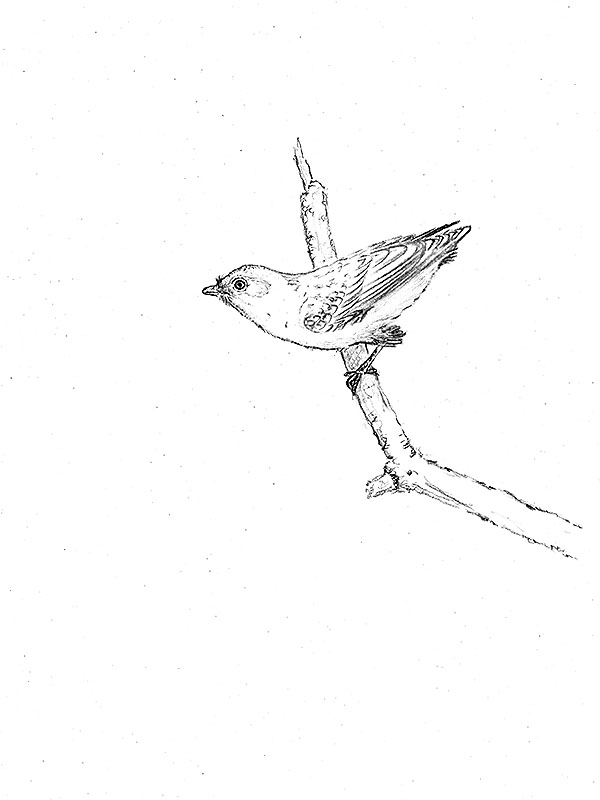
*********************
Quellen:
[1] Fucheng Zhang; Zhonghe Zhou: Leg feathers in an Early Cretaceous bird. Nature 431: 925. 2004
[2] Matthew P. Martyniuk: A Field Guide to Mesozoic Birds and other Winged Dinosaurs. Pan Aves 2012
*********************
bearbeitet: 12.04.2021
Dieser immer noch recht rätselhafte Vogel, auch bekannt als “Ornithurine C”, wird in einer Studie aus dem Jahr 2011 erwähnt, die sich mit dem Aussterben mehrerer Vogel-Kladen am Ende der Kreidezeit befasst. [1]
Die Art scheint anhand von mindestens vier Coracoiden bzw. Überresten davon bekannt zu sein, die als “SDSM 64281A”, “SDSM 64281B”, “UCMP 175251” und “MOR 2918” bezeichnet werden und die überwiegend aus Schichten der späten Kreidezeit stammen, aber eben auch aus Schichten, die dem untersten Paläozän zugeordnet werden können.:
“One of these species, Ornithurine C, is known from the Paleocene and therefore represents the only Maastrichtian bird known to cross the K–Pg boundary.” [1]
Übersetzung:
“Eine dieser Arten, Ornithurine C, ist aus dem Paläozän bekannt und stellt daher den einzigen Maastricht-Vogel dar, von dem bekannt ist, dass er die K/T-Grenze überschreitet.”
***
Laut den Autoren könnte diese Art mit einer Art identisch sein, die als Graculavus augustus Hope bezeichnet wurde, ein Vogel, der anscheinend zu den Charadriiformes gehört, sich aber sehr von allen heute lebenden charadriiformen Vögeln unterschied, zu Lebzeiten muss er an eine Art Riesen-Brachvogel oder -Triel erinnert haben. [2]
Die Art ist tatsächlich die einzige bisher bekannte Vogelart, der es gelungen ist das Massensterben am Ende der Kreidezeit zu überleben!
*********************
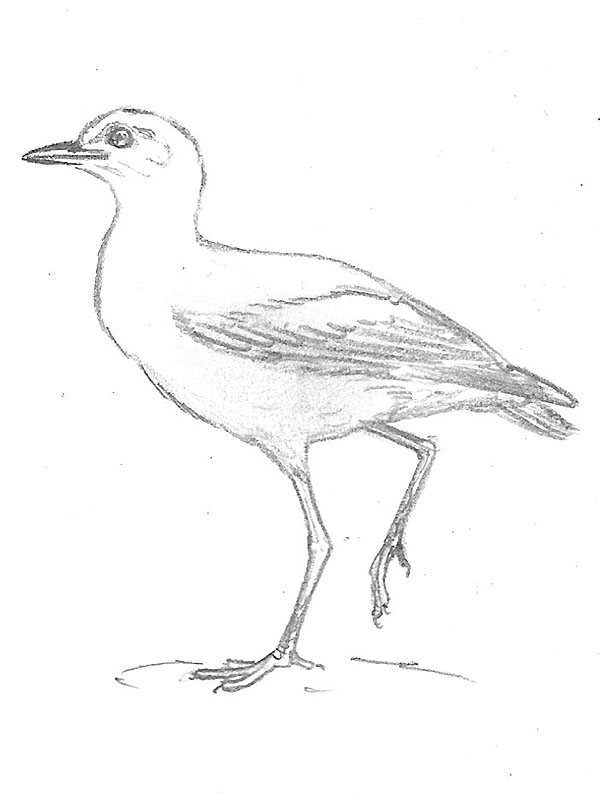
*********************
Quellen:
[1] Nicholas R. Longrich; Tim Tokaryk; Daniel J. Field: Mass extinction of birds at the Cretaceous-Paleogene (K-Pg) boundary. PNAS 108 (37) 15253-15257. 2011
[2] Nicholas R. Longrich; Tim Tokaryk; Daniel J. Field: Mass extinction of birds at the Cretaceous-Paleogene (K-Pg) boundary. PNAS 108 (37) 15253-15257. 2011. Supplementary Information
*********************
bearbeitet: 12.04.2021
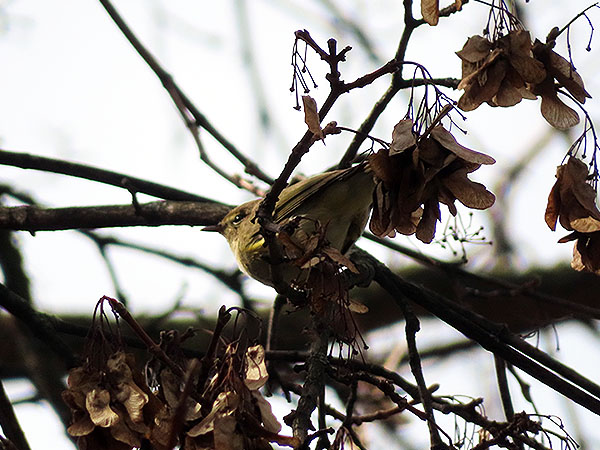
*********************
bearbeitet: 11.04.2021

*********************
bearbeitet: 11.04.2021
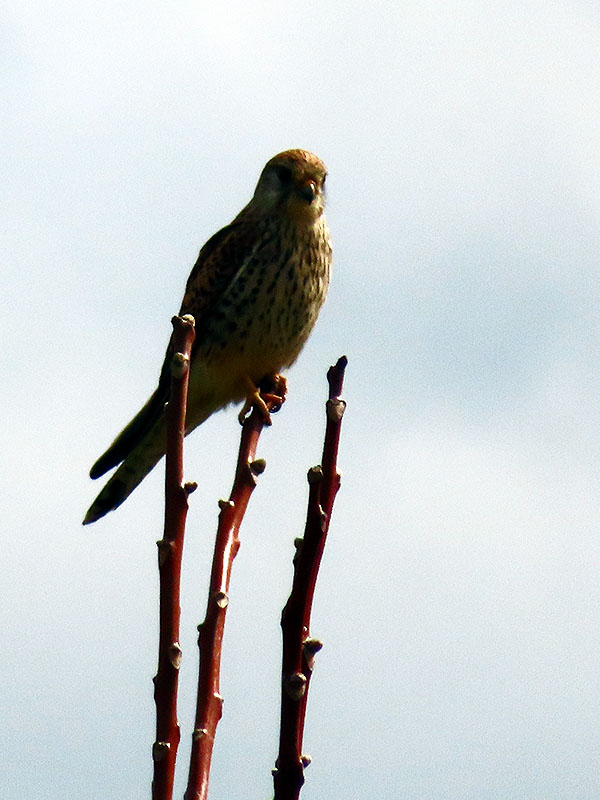
*********************
bearbeitet: 11.04.2021
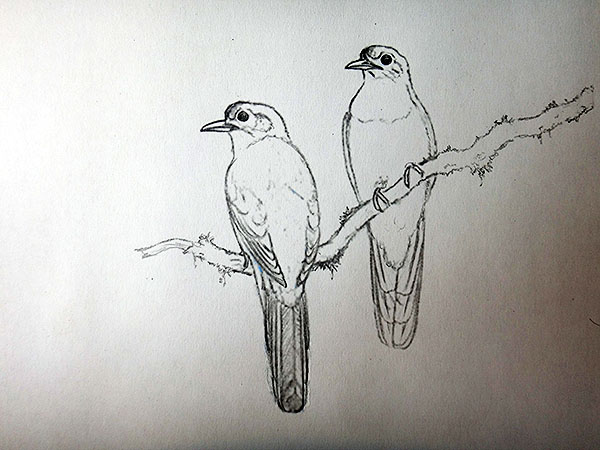
Würde man eine Zeitreise ins miozäne Europa unternehmen, etwa vor 23 bis 16 Millionen Jahren, würde man sich alsbald wundern ob man wirklich noch in Europa ist oder doch in Afrika; zahlreiche der heute nur noch in Afrika vorkommenden Vogelfamilien waren damals auch weit nördlich der Sahara zu finden, die Baumhopfe sind eine dieser Vogelfamilien.
Der Kiefernrenner (so die Übersetzung seines wissenschaftlichen Namens) erreichte eine Länge von etwa 20 cm, ansonsten ähnelte die Art wohl weitgehend den heutigen Baumhopfen. [1]
*********************
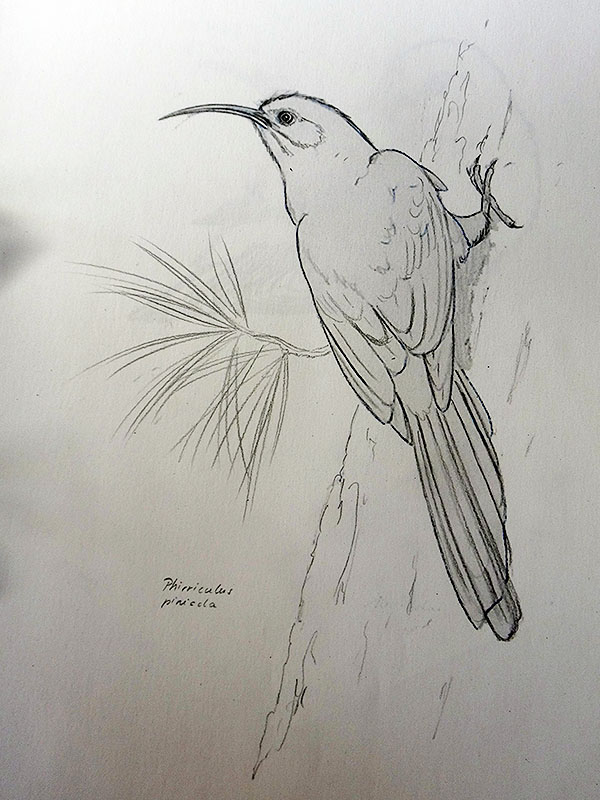
*********************
Quelle:
[1] Jiří Mlíkovský; Ursula B. Göhlich: A new wood-hoopoe (Aves: Phoeniculidae) from the early Miocene of Germany and France. Acta Soc. Zool. Bohem 64: 419-424. 2000
*********************
bearbeitet: 03.04.2021
Motmots, wegen ihrer gezähnten Schnabelkanten auch Sägeracken genannt, sind heute mit einigen Arten in Süd- und vor allem Zentralamerika verbreitet, alle Arten sind ausgesprochen farbenfroh.
Diese bislang älteste bekannte Art war offenbar kleiner als die kleinste der heute lebenden Motomot-Arten (sie erreicht in meiner Rekonstruktion eine Größe von nur etwa 13 cm, abhängig von der Länge der Schwanzfedern).
*********************
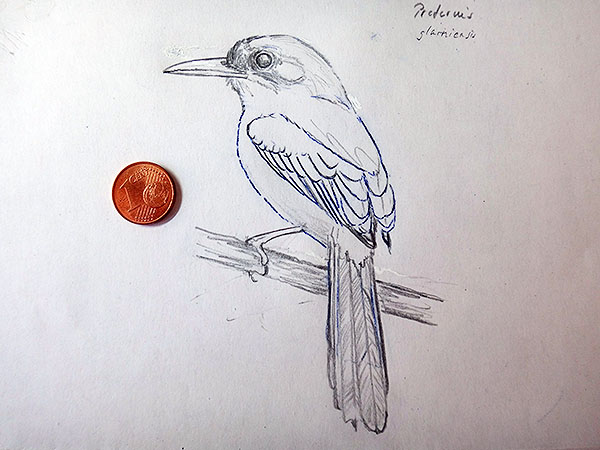
*********************
bearbeitet: 02.04.2021
Riesentrogon (Trogon gigas Vieill.)
Ursprünglich ist diese Form wohl anhand von drei oder vier Exemplaren bekannt, über deren Verbleib offenbar nichts bekannt ist.
“Ganze Oberseite, Kehle und Halsseiten glänzend goldgrün, Brust und Bauch weiss; Schwanz oben goldgrün unten graulich-weiss, Flügelmitte fein schwärzlich grün und weiss quergestreift, Schwingen braunschwarz, Schnabel gelb, Füsse braun.” [2]
Der Vogel soll eine Größe von 18 Inches erreicht haben, das entspricht etwas über 45 cm, wirklich sehr groß für einen Trogon; er soll aus Asien stammen, wobei die genaue Herkunft nicht bekannt ist (entweder Java oder Molukken).
***
Der folgende Text stammt von keinem Geringeren als François Le Vaillant (1753-1824).:
“I have only seen three specimens of this fine species; one in the collection of M. Carbintus at the Hague, a second at Rotterdam in the possession of M. Gevers, and another in the large and splendid collection of my friend M. Temminck at Amsterdam. This individual, from which our figure was taken, was sent along with many other birds from Java. I have seen a fourth specimen in the Paris Museum; but as it was in an imperfect state, it has not as yet been placed in the gallery.” [1]
Übersetzung:
“Ich habe nur drei Exemplare dieser schönen Art gesehen; eine in der Sammlung von M. Carbintus in Den Haag, eine zweite in Rotterdam im Besitz von M. Gevers und eine weitere in der großen und prächtigen Sammlung meines Freundes M. Temminck in Amsterdam. Dieses Individuum, anhand dessen unsere Abbildung angefertigt wurde, wurde zusammen mit vielen anderen Vögeln aus Java geschickt. Ich habe ein viertes Exemplar im Pariser Museum gesehen; aber da es unvollkommen war, wurde es noch nicht in die Galerie aufgenommen.“
***
Es könnte sich natürlich um eine tatsächlich existierende Art handeln, die mittlerweile ausgestorben ist; es ist aber durchaus wahrscheinlicher, dass es sich auch hierbei um eine der künstlich zusammengebauten ‘Arten’ handelt, die in den ornithologischen Abhandlungen des F. Le Vaillant aus dem ausgehenden 18. Jahrhundert offenbar gehäuft auftauchen ….
*********************
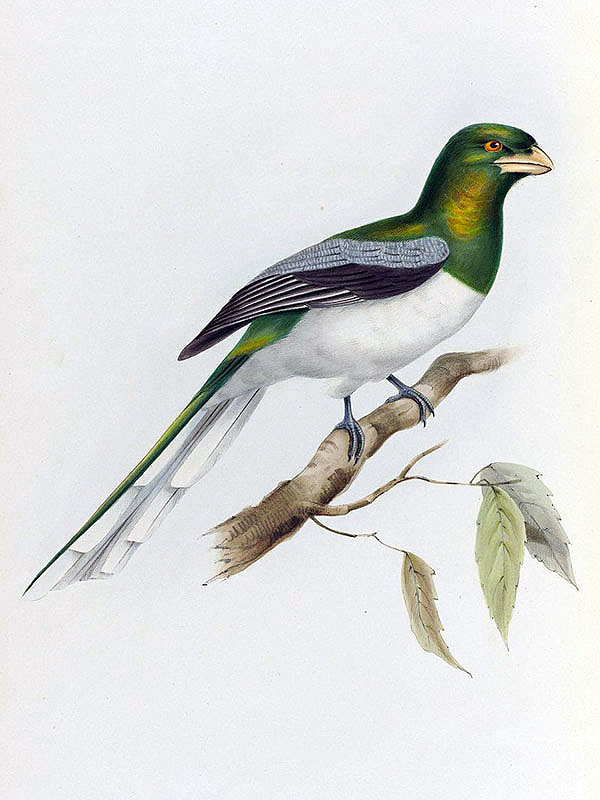
*********************
Quellen:
[1] John Gould: A monograph of the Trogonidae, or family of trogons. London: the author 1835-1838
[2] Jean Louis Cabanis; Ferdinand Heine: Museum Heineanum: Verzeichniss der ornithologischen Sammlung des Oberamtmann Ferdinand Heine, auf Gut St. Burchard vor Halberstadt. Halbertstadt: in Commission bei R. Frantz 1850-1863
*********************
bearbeitet: 01.04.2021
Diese Fotos zu ‘schießen’ war gar nicht so einfach, das Vögelchen war sehr geschäftig und für jedes gelungene Bild gibt es mindestens drei misslungene. 🙂

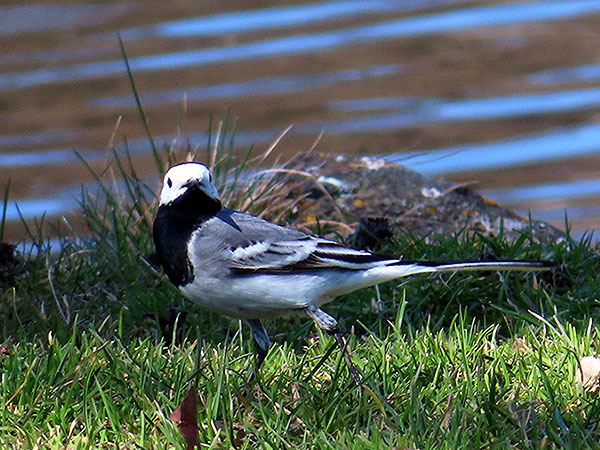
*********************
bearbeitet: 31.03.2021
Die Buchfinken singen gerade überall im Wald, allerdings singen nur die Männchen.
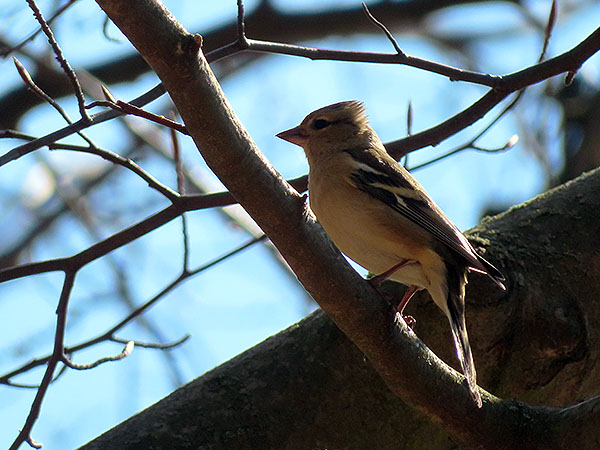
*********************
bearbeitet: 31.03.2021
Meisen sind ziemlich schwer zu fotografieren, sie lassen einen nicht wirklich nah an sicher heran und halten auch kaum länger als eine Sekunde still.
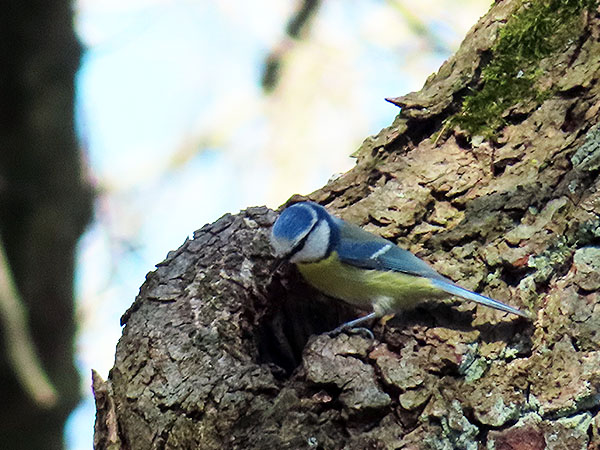
*********************
bearbeitet: 31.03.2021

*********************
bearbeitet: 31.03.2021

*********************
bearbeitet: 31.03.2021
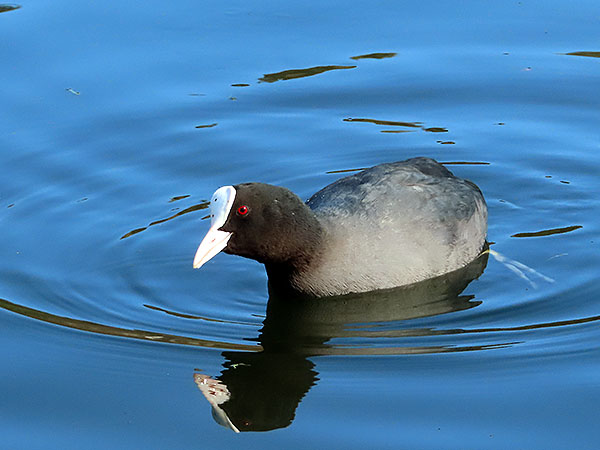
*********************
bearbeitet: 31.03.2021
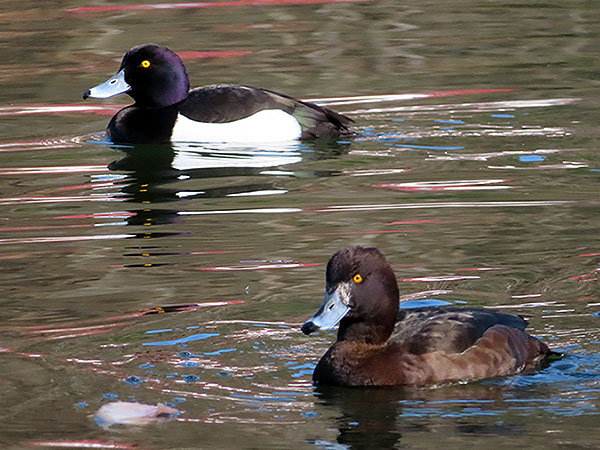
*********************
bearbeitet: 31.03.2021
Lady Tavistocks Sittich (Barnardius crommelinae Mathews)
Diese eigentlich vollkommen unbekannte ‘Art’ ist nur anhand eines einzigen Exemplars bekannt, eines Weibchens, das offenbar eine Zeitlang im Aviarium des Marquis of Tavistock in Gefangenschaft gehalten und nach dessen Frau benannt wurde. [1]
Es handelt sich hierbei offenbar um einen Barnardsittich (Barnardius barnardi (Vigors & Horsfield)) dem große Teile der gelben Areale fehlen. [2]
*********************
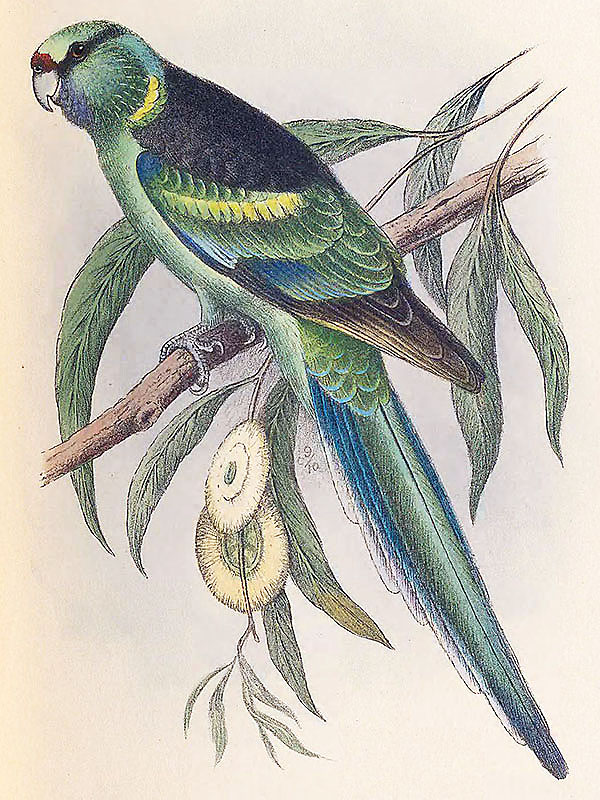
*********************
Quelle:
[1] Gregory M. Mathews: A new form of Barnardius. Bulletin of the British Ornithologists’ Club 46(299): 21. 1925
[2] Julian P. Hume: Extinct Birds. Bloomsbury Natural History; 2nd edition 2017
*********************
bearbeitet: 27.03.2021
Obskurer Papagei (Psittacus obscurus)
Der so genannte Obskure Papagei, der eigentlich besser Dunkler Papagei heißen sollte wurde ursprünglich im Jahr 1757 durch Fredric Hasselquist bzw. Carl von Linné beschrieben, dies ist die Beschreibung.:
“PSITTACUS (obscurus) niger, vertise cinereonigrescente vario, cauda cinerea.
CAPUT oblongum, lateribus compressum, dorso depressum, respectu corporis satis magnum.
Rostrum totum latum, crassum, obtusissimum, aduncum, capite triplo brevius. Maxilla superior subconvexa, inferius latiuscula, dorsum versus magis contracta, mobilis. Ad basin maxillae superioris infra nares sulcus conspieitur, quasi imbricata esset pergit. Apex maxillae superioris aduncus extra maxillam inferiorem, quo ad quartam sui partem extensus, extremitate obtusiusculus. Lobulus utrinque ad basin apicis, maxillae inferiori dum clauditur os, supra impositum, Maxilla inferior superiore crassior, magis comnvexa, brevior, quantitate apicis superioris, basi subtus gula distans, posterius aequalis; apice obtusa & fere emarginata; sinus semicircularis ad basin apicis. Nares proxime supra rostrum, perfecte circulares, magnitudine pennae gallinaceae.
Oculi vertici quam gulae, naribus etiam quam basi capitis propiores. Iris flava. Pupilla nigra. Area oculorum usque a fine maxillae superioris ad initium verticis latitudine, & a naribus, fere usque ad basin verticis longitudine nuda, rugosa, pilis vix conspicuis obsita.
Aurium apertura oblonga, transversalis, ab oculis aequali spatio, ut oculi a naribus, distans, basi capitis quam vertici multo propior, plumis tenuibus & membrana retractilis tecta.
Remiges circiter 20:1, 2 reliquis longiores; 3, 4, 5, paulo breviores, aequales; 6. 7. 8 ordine decrescentes; reliqui aequales breviores.
CAUDA cuneiformis. Rectrices circiter 10, laterales breviore intermedii longioribus.
PEDES, crura plumosa, usque ad flexuram tarsi.
Digiti 4: antici 2 & postici 2; ex anterioribus internus exteriori tribus articulis brevior est posterioribus, interior exteriori dimidio brevior; omnes digiti squamosi, squamis imbricatis, articulis duobus insimis impositis; reliqua pars pedis tuberculata, tuberculis levibus, circularibus, parum elevatis.
Lingua crassa, apice obtusissima & fere semicirculari, lateribus marginata, marginibus fursum inflexis, unde canaliculata evadit.
Ungues adungi, obtusiusculi.
COLOR: Rostrum nigrum. Area oculorum alba. Vertex ex cinereo & nigrescente variegatus. Colum & Alae supra nigra.
Abdomen & crura cinerea, cum lineis transversalibus canis. Tubercula pedum nigra. Ungues nigri. Cauda tota cinerea.
MAGNITUDO Graculi.” [1]
***
Ich muss gestehen, dass ich meine Übersetzungsversuche hier aufgegeben habe da sie nirgendwohin führten.
Wie dem auch sei, John Latham, der bekannte Autor vieler Vogelbücher des späten 18./frühen 19. Jahrhunderts, führt die Art im 2. Teil seines Werkes “A general history of birds”.:
“SIZE of a Jay. Bill black, the feathers round the base of it black, rough, and beset with hairs; space round the eye white; irides yellow; crown variegated cinereous and black; upper parts of the neck and wings black; belly and thighs cinereous, marked with transverse hoary lines; tail wholly ash-coloured, cuneiform; legs tuberculated, black; toes the same; claws crooked, and black.
Inhabits Africa. The only one who has described this is Hasselquist, from whom Linnaeus had his account; as to that which the latter refers in Brisson, it is quite a different species, and he mentions it as such in his last Mantissa.” [2]
Übersetzung:
“GRÖßE eines Hähers. Schnabel schwarz, die Federn rund um die Basis schwarz, rau und mit Haaren besetzt; Bereich um das Auge weiß; Iriden gelb; Scheitel grau und schwarz variegiert; obere Teile des Halses und Flügel schwarz; Bauch und Oberschenkel grau, markiert mit quer verlaufenden grauen Linien; Schwanz ganz aschfarben, keilförmig; Beine höckerig, schwarz; Zehen gleich; Krallen krumm und schwarz.
Bewohnt Afrika. Der Einzige, der ihn beschrieben hat, ist Hasselquist, von dem Linnaeus seinen Bericht hatte; worauf sich letzterer in Brisson bezieht, so handelt es sich um eine ganz andere Art, und er erwähnt sie in seiner letzten Mantisse als solche.“
***
Der Vogel wird Psittacus genannt und mag mit dem Graupapagei (Psittacus erithacus L.) und dem Timneh-Papagei (Psittacus timneh Fraser) verwandt gewesen sein; aber halt! Nahezu sämtliche Papageien wurden ursprünglich als Psittacus beschrieben, so dass dieser Name ebenfalls nirgendwo hinführt, es ist nicht einmal sicher, dass es sich hier überhaupt um einen Papagei handelt.
*********************
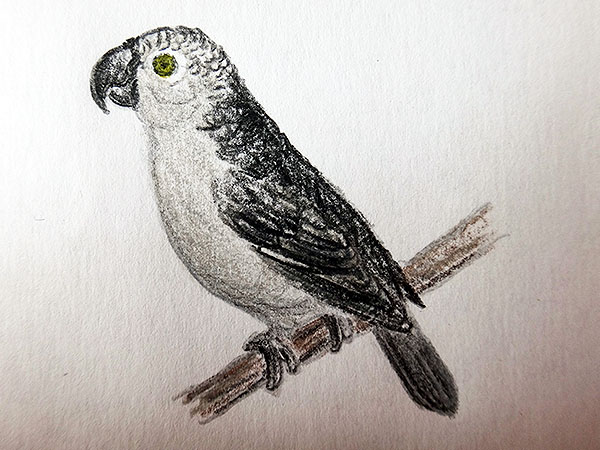
*********************
Quellen:
[1] Fredric Hasselquists: Iter Palæstinum, eller Resa til Heliga Landet, förrättad ifrån år 1749 til 1752, med beskrifningar, rön, anmärkningar, öfver de märkvärdigaste naturalier, på Hennes Kongl. Maj:ts befallning, utgiven af Carl Linnaeus. Stockholm: Trykt på L. Salvii kåstnad 1757
[2] John Latham: A general history of birds. Winchester: printed by Jacob and Johnson, for the author: — sold in London by G. and W. B. Whittaker, Ave-Maria-Lane; John Warren, Bond Street, W. Wood, 428, Strand; and J. Mawman, 39, Ludgate-Street 1821-1828
[3] Julian P. Hume: Extinct Birds. Bloomsbury Natural History; 2nd edition 2017
*********************
edited: 26.03.2021
Purpurnaschvogel (Chlorophanes purpurascens Sclater & Salvin)
Diese ‘Art’ wurde im Jahr 1873 beschrieben, es ist nur ein einziges Exemplar bekannt, welches offenbar irgendwo in Venezuela gefunden wurde; einer anderen Quelle zufolge in Trinidad. [1][2]
Es handelt sich hierbei tatsächlich um einen Hybriden mit dem Kappennaschvogel (Chlorophanes spiza (L.)) und dem Türkisnaschvogel (Cyanerpes cyaneus (L.)) als Elternarten. [2]
*********************
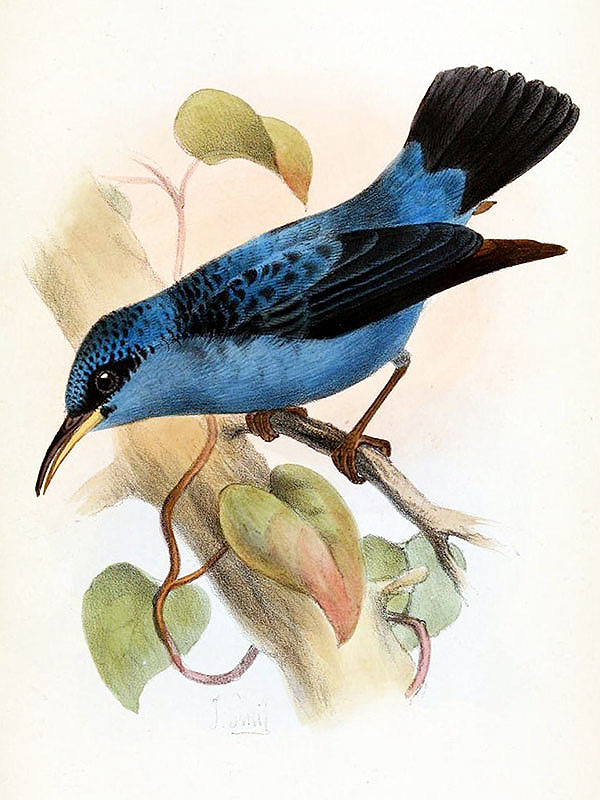
*********************
bearbeitet: 25.03.2021
*********************
Quellen:
[1] Philip Lutley Sclater: Catalogue of the Passeriformes, or perching birds, in the collection of the British Museum. Fringilliformes: part II; containing the families Coerebidae, Tanagridae, and Icteridae. London 1886
[2] Julian P. Hume: Extinct Birds. Bloomsbury Natural History; 2nd edition 2017
Mähnenparadiesvogel (kein wissenschaftlicher Name)
“LENGTH ten inches. Bill one inch and a quarter long, a trifle bent, and dusky, the base surrounded with velvet-like black feathers, covering the nostrils; top of the head, even with the eye, and to the beginning of the back, deep green, varying to bright green in some lights; the feathers of a plush-like texture; those on the hind part of the neck are long, pointed, and like hackles, but on the chin and throat they are similar to those on the crown, and both appear, in some lights, to be scaly, either indigo or green, and glossy, like metal; on each side of the neck is a stripe of blue, dividing the green above and below, and coming forwards to the breast, where it occupies a broad space; on the middle of the crown arise four bristles, near two inches long, tending backwards; upper part of the back, and wings, greenish black, in some lights appearing quite black; from the breast to the vent deep, dull ash-colour; tail even at the end, and three inches in length, the two middle feathers dull green, pointed at the tips; the others dusky within, and green on the outer webs, and all of them curve a little outwards; legs scaly; claws black, and hooked, though not very stout.
Native place uncertain; in the collection of General Davies.” [1]
Übersetzung:
“LÄNGE zehn Zoll [ca. 25,5 cm]. Schnabel einen Zoll und ein Viertel lang, eine Kleinigkeit gebogen und düster, die Basis von samtartigen schwarzen Federn umgeben, die die Nasenlöcher bedecken; Oberseite des Kopfes, in Augenhöhe, und bis zum Anfang des Rückens, tiefgrün, in bestimmtem Licht bis hellgrün variierend; die Federn von einer plüschartigen Textur; die am hinteren Teil des Halses sind lang, spitz und wie eine Mähne, aber am Kinn und am Hals ähneln sie denen auf dem Scheitel, und beide erscheinen in bestimmtem Licht schuppig, entweder Indigo oder Grün, und glänzend wie Metall; Auf jeder Seite des Halses befindet sich ein blauer Streifen, der das Grün oben und unten teilt und nach vorne zur Brust kommt, wo er einen weiten Raum einnimmt; in der Mitte des Scheitels stehen vier Borsten, die fast zwei Zoll lang sind und nach hinten tendieren; oberer Teil des Rückens und Flügel, grünlich schwarz, in bestimmtem Licht, ziemlich schwarz erscheinend; von der Brust bis zum Rumpf tief, matt aschefarben; Schwanz gerade am Ende und drei Zoll lang, die beiden mittleren Federn mattgrün, spitz; die anderen sind innen dunkel und auf den Außenfahnen grün, und alle krümmen sich ein wenig nach außen; Beine beschuppt; Krallen schwarz und gebogen, wenn auch nicht sehr kräftig.
Heimatort ungewiss; in der Sammlung von General Davies.”
***
Ich muss gestehen, dass ich keinerlei Ahnung habe womit wir es hier zu tun haben könnten, es könnte sich tatsächlich um einen Paradiesvogel(hybriden) handeln oder aber auch um einen vollkommen anderen Vogel, z. B. eine Starenart; am wahrscheinlichsten aber haben wir es hier mit einem der damals offenbar gar nicht so selten anzutreffenden Fälschungen zu tun, die aus allerlei Vogelteilen zusammengebaut und an den meistbietenden Kuriositätensammler verschachert wurden.
*********************

*********************
Quelle:
[1] John Latham: A general history of birds. Winchester: printed by Jacob and Johnson, for the author: — sold in London by G. and W. B. Whittaker, Ave-Maria-Lane; John Warren, Bond-Street, W. Wood, 428; and J. Mawman, 39, Ludgate-Street 1821-1828
*********************
bearbeitet: 25.03.2021

… wahrscheinlich war hier eine Katze zugange, ich habe sämtliche Teile des Vogels gesehen, die überall verstreut herumlagen. 🙁
*********************
bearbeitet: 24.03.2021
Schöner Hartschnabel (Sparactes superbus (Shaw))
“Von der Größe einer Drossel; der ganze obere Theil des Körpers schwarz, mit Ausnahme des Bürzels und der obern Deckfedern des Schwanzes, welche gelbgrünlich sind. Auf dem Kopfe steht ein vier Zoll langer Federbush aus zerschlissenen Federn bestehend, welche gegen den Schnabel gekehrt sind; die Kehle ist mit steifen Borsten besezt und lebhaft roth, mit einigen gelblichen Flecken nach unten; Brust und Bauch schwarz; über die Brust läuft ein Gürtel von lebhaftem Gelb, mit rothen Streifen, und an den Seiten mit schwarzen Punkten; der Schnabel ist eisengrau, die Füße blaulich und die Nägel schwarz.
Das Vaterland dieses Vogels ist unbekannt, das einzig vorhandene Exemplar wurde von Vaillant beschrieben und bekannt gemacht. Man will aber entdeckt haben, daß es ein künstlich zusammengesetzter Vogel sey, womit dann freilich diese Gattung ganz wegfallen würde.” [1]
***
Wie so viele nicht näher miteinander verwandte Vogelformen wurde auch diese zuerst einmal als eine Art Würger (Laniidae) beschrieben später aber unter anderem den Kuckucksvögeln (Cuculidae) zugeordnet, vielleicht aufgrund der zygodactylen Füße, die in den mir bekannten Abbildungen aber anisodactyl dargestellt wurden.
Bereits zu Beginn das 19. Jahrhunderts wurde dieser Vogel als eine Fälschung erkannt, vermutlich diente ein Senegal-Furchenschnabel (Lybius dubius (Gmelin)) als Ausgangsmaterial, ein Vogel also, der, obwohl er tatsächlich existiert, eigentlich schon absonderlich und unecht genug wirkt.
*********************
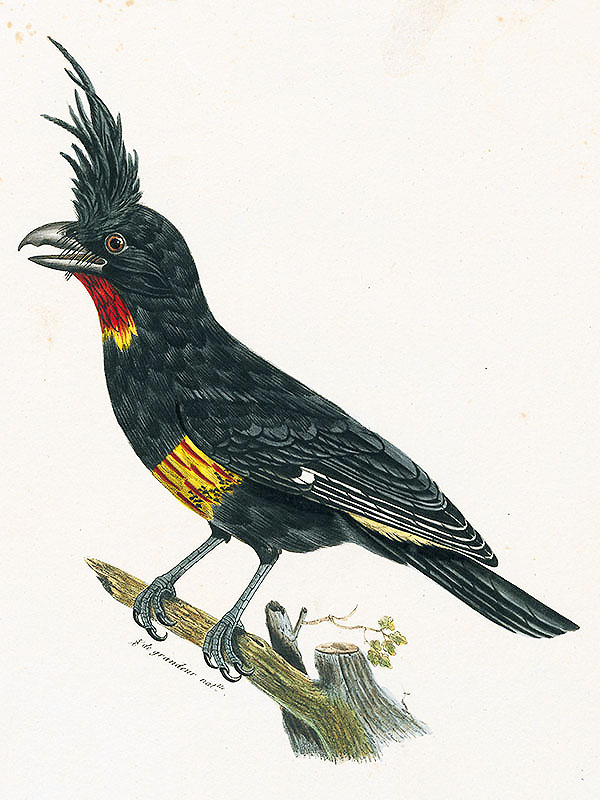
***
Witzigerweise findet die hier gezeigte Abbildung auch auf der Wikipedia-Seite über den Braun-Haubendickkopf (Ornorectes cristatus (Salvadori)) Verwendung, einer Vogelart, die tatsächlich existiert und vollkommen anders aussieht.
*********************
Quelle:
[1] H. R. Schinz; Joseph Brodtmann: Naturgeschichte und Abbildungen der Vögel: nach den neuesten Systemen bearbeitet. Leipzig: Weidmann’sche Buchhandlung 1836
*********************
bearbeitet: 23.03.2021
Karmesintaube (Columba rosea Miller & Shaw)
“Unter all dem schönen Hausgeflügel, welches uns Indien geliefert hat, ist die köstliche Karmesintaube gewiss der prächtigste Vogel. Sie ist eine Haustaube, und ohngefähr so gross wie die unsrigen. Ihr Gefieder ist hauptsächlich ein glänzendes Karmesin, welches sich an mehreren Stellen in ein schönes Rosenroth verläuft. Die Kehle, Scheitel, Augenkreise und Spitzen der Flügelfedern sind weiss, die Schwung- und Schwanzfedern aber braun. Die Ostindier halten diese prächtige Taube häufig für ihre schönen Hühnerhöfe.“
Dieser Text stammt aus einem Kinderbuch und behandelt eine der eigenartigsten mysteriösen Vogelformen überhaupt; tatsächlich taucht ihr Name immer einmal wieder in Auflistungen ausgestorbener Vogelarten auf – trotzdem hat sie jedoch wohl nie existiert.
Im 18. Jahrhundert war es keinesfalls selten in diversen wissenschaftlichen Schriften, und zwar nicht nur solchen für Kinder, allerlei ausgedachtes, mehr oder weniger fantastisch anmutendes unterzubringen um die geneigte Leserschaft angemessen zu unterhalten, darunter eben auch komplett ausgedachte Tierarten.
*********************

*********************
Quellen:
[1] F. J. Bertuch: Bilderbuch Für Kinder: enthaltend eine angenehme Sammlung von Thieren, Pflanzen, Blumen, Früchten, Mineralien, Trachten und allerhand andern unterrichtenden Gegenständen aus dem Reiche der Natur, der Künste und Wissenschaften; alle nach den besten Originalen gewählt, gestochen, und mit einer kurzen wissenschaftlichen, und den Verstandes-Kräften eines Kindes angemessenen Erklärung begleitet. Weimar, im Verlage des Industrie-Comptoirs 1802
[2] Pauline Knip: Les pigeons, par Madame Knip, née Pauline de Courcelles, le texte par C. J. Themminck. Paris: chez Mme. Knip 1838-1843
[3] Julian P. Hume: Extinct Birds. Bloomsbury Natural History; 2nd edition 2017
*********************
bearbeitet: 22.03.2021
San Domingo-Taube (Columba dominicensis Latham)
“Cette jolie espèce, dont Buffon a donné le premier une figure très exacte, habite, avec l’espèce du précédent article, les contrées méridionales du nouveau continent. Nous ne connoissons de cette Colombe que l’extérieur, dont nous donnerons une description succincte. La longueur totale de la Colombe à Moustache est de onze pouces; la queue est moins longue que dans les espèces dont nous venons de parler; elle est cependant à pennes d’inégale longueur, et présente la forme d’un cône. Le front et la région des yeux sont blancs; la gorge l’est aussi. Cette couleur se dirige sur une partie des côtés du cou, et se joint sur la nuque. Sur le haut de la tête est une large bande transversale noire, qui semble la partager en deux parties. De la base du bec se dirige, en passant sous les yeux, une moustache noire qui s’élargit vers son extrémité, et dont les plumes recouvrent l’orifice des oreilles: un large collier noir entoure le cou vers le milieu de sa longueur. La poitrine est de couleur vineuse; mais vers les parties latérales il y a des plumes pourprées à reflets métalliques: toutes les parties supérieures sont d’un brun-terreux. Sur les plumes scapulaires et les grandes couvertures sont quelques taches noires. Les rémiges sont noirâtres, bordées extérieurement de gris-blanc. Le ventre est brun-cendré; les pennes de la queue sont grises; toutes, excepté les deux du milieu, ont leur extrémité blanche: le bec est noir, et les pieds sont rougeâtres.
On trouve l’espèce à Saint-Domingue, et probablement aussi dans les autres parties de l’Amérique méridionale situées sous le même degré. Nous présumons que l’individu figuré par nous à cet article est le mâle de l’espèce: nous ne saurions cependant raffirmer. Le seul individu que nous ayons eu occasion de voir faisoit autrefois partie du Muséum Leverian, à Londres.” [1]
Übersetzung:
“Diese hübsche Art, von der Buffon als erster eine sehr genaue Abbildung lieferte, lebt zusammen mit der Art im vorherigen Artikel in den südlichen Regionen des neuen Kontinents. Wir kennen von dieser Taube nur das Äußere, von dem wir eine kurze Beschreibung geben werden. Die Gesamtlänge der Schnurrbarttaube beträgt elf Zoll [ca. 28 cm];der Schwanz ist kürzer als bei der gerade erwähnten Art; er besitzt jedoch Federn von ungleicher Länge und hat die Form eines Kegels. Stirn und Augenpartie sind weiß; der Hals auch. Diese Farbe verläuft an einem Teil der Seiten des Halses und verbindet sich im Nacken. Auf der Oberseite des Kopfes befindet sich ein breites schwarzes Querband, das ihn in zwei Teile zu teilen scheint. Von der Basis des Schnabels verläuft unter den Augen ein schwarzer Schnurrbart, der sich zum Ende hin erweitert und dessen Federn die Öffnung der Ohren bedecken: Ein großer schwarzer Kragen umgibt den Hals zur Mitte seiner Länge. Die Brust hat eine weinrote Farbe; aber zu den Seiten hin gibt es lila Federn mit metallischem Schimmer: Alle oberen Teile sind erdbraun. Auf den Schulter- und den größeren Flügeldecken befinden sich einige schwarze Flecken. Die Flugfedern sind schwärzlich und außen grauweiß eingefasst. Der Bauch ist aschbraun, die Schwanzfedern sind grau; Alle außer den beiden in der Mitte haben weiße Spitzen: Der Schnabel ist schwarz und die Füße rötlich.
Die Art kommt in Santo Domingo [Haiti/Hispaniola] und wahrscheinlich auch in anderen Teilen Südamerikas unter dem gleichen Grad vor. Wir gehen davon aus, dass das von uns in diesem Artikel vorgestellte Individuum das Männchen der Art ist. Dies können wir jedoch nicht bestätigen. Das einzige Individuum, das wir sehen konnten, war früher Teil des Leverian Museum in London.“
***
Diese ‘Art’ ist ursprünglich anhand einer Darstellung aus dem Jahr 1771bekannt, die dann wiederum als Vorlage für eine Beschreibung durch John Latham im Jahr 1790 diente und eben offenbar auch der oben wiedergegebenen aus dem 19. Jahrhundert. [2]
Interessant finde ich allerdings die Aussage der Autoren (Temminck und Knip) ein Exemplar gesehen haben zu wollen, das vormals Bestandteil der ehemaligen Leverianischen Sammlung in Leicester House in Westminster, London gewesen sein soll; außerdem fällt beim Lesen der Beschreibung auf, dass sie nicht so ganz zu der dazugehörigen Darstellung passen möchte.
*********************
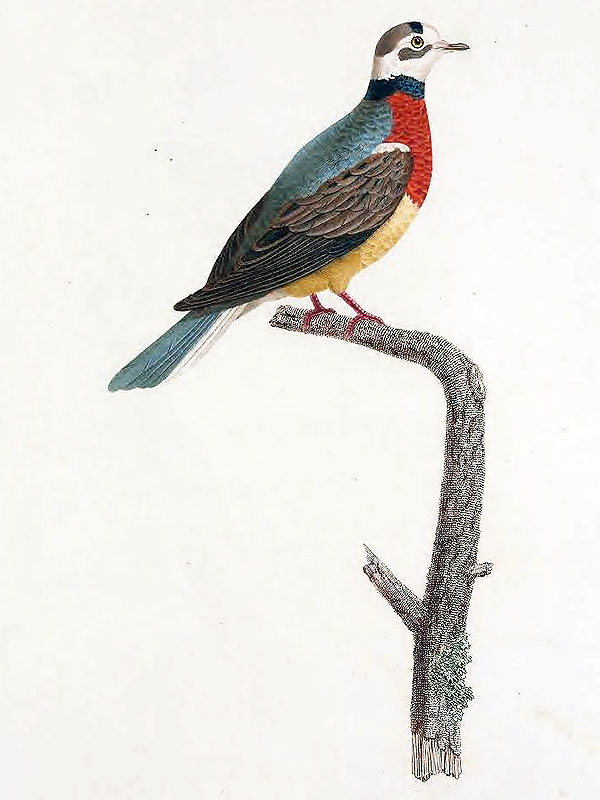
*********************
Quellen:
[1] Pauline Knip: Les pigeons, par Madame Knip, née Pauline de Courcelles, le texte par C. J. Themminck. Paris: chez Mme. Knip 1838-1843
[2] Julian P. Hume: Extinct Birds. Bloomsbury Natural History; 2nd edition 2017
*********************
bearbeitet: 22.03.2021
Azurtaube (Columba dorsocaerulea Temminck & Knip)
“Toutes les parties supérieures de cette jolie Colombe étant d’une brillante et vive couleur d’azur, nous en avons tiré son signalement spécifique. On nous a assuré que l’espèce habite au Bengale; ce dont nous ne saurions cependant garantir l’authenticité.
La longueur totale de la Colombe azurée est de neuf pouces; ses ailes atteignent à la moitié de la longueur de la queue, qui est arrondie.
Un bleu céleste ou couleur de turquoise orientale est répandu sur les parties supérieures; les joues et la gorge sont d’un blanc pur. On remarque sur le devant du cou et de la poitrine des teintes d’un brun fauve, nuancé d’un ton vineux; le ventre et l’abdomen sont blanchâtres; les pieds et le cercle nu qui enture les yeux sont rouges; la base du bec est rougèatre, mais la ointe est d’un blanc jaunâtre.
Un individu de cette belle espèce faisoit partie du cabinet de M. Holthuysen, à Amsterdam.” [1]
Übersetzung:
“Alle oberen Teile dieser hübschen Taube haben eine brillante und lebendige azurblaue Farbe, wir haben daraus ihre spezifische Beschreibung gezogen. Uns wurde versichert, dass die Art in Bengalen lebt, wir können jedoch die Echtheit nicht garantieren.
Die Gesamtlänge der Azurtaube beträgt 9 Zoll [ca. 23 cm]; ihre Flügel erreichen die halbe Länge des Schwanzes, der abgerundet ist.
Ein himmlisches Blau oder orientalisches Türkis ist auf den oberen Teilen verteilt; die Wangen und der Hals sind rein weiß. Man bemerkt auf der Vorderseite des Halses und auf der Brust ein Rehbraun, nuanciert mit einem weinroten Ton; die Brust und der Bauch sind weißlich; die Füße und der nackte Ring um die Augen sind rot; die Basis des Schnabels ist rötlich, aber die Schnabelspitze ist gelblich weiß.
Ein Individuum dieser schönen Art befand sich im Kabinett von Herrn Holthuysen in Amsterdam.“
Ich kann nicht wirklich sagen, was ich mit diesem Vogel anfangen soll, mit ziemlicher Sicherheit stammt er nicht aus Bengalen (im Nordosten Indiens) und mit ebenso ziemlicher Sicherheit handelt es sich bei dem (einzigen existierenden?) Exemplar im Kabinett des Herrn Holthuysen in Amsterdam um eine der damals nicht unüblichen gefälschten Stopfpräparate, die, wenn sie besonders gelungen waren, für durchaus nicht wenig Geld an interessierte Sammler seltener Schätze gebracht wurden.
Doch, da jenes Originalexemplar nicht mehr existiert, handelte es sich hierbei um eine gewöhnliche, eingefärbte Taube oder um einen vollkommen anderen Vogel, dem ein Taubenköpfchen aufgesetzt wurde? Dies werden wir wahrscheinlich nie erfahren.
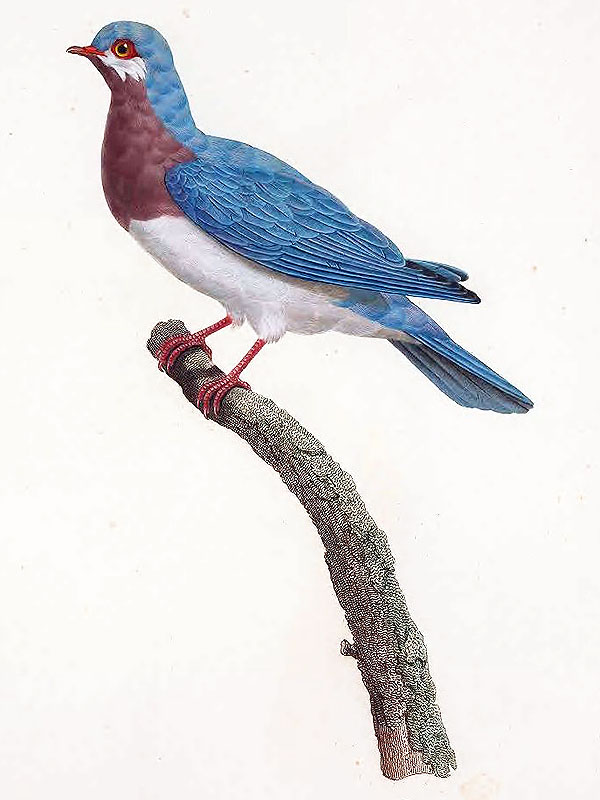
Es existieren auch Versionen dieses Gemäldes auf denen die weinroten Gefiederbereiche komplett grau und die Beine sehr blass, fast weißlich gefärbt sind.
*********************
Quelle:
[1] Pauline Knip: Les pigeons, par Madame Knip, née Pauline de Courcelles, le texte par C. J. Themminck. Paris: chez Mme. Knip 1838-1843
*********************
bearbeitet: 21.03.2021
Nauru-Ralle (Gallirallus sp.)
Nauru; die gesamte Insel war einst mit einem Substrat bedeckt, das zu großen Teilen aus Guano bestand, und vollkommen bewaldet.
Heute sieht sie so aus, eine raue und trostlose Karstlandschaft, die nicht natürlichen Ursprungs ist sondern menschgemacht.:
*********************
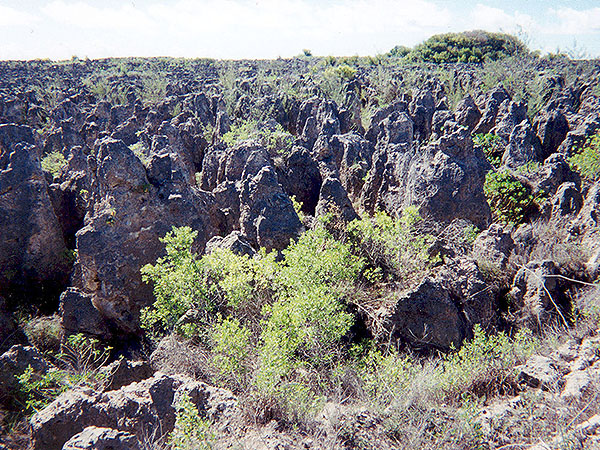
***
“Es gibt auch Vögel auf Nauru, wie Fregattvogel, schwarze Seeschwalbe, weiße Seeschwalbe, Regenpfeifer, Brachvogel, Möve, Schnepfe, Uferläufer, Ralle, Lachmöve und Rohrdrossel.” [1]
“Die Vogelwelt ist nach Zahl und Art reicher. Der Fregattvogel (Tachypetes aquila), itsi, die schwarze Seeschwalbe (Anous), doror, die weiße Seeschwalbe (Gygis), dagiagia, werden als Haustiere gehalten; der erste galt früher als heiliger Vogel, mit den beiden anderen werden Kampfspiele veranstaltet. Am Strande trifft man den Steinwälzer (Strepsilas interpres), dagiduba, den Regenpfeifer (Numenius), den Uferläufer (Tringoides), ibibito, die Schnepfe, ikirer, den Brachvogel ikiuoi, den Strandreiter iuji, die Ralle, earero bauo und zwei Möwenarten (Sterna), igogora und ederakui. Im Busche beobachtet man an den Blüten der Kokospalme den kleinen Honigsauger raigide, die Rohrdrossel (Calamoherpe syrinx), itirir und den Fliegenschnäpper (Rhipidura), temarubi.” [1]
***
Diese beiden knappen Aufzählungen sind alles was von der ehemaligen Existenz einer Rallenart auf der Insel Nauru kündigt, und offiziell wird dieser Bericht denn auch als nicht vertrauenswürdig abgetan [3], dabei ist gerade das ehemalige Vorkommen einer Rallenart auf Nauru geradezu zweifelsfrei sicher.
Die Familie der Rallen ist führend im Besiedeln selbst der entlegensten Inseln, und anhand von archäologischen und paläontologischen Ausgrabungen ist heute bekannt, dass es innerhalb von Mikronesien weitaus mehr Rallenarten gab als die wenigen, die bis ins 20. Jahrhundert überlebt haben (in der Gattung Gallirallus sind dies genau zwei, die Guam-Ralle (Gallirallus owstoni (Rothschild)) und die Wake-Ralle (Gallirallus wakensis (Rothschild))). [2]
Das Vorkommen einer solchen endemischen Form auf Nauru ist daher geradezu absolut sicher.
*********************
Quellen:
[1] Paul Hambruch: Nauru. Ergebnisse der Südsee-Expedition 1908-1910. II. Ethnographie: B. Mikronesien, Band 1.1 Halbband. Hamburg, Friedrichsen 1914
[2] David W. Steadman: Extinction and Biogeography of Tropical Pacific Birds. University of Chicago Press 2006
[3] Donald W. Buden: The birds of Nauru. Notornis 55: 8-19. 2008
*********************
bearbeitet: 20.03.2021
Nauru-Fächerschwanz (Rhipidura sp.)
Mikronesien beherbergt heute noch drei Arten von Fächerschwänzen, den Pohnpei-Fächerschwanz (Rhipidura kubaryi Finsch), den Palau-Fächerschwanz (Rhipidura lepida Hartlaub & Finsch) sowie den Fuchsfächerschwanz (Rhipidura rufifrons (Latham)), der mit einigen Unterarten die Marianen bewohnt.
Es mag vormals durchaus mehr Formen gegeben haben ….
Der einzige Hinweis auf des ehemalige Vorkommen einer Fächerschwanzart auf der isolierten Insel Nauru ist der Bericht des Ethnologen Paul Hambruch aus dem Jahr 1910, der wiederum Erzählungen aufgeschrieben hat, die ihm von einem Einheimischen der Insel erzählt wurden.:
“Die Vogelwelt ist nach Zahl und Art reicher. Der Fregattvogel (Tachypetes aquila), itsi, die schwarze Seeschwalbe (Anous), doror, die weiße Seeschwalbe (Gygis), dagiagia, werden als Haustiere gehalten; der erste galt früher als heiliger Vogel, mit den beiden anderen werden Kampfspiele veranstaltet. Am Strande trifft man den Steinwälzer (Strepsilas interpres), dagiduba, den Regenpfeifer (Numenius), den Uferläufer (Tringoides), ibibito, die Schnepfe, ikirer, den Brachvogel ikiuoi, den Strandreiter iuji, die Ralle, earero bauo und zwei Möwenarten (Sterna), igogora und ederakui. Im Busche beobachtet man an den Blüten der Kokospalme den kleinen Honigsauger raigide, die Rohrdrossel (Calamoherpe syrinx), itirir und den Fliegenschnäpper (Rhipidura), temarubi.” [1]
***
Dieser Bericht wird offiziell als unwahrscheinlich abgelehnt [3], was ich persönlich nicht verstehe, denn er erscheint mir durchaus zuverlässig, selbst wenn es die dort aufgezählten Vögel zu der Zeit bereits nicht mehr gegeben haben sollte, so können die Überlieferungen durchaus länger überdauert haben.
Das Foto zeigt den Pohnpei-Fächerschwanz von der gleichnamigen Insel.
***
Es ist erstaunlich, dass auch die Inseln Chuuk und Yap offenbar keine einheimischen Fächerschwanzarten beherbergen – hier geht man für gewöhnlich oft davon aus, dass es solche Arten durchaus vormals gegeben haben dürfte, dass sie aber schon bald nach der Besiedlung durch Menschen ausgestorben sind. [2]
*********************
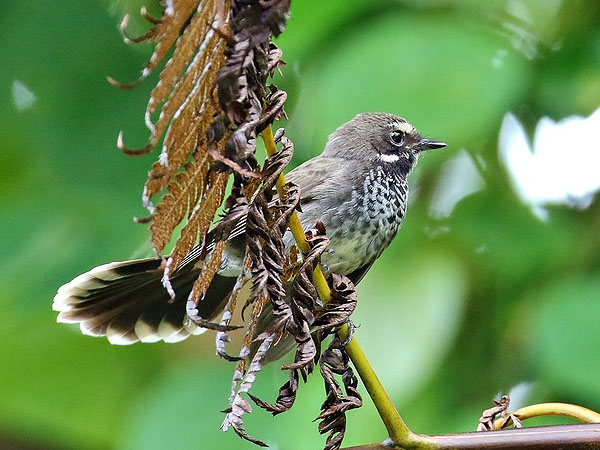
*********************
Quellen:
[1] Paul Hambruch: Nauru. Ergebnisse der Südsee-Expedition 1908-1910. II. Ethnographie: B. Mikronesien, Band 1.1 Halbband. Hamburg, Friedrichsen 1914
[2] David W. Steadman: Extinction and Biogeography of Tropical Pacific Birds. University of Chicago Press 2006
[3] Donald W. Buden: The birds of Nauru. Notornis 55: 8-19. 2008
*********************
bearbeitet: 20.03.2021
Nauru-Honigfresser (Myzomela sp.)
Diese Art (oder Unterart) mag auf der Insel Nauru vorgekommen sein, sie wird allerdings offenbar in nur einem einzigen Bericht erwähnt, und dabei handelt es sich um Erzählungen aus zweiter Hand.
Paul Hambruch, der Enthnologe der zu Beginn des 20. Jahrhunderts das Leben der Einwohner der Insel Nauru erforschte erwähnt in seinem Bericht Geschichten, die ihm von einem Einheimischen namens Auuiyeda erzählt wurden und in denen unter anderem auch von den einheimischen Vögeln die Rede ist.:
“Die Vogelwelt ist nach Zahl und Art reicher. Der Fregattvogel (Tachypetes aquila), itsi, die schwarze Seeschwalbe (Anous), doror, die weiße Seeschwalbe (Gygis), dagiagia, werden als Haustiere gehalten; der erste galt früher als heiliger Vogel, mit den beiden anderen werden Kampfspiele veranstaltet. Am Strande trifft man den Steinwälzer (Strepsilas interpres), dagiduba, den Regenpfeifer (Numenius), den Uferläufer (Tringoides), ibibito, die Schnepfe, ikirer, den Brachvogel ikiuoi, den Strandreiter iuji, die Ralle, earero bauo und zwei Möwenarten (Sterna), igogora und ederakui. Im Busche beobachtet man an den Blüten der Kokospalme den kleinen Honigsauger raigide, die Rohrdrossel (Calamoherpe syrinx), itirir und den Fliegenschnäpper (Rhipidura), temarubi.” [1]
***
Seltsamerweise gilt der Bericht als unglaubwürdig [2], was ich persönlich überhaupt nicht verstehe, denn die drei hier genannten Vogelformen (eine Ralle, ein Honigfresser und ein Fächerschwanz) sind sehr wohl aus Mikronesien bekannt und kommen bzw. kamen auf etlichen der Inseln vor.
Im Falle dieses Honigfressers mag es sich, der doch recht isolierten Lage Naurus entsprechend, um eine eigenständige Art gehandelt haben oder aber um eine Unterart des Mikronesischen Honigfressers (Myzomela rubratra (Lesson)) (siehe Foto), der in Mikronesien mit vier Unterarten verbreitet und dort eigentlich auch überall recht häufig ist.
Der Nauru-Honigfresser verschwand vermutlich aufgrund von Bejagung (der roten Federn wegen aber auch weil diese Vögel in ihrer Heimat als Delikatesse gelten) sowie in Folge der nahezu kompletten Zerstörung der Vegetation durch den massiven Guano/Phosphat-Abbau, der auf Nauru stattfand.
*********************
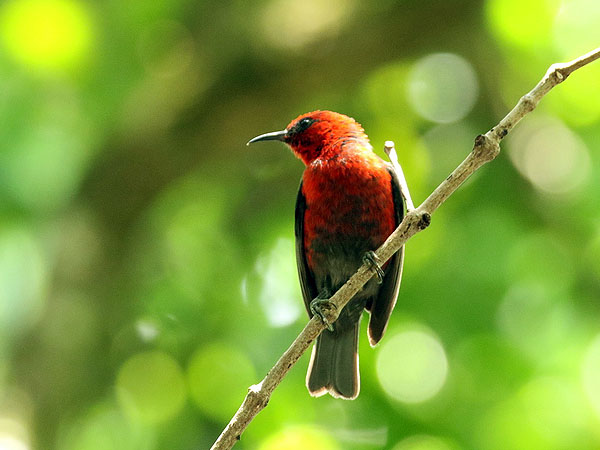
*********************
Quellen:
[1] Paul Hambruch: Nauru. Ergebnisse der Südsee-Expedition 1908-1910. II. Ethnographie: B. Mikronesien, Band 1.1 Halbband. Hamburg, Friedrichsen 1914
[2] Donald W. Buden: The birds of Nauru. Notornis 55: 8-19. 2008
*********************
bearbeitet: 20.03.2021
Wilhelmina-Paradiesvogel (Lamprothorax wilhelminae Meyer)
Der Wilhelmina-Paradiesvogel ist eine jener Paradiesvogel’arten’, die nach einem Mitglied eines der zahlreichen europäischen Königshäuser benannt wurde – in diesem Fall war dies die damalige niederländische Königin (Wilhelmina Helena Pauline Maria von Oranien-Nassau (Königin Wilhelmina 1880-1962)).
Die ‘Art’ ist nur anhand von drei (männlichen) Exemplaren bekannt, und es ist diese Tatsache, dass nahezu alle jene ‘lost birds of paradise’ [1] nur anhand männlicher Exemplare bekannt sind, die einem zu denken geben sollte. Würde es sich tatsächlich um heute ausgestorbene Arten handeln, so wären sicher einige dazugehörigen Weibchen gefunden wurden, dem ist aber nicht so, in keinem einzigen Fall! (… in den beiden Fällen in denen eine solche Form anhand eines Weibchens bekannt ist, fehlen wiederum die passenden Männchen ….)
***
Es handelt sich auch hier um eine Hybridform, und zwar mit dem Sichelschwanz-Paradiesvogel (Cicinnurus magnificus (J. R. Forst.)) und dem Kragenparadiesvogel (Lophorina superba J. R. Forst) als Elternarten. [2]
*********************
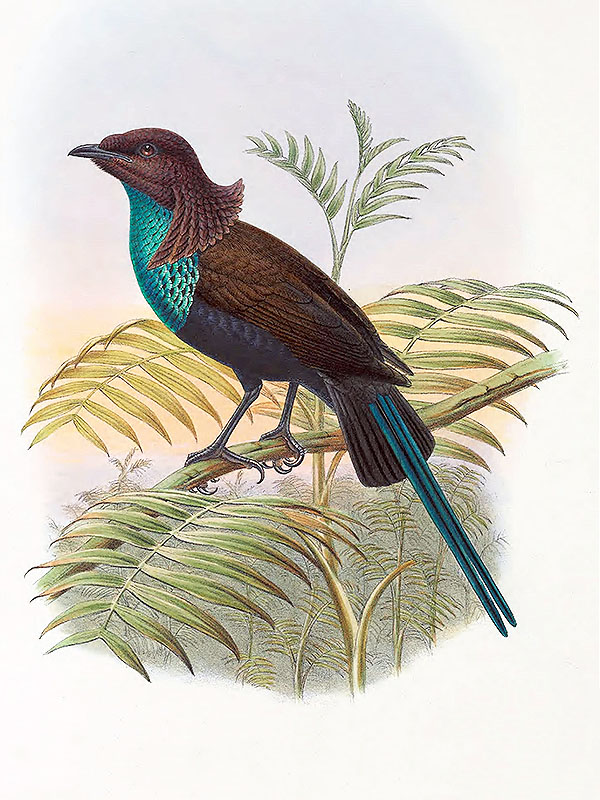
*********************
Quellen:
[1] Errol Fuller: The Lost Birds of Paradise. Airlife 1996
[2] Clifford B. Frith; Bruce M. Beehler: The Birds of Paradise: Paradisaeidae. Oxford University Press 1998
*********************
bearbeitet: 20.03.2021
Rothschilds Lappenschnabel-Paradiesvogel (Loboramphus nobilis Rothschild)
Dieser außerordentlich schöne Vogel wurde im Jahre 1901 als eigenständige Art beschrieben, nur ein einziges Exemplar ist bekannt.
Es handelt sich wohl um eine der außergewöhnlichsten Hybriden überhaupt, eine Kreuzung zweier ungemein unterschiedlicher Arten, nämlich dem Kragenparadiesvogel (Lophorina superba J. R. Forst) und der Langschwanz-Paradigalla (Paradigalla carunculata Lesson); dies ist jedoch nicht hundertprozentig klar. [1]
Einige Ornithologen halten diese Form nach wie vor für eine eigenständige, heute ausgestorbene Art.
*********************

*********************
Quelle:
[1] Clifford B. Frith; Bruce M. Beehler: The Birds of Paradise: Paradisaeidae. Oxford University Press 1998
*********************
bearbeitet: 20.03.2021